- Google News


How to write a Diversity Statement & Samples
What is a diversity statement in higher education.
- When do you need a diversity statement?
How to write a good Diversity Statement?
Diversity statement writing tips, how long should a diversity statement be, how to write a diversity statement if you are white, adapting your diversity statement to job application.
There are two types of diversity statements that are regularly used, and they are very different in terms of who is writing it, and how it is being used.
The first type of diversity statement is in relation to different types of applications in the higher education context; while the second type of Diversity Statement is in relation to the type of “diversity position” an organization position herself in the context of equity, diversity, and inclusion .
In this article, we are focusing on the first type of diversity statement which is related to the higher education sector .
Creating a diverse environment is not a top-down process, it is an environment that is co-created by the people who participate in it. In an academic environment, the people are the students, faculties, staff, senior administrators, and also the principal. In order to hire or add new members to the community, the institution typically prefers to hire or recruit new members who appreciate diversity and inclusion. A diversity statement is a form of an artifact that allows the new member to express their view on diversity.
The most common situation that you need to write a diversity statement includes:
Undergraduate and Graduate admissions Diversity Statement
Top tier schools have more student applicants than they need, so they get to be picky and select only the ones that fit their target student profile. Diversity and Inclusion views of the student have become an important factor to gauge the quality of students, such as in Law school.
Fellowship, Grants, and Awards Diversity Statement
When a graduate student wants to apply for a fellowship, it is common that a diversity statement is required as part of the application package. A fellowship provides financial support to graduate students to pursue graduate studies without associated teaching or research responsibilities (as they are in a teaching or research assistantship). Fellowships are generally merit-based internal or external awards to support a student in a full-time course of study.
Similarly, a diversity statement is often required for a grant application. Grants are need-based awards that do not need to be repaid as long as the student maintains eligibility. For certain funds, disbursement is dependent on enrollment status. Grants tend to be need-based and are available to students based on criteria such as family income. Federal and state government are the primary sources of grants, The Pell Grant is a well-known federal grant program. State-funded grants ordinarily go to students pursuing an education in that state.
Postdoctoral and Faculty Position Job Application Diversity Statement
Faculty job postings are increasingly asking for diversity statements, in addition to research and teaching statements. Diversity statements have become an integral part of the materials submitted as part of an application for employment. They are just as important as the resume, cover letter and writing sample. A diversity statement is a personal essay that is a depiction of your past experiences and explains how these experiences have contributed to your personal and professional growth. It allows the applicant the opportunity to explain to a search committee the distinct qualities and commitment s/he can bring to the table.
Promotion to Tenure position with a diversity statement
It has become more popular to list a diversity statement as a requirement for tenure promotion in higher education. A tenured post is an indefinite academic appointment that can be terminated only for cause or under extraordinary circumstances , such as financial exigency or program discontinuation. Tenure is a means of defending the principle of academic freedom, which holds that it is beneficial for the society in the long run if scholars are free to hold and examine a variety of views . A tenure assignment is an important process because it can seldom be reversed once assigned, knowing the point of view of a tenure candidate is becoming an important factor in tenure assignments.
You can write a diversity statement using a systematic approach.
- Research on the requirement
- Know your values
- Describe your experience
- Detail your future plan
- Draft, Revise, Revise, and Revise
Define your views on Diversity and Inclusion
When you write your diversity statement, you are to write what you believe. You shouldn’t write something that you don’t believe and otherwise, you are making a false statement or making a false representation of yourself. There are some questions that can help you to start.
- What do equity, diversity, and inclusion mean to you ?
- What quality of your personal experience inform your academia experience y?
- Why do you think diversity and inclusion are important and the benefits of diversity ?
- Why is diversity important to you or the classes you teach?
- in your new role of student, faculty, professor, how do you think you can help with diversity and inclusion
- Describe your values regarding diversity, inclusion, and equity in your professional life ?
- Why do you think DEI is important in Higher ed? How about in your domain?
- How do you work to ensure your classes are inclusive and welcoming to all students?
- Do you belong to any types of diversity ?
- Do you do any service or work with diverse or underrepresented populations? If so, what?
- Did you have any challenges with your gender identities ?
- Does your research connect to diversity efforts or our understanding of diverse populations? If so, how?
- Are you personally diverse in any way that might be relevant to your work? For example, were you a first-generation student, or were you a woman in STEM who aims to expands opportunities for these populations?
- What would you like to do in future departments related to diversity and equity?
After you have a good idea of how you define diversity and what diversity means to you, you can start by writing them down.
Another way to learn more about diversity is to learn what are the trending news in diversity in the workplace . You can learn the latest development of diversity and inclusion in different sectors or in the corporate world.
Describe your Diversity experience
After you draft out your beliefs and your point of views, now is your time to describe your personal experience about diversity. You can write about initiatives or actions that you have taken to promote diversity and inclusion. If you are part of a diverse group, talk about your experience and how it has impacted you.
If you have participated in any social or professional groups that promote diversity and inclusion, write about why you have decided to join such a group and the impact it has on you, and on the community.
Describe your future plan around Diversity and Inclusion
Write, review, and revise your diversity statement.
Draft, review, revise, having someone to proofread for you. I think you know what I mean.
Here are some tips on writing a diversity statement in academic or job application purposes.
Use Concrete Examples in Diversity Statements
Use actual, real examples in your life. Whether it is a mistake you realize you have made before, or you are a victim of discriminations. Tell your story with examples that the reader may be able to relate to.
Tell your own Story
Be sure you are telling your story, not generically as a group or just things you think the readers want to hear. Speak as yourself and tell your own story why you believe diversity and inclusion are important in your expected role, and how it can impact the institution or future team if diversity. If you don’t have tons of experience, then say it that you look forward to the opportunities to learn more. You don’t need to know everything, but it is an opportunity to be open-minded.
Don’t limit to your future role, think about Outreach
When you talk about your future plan to promote diversity, think about outreach, rather than reactive plans only. An example could be (if time permits), you want to join and participate in future diversity and inclusion initiatives in the new workplace. Or, how on your own, promote awareness of diversity.
Do Not Contradict yourself
Well, yes and do not contradict yourself. It is important to be admitted or get a new job, but be sure that you are telling the truth and it is really what you believe in, or what you have experienced personally.
Have a strong commitment with your diversity statement
First, check if there is a requirement of length to the diversity statement. Some applications require more serious thoughts and answers, and they need 2-3 pages to know you.
In general, I would recommend anything between 100-150 words would be enough to share your belief, experience, and future plan about diversity. It is an important topic, but a lot can be said within 150 words or 3 paragraphs.
A white person can experience diversity or even discrimination as well. Diversity doesn’t limit to a racial diversity only, it could be gender, age, and disability. You can think of the perspectives that you have experienced diversity discrimination or any other experience that you have witnessed diversity discrimination.
It is more important to show your awareness of the needs and impact of having a diverse environment and your beliefs or values on how to improve the situation.
In addition, a white person can be a champion or a leader in diversity and inclusion as well. In many cases, there are advantages in doing so.
It is not yet a popular ask for diversity statements in a job application , however, it is never a bad thing to summarize and put it on your application or resume to reflect who you are. Companies value team working and they embrace diversity in culture, work habits, age, skills, and gender. Knowing that you are ready and have experience with a diverse working environment is going to be a plus for your job application. Why not right?
What is a Diversity Statement?
The first type of diversity statement is in relation to different types of applications in the higher education context; while the second type of Diversity Statement is in relation to the type of “diversity position ” an organization position herself in the context of equity, diversity, and inclusion. more on How to write a diversity statement?
How to Write a Diversity Statement if You Are White?
A white person can experience diversity or even discrimination as well. Diversity doesn’t limit to a racial diversity only, it could be gender, age, and disability. More on this at Writing a Diversity Statement
There is not hard answer to the question. First, you should follow the requirement guidelines. Some institution may need 250 words, while some may need a 5 page essay.
More importantly, is the content. You should try the best to communicate the what, how, and your ideas to make diversity and inclusion a part of your focus in future work. Read more at How to write a great diversity statement ?
| Diversity Statements | |
| SUMMARY | |
You may also like

What Modern Athletes Have Done the Most for Diversity?
We are going to highlight a handful of athletes who make...
BAME: UK broadcasters commit to avoiding the catch-all term
BAME acronym: UK broadcasters commit to avoiding catch-all...
From our Diversity readers: Ontario in Canada a flag to represent diversity
Ontario, Canada is a province known for its diversity.

Parent-Friendly Practices for Business Sucess in SMEs vs. MNCs
How companies become more parents friendly with family...

Top Job Boards Sites for Remote, Online Jobs (High Quality)
Where to find the best online, remote, Work-at-Home, work...

How diverse is your workplace? 4 common diversity Myths
Diversity transformation
About the author
Join 34,000+ subscribers and Sign up to our Newsletter

Access to 13 certificate programs, courses and all future releases
Personal Coaching and Career Guidance
Community and live events
Resource and template library

- 9 Inspiring Diversity and Inclusion...
9 Inspiring Diversity and Inclusion Statement Examples

What is a diversity and inclusion statement?

What should a good diversity and inclusion statement include?
- Start with the actual statement. A diversity and inclusion statement is short and to the point. As such, it’s a great way to let visitors to your page immediately know your organization’s stance on DEIB.
- Add data. If you have the data on your company’s current diversity and inclusion progress, include it within your statement. This provides more tangible evidence of your DEI position. Consider, for instance, the percentage of women or people of color holding leadership positions in your organization or info about the gender pay gap (if there is one). Be transparent. There’s nothing wrong with admitting that your organization isn’t quite there yet regarding its DEIB goals. Or that you should have started working on them a bit sooner. As long as this doesn’t become a standard company line, with little intention of improving or achieving these goals.
- Specify your commitments. Define your commitments, whether in brief or expansively. In the examples included, some companies published their main DEIB commitments with an in-depth description of each initiative. Others preferred brevity when describing their DEI commitments.
- Add resources that enrich your DEI statement. Some (large) organizations have resources they use to help support their DEI work that they include on their DEI statement page. Consider including documents on representation and pay, workforce diversity reports, racial equity strategies, etc. Additionally, including employee or candidate testimonials can further enrich the statement.
- Ensure your website is accessible. Inclusivity shouldn’t just extend to the workplace, but also across your owned media. Ensure that your webpage has been developed to be accessible to people with different needs/preferences and disabilities and that it meets the Web Content Accessibility Guidelines .
9 Inspiring diversity and inclusion statement examples
1. workday .
What we like about this statement
DEI statement top tip Connect your DEI statement to your company’s mission and goals.
What we like about this statement
DEI statement top tip Formulate a powerful title for your diversity and inclusion statement.
4. T-Mobile
DEI statement top tip Make your DEI statement evocative by including emotive words that help bring your words to life.
What we like about this statement
DEI statement top tip Consider your target audience when writing your DEI statement. Does your company prioritize its internal audience (your employees) as well as the external audience (communities, customers, suppliers, etc.,)? Your DEI statement should speak directly to these audiences instead of in general terms.
6. Target
DEI statement top tip If possible, link your company values/purpose to a broader societal purpose.
7. Spotify
DEI statement top tip A DEI statement is a serious and public commitment, but it doesn’t have to be dry and unimaginative. Personalize your DEI statement to your brand by using language that illustrates what your company does.
DEI statement top tip Include information to back up your DEI statement. Do you have a DEIB initiative that you are particularly proud of or areas you are making great strides? Take the opportunity to showcase these on the DEI statement page. Statistics indicating your progress are compelling when illustrating what you as an organization are achieving.
DEI statement top tip Don’t be afraid to be transparent about your DEI progress as an organization.
9. LEGO Group
DEI statement top tip If relevant, link your DEI statement to your company’s future vision and goals. These goals can be internally or externally focused but must be related to developing diversity, equity and inclusion.
How to write a DEI statement: Best-practice principles

- Come up with a strong title . This doesn’t mean you need to spend hours developing a clever title. But try to have something other than ‘Diversity and Inclusion at X’ as your title. ‘Adobe for All’ is an excellent example of a strong title that says it all without being too creative. Spotify’s ‘Don’t just work here. Belong here.’ is another original title.
- Keep things short and sweet. Try to encapsulate the essence of your organization’s DEI mission statement in one or two sentences. Both the T-Mobile and Nike examples have done this very well.
- Link it back to your mission & values. This is something that we see in almost all of this article’s diversity and inclusion statement examples. Workday, Target, and LEGO Group (among others) have achieved this well.
- Consider your target audience. Based on your company’s DEI goals, consider who you as a company is targeting. Are you internally focused on your employees, or has your company also prioritized the social communities, your customers and your suppliers? Highlight your target audience when crafting your DEI statement.
- Add your company’s unique view. Adding your organization’s unique sauce to the DEI statement is one of the things that can set you apart. This could be achieved through including company-specific language (as used in the Spotify, LEGO, and Nike examples), but also conveyed through your sincerity (such as HubSpot and Adobe) or in the form of specific focus areas (as with Boots and its focus on its employees). Importantly, it should reflect your company’s identity.
- Be honest. Sounds obvious? Perhaps it is. But with so many eyes on your organization’s DEI statement (employees, candidates, customers, business partners, etc.), it can be tempting to write something that paints an unreal picture of your actual DEI status. Being honest about where you are and where you want to be will ring truer within the marker.
On a final note
Weekly update.
Stay up-to-date with the latest news, trends, and resources in HR

Neelie Verlinden
Related articles.
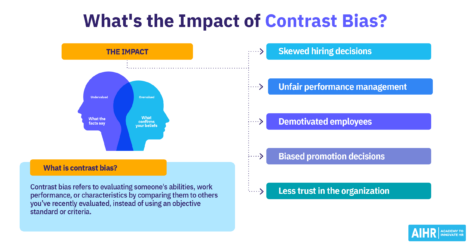
Contrast Bias: Everything HR Professionals Must Know

Nepotism in the Workplace: Identify 6 Toxic Signs

Favoritism in the Workplace: How To Spot and Prevent It
New articles.

Salary Benchmarking Guide: How To Pay Your Employees Fairly
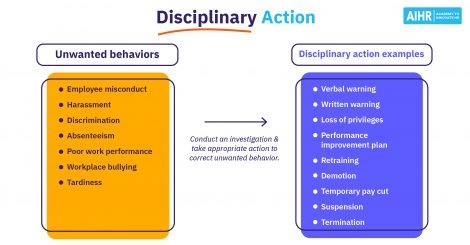
Disciplinary Action at Work: An HR’s Guide [+ FREE Form]

What Is Job Enlargement? [A Guide + 3 Examples]
Subscribe to our weekly newsletter, are you ready for the future of hr.
Learn modern and relevant HR skills, online

- AI Content Shield
- AI KW Research
- AI Assistant
- SEO Optimizer
- AI KW Clustering
- Customer reviews
- The NLO Revolution
- Press Center
- Help Center
- Content Resources
- Facebook Group
Writing an Effective Diversity & Inclusion Personal Statement
Table of Contents
Diversity and inclusion in higher institutions have become more important as the world becomes more connected and diverse. They are paramount values for any university to embrace and promote. As an undergraduate or graduate program applicant, a diversity and inclusion personal statement is a powerful tool. Such a statement can demonstrate your commitment to these values and your desire to contribute to a more diverse and inclusive community.
Diversity and inclusion create a more welcoming and inclusive environment for all students, regardless of their background or identity. This article explores the importance of diversity in and provide tips for writing a strong personal statement on this topic.
What Is a Personal Statement?
A diversity and inclusion personal statement is a statement that is required as part of a university application. It is an opportunity for applicants to discuss their personal experiences and perspectives on diversity and inclusion. And how these issues have influenced their lives and goals.
Your personal statement should demonstrate your understanding of the subject and how you have engaged with these issues in the past. It can also focus on your own cultural or personal background, interactions with diverse groups and communities. And how it shaped your perspective on diversity and inclusion.
How Long Should a Diversity Statement Be?
The length of a diversity personal statement for a university varies depending on the program’s specific requirements and the school. However, generally, a university program’s personal statement should be around 500-700 words.
Some universities or programs may have a specific word or page count that you need to adhere to. Always read the guidelines provided by the university and follow them closely.
How to Write a Diversity and Inclusion Personal Statement?
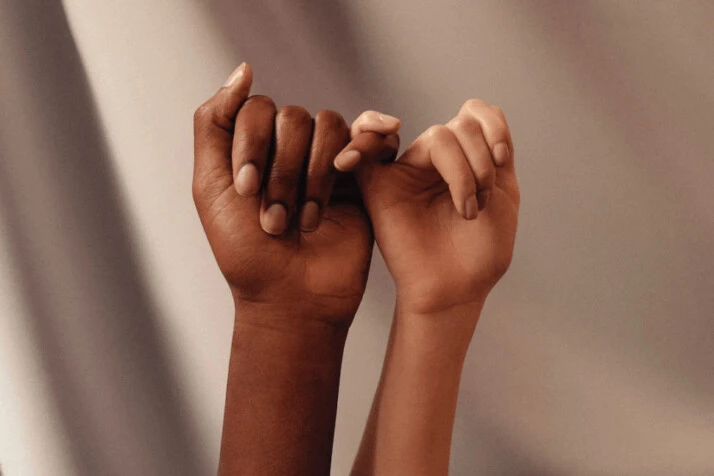
A diversity personal statement allows you to share your personal experiences and perspectives on the subject . Your statement must be clear and exciting enough to move the reader to action.
Here are some tips for writing a solid and effective diversity and inclusion personal statement:
1. Start by Reflecting on Your Experiences With Diversity and Inclusion.
Think about personal experiences shaping your views on diversity and inclusion. This could be experiences with discrimination or inequality, as well as experiences that have helped you appreciate the value of diversity.
2. Review the Values and Goals of the University You Are Applying To.
Think about how your experiences and perspectives align with their values and goals. And how you might contribute to their efforts to promote diversity and inclusion.
3. Reflect on Your Strengths and Skills.
When promoting diversity and inclusion, what specific skills or strengths do you bring to the table? How have you used these skills previously, and how could you use them to make a positive impact in the future?
4. Use Examples to Illustrate Your Points.
Do not make general statements about your commitment to diversity and inclusion. Instead, provide specific examples of how you have demonstrated this commitment in the past. This will help make your statement more catchy, engaging, and convincing.
5. Finally, Edit and Revise Your Statement Carefully.
Take the time to proofread and review your personal statement to ensure it is well-written and error-free.
What and What Not to Include in Your Diversity Personal Statement
Here are some key details to consider including in your diversity and inclusion personal statement:
- Your personal experiences . Share personal experiences that have shaped your views on diversity and inclusion. They may be experiences with discrimination or inequality, as well as experiences that have helped you appreciate the value of diversity.
- Your skills and strengths . Write any specific skills or strengths you bring to promote diversity and inclusion. These could include things like leadership, communication, or problem-solving skills.
- Illustrations of your commitment . Provide examples of how you have demonstrated your commitment to diversity and inclusion in the past. These could include involvement in organizations or initiatives focused on diversity and inclusion or specific actions you have taken.
- How your experiences and goals align with the university . You can also explain how your experiences and goals align with the values and goals of the university you are applying to. And how you might contribute to their efforts to promote diversity and inclusion.
Here Are Some Key Details to Avoid in a University Diversity Personal Statement:
- General statements . Avoid making general statements about your commitment to diversity and inclusion without providing specific examples or details.
- Negative or foul language . While it’s important to address issues of discrimination and inequality, it’s best to avoid using harmful or offensive language.
- Unnecessary personal information . Avoid including unnecessary personal information that does not directly relate to your commitment to diversity and inclusion.
- Overly broad statements . Be specific and direct in your statement.
Examples of Diversity and Inclusion Personal Statement
Diversity and inclusion have been central tenets of my life since I first started engaging with the world around me. In all aspects of my work, education, relationships, and advocacy, I have strived to create a more equitable and inclusive environment for everyone.
I am an experienced advocate for marginalized populations and those whose voices are not often heard. For example, during college, I worked as part of a campus organization that fostered diversity among students from varying backgrounds. We organized programs designed to help bridge cultural divides and connect individuals who might otherwise be isolated from each other. Through this experience, I clearly understood how important it is to amplify minority perspectives and empower people to speak up for themselves.
It is also essential to create a sense of belonging for members of traditionally underrepresented groups. This has always been at the forefront of my mind when teaching or mentoring. I strive to ensure all voices feel respected and validated.
Additionally, my research into community-based initiatives that promote equal access to educational resources has shown me the impactful results of such efforts.
I’m passionate about creating more significant opportunities and expanding access to existing ones. As someone who has seen the difference this can make in people’s lives, it has become a goal to continue advocating for inclusion. Whether that means leading workshops on empowerment strategies or working with organizations to implement practical solutions – I look forward to continuing down this path.
I have been deeply invested in diversity and inclusion for years, a passion fueled by my experiences as a member of various marginalized communities. Growing up as an immigrant in an American school system, I often felt like an outsider. This created a sense of empathy for those who are discriminated against or excluded. This experience has given me great insight into how vital it is to create diverse and inclusive environments in our universities.
I am proud to say that over the past few years, I have actively worked towards making education more accessible and equitable. This is through my involvement with numerous outreach programs. I have been engaging in student mentorship initiatives and advocating for affirmative action policies. This is in my strive to increase opportunities for underrepresented populations to attend higher-education institutions.
Furthermore, I firmly believe that an effective way to ensure equity within our universities is to prioritize multicultural dialogue across all departments. We can combat marginalization and foster meaningful conversations about inclusion by ensuring a safe space where different voices can be heard.
Diversity and inclusion efforts must go beyond simply implementing new policies; they must become part of the fabric of each institution’s culture. As someone well-versed in academics and activism, I understand the importance of leveraging research to inform practice. My expertise lies in data collection, analysis, and policymaking. This allows me to provide solutions that respond to the nuances of institutional cultures. Through evidence-based approaches, and targeted interventions, I am committed to creating sustainable change around issues of diversity and inclusion.
I have spent the past several years dedicating myself to the cause of promoting and furthering diversity and inclusion initiatives in the university setting. My experience working closely with students, and administration alike has given me a nuanced understanding of how best to achieve meaningful progress. In particular, I have been particularly successful at developing resources and events that help foster an inclusive environment on campus. For example, I recently developed a student organization dedicated to bridging cultural divides through dialogues and activities.
I believe that lasting change must go beyond mere rhetoric–it must be backed up by tangible action. Therefore, my approach to achieving greater inclusion involves more than just increasing awareness. I strive to create visible and invisible structures supporting diverse individuals’ growth. This means providing additional institutional resources, encouraging open dialogue among members of different backgrounds, and creating innovative solutions to challenging issues.
In addition, I firmly believe that it is essential to be mindful of how language can unintentionally contribute to exclusionary practices. As such, I employ a culturally-sensitive communication style when speaking or writing about subjects related to diversity and inclusion.
Above all else, I recognize that having conversations around these topics isn’t enough. It’s important to remain actively engaged with them so that real progress can be made over time.
Wrapping Up
Diversity and inclusion are crucial aspects of the university experience. They help to create a welcoming and supportive environment for all students. In a university environment, you come in contact with diverse individuals you need to engage with.
Your statement is the chance to showcase how your experiences and perspective will help you embrace everyone. This is without minding who they are and where they are from.

Abir Ghenaiet
Abir is a data analyst and researcher. Among her interests are artificial intelligence, machine learning, and natural language processing. As a humanitarian and educator, she actively supports women in tech and promotes diversity.
Explore All Write Personal Statement Articles
How to draft meaningful length of law school personal statement.
Are you confused on how to write a law school personal statement? One of the essential elements of your application…
- Write Personal Statement
Effective History and International Relations Personal Statement to Try
Are you considering studying history and international relations? Or you may be curious about what a degree in this field…
Guide to Quality Global Management Personal Statement
Are you applying for a global management program and want to stand out from the crowd? A well-written personal statement…
How to Draft Better Examples of Personal Statements for Residency
Achieving a residency can be a massive accomplishment for any aspiring medical professional. To secure your spot in one of…
Tips for Drafting a Free Example of Personal History Statement
A personal history statement can be crucial to many applications, from university admissions to job search processes. This blog will…
Writing Compelling Dietetic Internship Personal Statement
Applying for a dietetic internship is a rigorous process and requires submitting a personal statement, which is an essential part…
- Explore Majors
- Explore Careers
- Become Career Ready: Skills Employers Seek
- Write a Resume, CV, or Cover Letter
- Network with Professionals
- Prepare for an Interview
- Gain Experience
- Find an Internship or Co-op
- Prepare for Graduate School
- Faculty & Staff
- Parents & Families
- Career Champions
- Agriculture, Animals, Food, and the Environment
- Arts, Media, and Communication
- Business, Finance, Sales, and Marketing
- Doctoral Degree
- Education and Sports
- Government, Public Administration, and Law
- Healthcare and Wellness
- Innovation and Entrepreneurship
- Let’s Explore
- Non-profit, Social Service, and other Careers for the Common Good
- Science, Data, and Technology
- Sustainability, Conservation, and Energy
- What are Affinity Communities
- Asian and Asian American Community
- Black Community
- First-Generation Students
- International Students
- Latine Community
- Middle Eastern and North African Community
- Native and Indigenous Community
- Neurodiverse Community
- Religiously Affiliated
- Students with Disabilities
- Undocumented and DACAmented Students
- Veterans and Service Members
- Request a Workshop
- Request a Class Assignment
- Career Events
- Career Fairs
- On-Demand Webinars
- Special Events & Series
- Events for Graduate Students
- Outcomes Data Collection
- Undergraduate Student Outcomes
- Our Vision, Mission, and Values
- Awards, Presentations & Memberships
- Professional Staff
- Graduate Assistants
- Student Interns
- Student Ambassadors
- Work at the Center
5 Tips for Writing a Diversity Statement
- Share This: Share 5 Tips for Writing a Diversity Statement on Facebook Share 5 Tips for Writing a Diversity Statement on LinkedIn Share 5 Tips for Writing a Diversity Statement on X

Diversity statements provide applicants an opportunity to explain their commitments and experiences with diversity. They are personal essays (about 1-2 pages in length) that depict past experiences and explain how those have contributed to your personal and professional development. This statement allows applicants to explain their understanding of the barriers faced by under-represented individuals, as well as their own experiences meeting the needs of diverse populations.
Why do employers ask for diversity statements?
It has become more common for employers to request a diversity statement. This document is just as important as the résumé, cover letter, and any other written statement. An employer who requests a diversity statement is most likely committed to inclusivity and supports diverse populations. They may be looking to hire someone who aligns with their values and is committed to diversity as well.
Where should you start?
It may be your first time writing a diversity statement and you may have no idea where to start. Luckily, we have compiled a list of 5 tips to help you get started!
1. Do some background research!
- Terminology – Here are some words to consider learning about before you start writing: diversity, equality, equity, inclusion, social justice. It’s a good idea to become familiar with these words if you aren’t already and think about how you can incorporate them into your statement. There are also many identities to consider referencing or writing about in your statement. They could include (but are not limited to) race, ethnicity, gender identity, gender expression, sexual/romantic orientation, country of origin/citizenship, socioeconomic status, age, ability, and religion.
- Company’s Diversity, Equity, and Inclusion Mission – It is important to learn what is important to the particular company you are applying to and see if you can align your values, or mention that you value what their company is working on in regards to diversity, equity, and inclusion. This information can often be found on the company website, social media, or news outlets.
2. Share your personal story
You can and should use your past experiences to explain how you can best empathize with others who confront challenges. Think about how you have contributed to diversity in your past. Here are some questions to consider: Have you worked with diverse or underrepresented populations? How do you embody diversity? If you have had to overcome obstacles to get to where you are today, don’t be afraid to talk about it. It’s your statement and you want it to be a reflection of who you are and what your character is.
3. Be concrete, use specific examples
Mention specific experiences that have allowed you to contribute to enhancing diversity & inclusion. If you have been involved in any organizations or programs that are committed to diversity, you should talk about your experience. Any rewarding experiences will help strengthen your statement.
4. Connect your personal/professional mission to your diversity statement
Think about how your values relate to your understanding and commitment to diversity. What is most important to you and how does that tie into your statement? Do you value inclusivity and equity? Connecting your diversity statement to your mission will show employers how you are unique and committed.
5. Discuss future plans
What is your plan to contribute to enhancing diversity in the future? How will you enact your values related to diversity and inclusion in your work at the company you are applying for? If you have no past experiences with diversity, here’s where you can dive deep and explain your willingness to contribute to diversity moving forward.
If you have questions about composing a diversity statement, you can schedule an appointment with a career coach to discuss and review!
Office Hours: 8AM – 5PM Career Coaching Hours: 8AM – 5PM * Evening appointments vary by semester. * If you require an accommodation to utilize any resource or to participate in any event, please contact our office.
(860) 486-3013 career@uconn.edu
Center for Career Development Wilbur Cross Building, Rm 202 233 Glenbrook Road U-4051 Storrs, CT 06269
- Find a company
Shaping the future of work: the role of diversity statements in job applications
Jun 01, 2023

Freelance writer
In the sea of job applications, standing out from the crowd can feel daunting. However, there’s a new tool in the modern jobseeker’s kit that can help set you apart: the diversity statement. As our global society becomes increasingly diverse, organizations are placing a premium on fostering inclusive environments. Consequently, a well-crafted diversity statement can play a pivotal role in your job application and interview process.
A diversity statement is a powerful personal essay that allows you to share your unique experiences and insights about diversity, equity, and inclusion (DEI). More than just an add-on to your cover letter and resume, this statement can illuminate your commitments to DEI, highlight your understanding of the barriers in the current job market, and showcase how you can contribute to an equitable and diverse workplace.
Because including a diversity statement is not always required in an interview process, and is a relatively new way for applicants to showcase themselves, the guidelines for perfecting it aren’t so obvious. Luckily, we’ve done the research for you and asked some DEI experts to weigh in and give some tips and insights for creating the best diversity statement possible.
Crafting your diversity statement
Before delving into the specifics of writing a diversity statement, it’s crucial to understand a few fundamental considerations. A well-written diversity statement should clearly define your understanding of diversity and how it has shaped your personal and professional journey . It should offer concrete examples from your past roles or experiences where you’ve contributed to fostering diversity and inclusion. Moreover, it should delineate your future plans to further nurture DEI values in your career .
Clarify what you mean by diversity
You may or may not define your terms in the actual statement itself, but it should be clear what you mean by diversity and how it relates to you and your personal journey. What does diversity mean to you personally? How has the concept of DEI been incorporated into your personal or professional past?
Share relevant past experiences
Including specific ways in which you have helped a company develop or have grown yourself in a previous role or experience should be a main talking point in your diversity statement. This is a good way to avoid seeming as if you are generalizing, which might come across as disingenuous . Why are you committed to diversity? What kind of life experiences prompted your commitment?
Include plans for the future
Another way to be specific in your diversity statement is to explain how you plan to use past experiences to grow even further. This demonstrates not only an understanding of diversity in the workplace but a future commitment to learning and expanding both personally and professionally.
The benefits of creating a diversity statement
Renowned throughout education circles for its commitment to diversity, Shenendehowa School District in New York houses its own Diversity, Equity, and Inclusion Committee. It’s focused on preserving equity and fostering diverse and inclusive environments where every student feels connected , ensuring the provision of an anti-bias and anti-racist education. Dr. Elizabeth Wood, the Assistant Superintendent of Shenendehowa Central School District, is considered a leader in her field when it comes to DEI in the workplace. She shares her insights on what applicants can include in their diversity statements to stand out in the interview process , as well as some tips and background on the importance of diversity statements in the hiring process.
Showcase your values concretely
Value alignment is more important than ever for job hunters across the US, and by including a diversity statement in your application, you can highlight your values from the get-go. It helps you show employers early on what’s important to you . “It reveals important information about the humanity, character, and commitment of the candidate,” Dr. Wood states. If you’re looking for a company that supports DEI initiatives and this is a non-negotiable for you, a diversity statement could be exactly what you need.
Set yourself apart from the competition
It’s no secret that today’s job market is fiercely competitive. Every single applicant is looking for a way to stand out from the crowd. Diversity statements can help you do just that. However, Dr. Wood recommends not relying solely on the statement to set yourself apart : “I look for service to DEI organizations or accomplishments listed on the resume that highlights diversity,” she explains. “Statements on the application or resume are important too if they indicate more than a trite or superficial commitment to DEI.”
Additionally, Dr. Wood says it’s important to create a statement that is relevant to the field in which you’re applying , and to proceed with care and attentiveness when it comes to diversity. “You can only do this if it’s sincere and doesn’t inappropriately stereotype a cultural group,” she shares.
Including a diversity statement in an application can be a great way for a potential candidate to stand out and showcase their commitment to DEI, by sharing both relevant past experience and future goals. It’s important for applicants to be honest , both about where they are coming from and how they wish to contribute.
The impact of a diversity statement
A compelling diversity statement has the potential to transform your job application from a simple document to a dynamic representation of your personal and professional commitments to diversity, equity, and inclusion. It is a platform to not only relay your beliefs and experiences but also project your future vision and intentions of fostering an inclusive and equitable workplace environment . As we navigate through an increasingly diverse global society, your understanding and engagement with DEI principles can mark you as a visionary and empathetic leader in your field.
Remember, a diversity statement is not just a trendy add-on. Instead, it’s a powerful tool that can resonate with prospective employers, demonstrating your sincerity and dedication to building an inclusive world.
Key takeaways
- Define diversity: Start by clearly defining what diversity, equity, and inclusion mean to you. Make it personal, sharing how these concepts have been part of your life journey and why they matter to you.
- Highlight past experiences: Illustrate your commitment to DEI by sharing specific experiences where you have promoted diversity and inclusion, whether in previous roles, community service, or personal life.
- Map the future: Show your commitment isn’t just rooted in the past. Share your plans for promoting DEI in the future, showcasing a proactive attitude towards continuing your growth and contribution in this field.
- Align your values: Use your diversity statement as a platform to highlight your values. Show potential employers that you prioritize DEI and are seeking a workplace with similar commitments .
- Stand out authentically: Make your diversity statement a standout feature of your application. However, ensure your commitment to DEI comes across as genuine and deep-rooted, not superficial or clichéd.
- Respect cultural differences: In your efforts to display a commitment to DEI, be cautious not to stereotype or misrepresent cultural groups. Be respectful, understanding, and mindful of cultural sensitivities.
A well-crafted diversity statement can be a competitive edge in your job application, setting you apart as a forward-thinking, empathetic candidate who understands the value of DEI in the modern workplace. Use this tool wisely, and it may become the key that unlocks your next career opportunity.
Photo: Welcome to the Jungle
Follow Welcome to the Jungle on Facebook , LinkedIn , and Instagram , and subscribe to our newsletter to get our latest articles every day!
More inspiration: Applying for jobs

Should you be scared of the ghost job trend?
Have you ever been ignored after applying for a job? You may be a victim of the ghost job trend.
Jun 12, 2024

Lost in translation: Decoding bizarre job descriptions
“Candidates with no sense of humor need not apply.” Um …
Jan 25, 2024
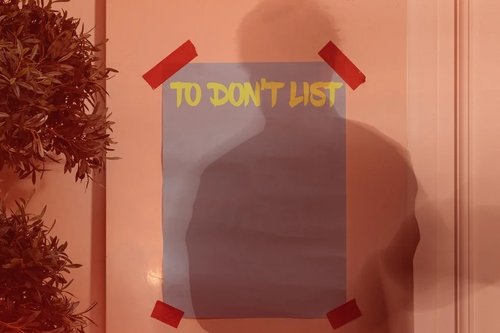
Nailing your job search: Writing a to-don’t list for success
Don’t want this, don’t want that … Writing down things you want to avoid in a new job could be your job-hunting key.
Jan 18, 2024

Maximizing your references: Turning recommendations into opportunities
No more asking friends for fake references. Here’s how to get it right and land the job!
Dec 19, 2023

Love bombing: Are overenthusiastic recruiters friends or foes?
TikTok has warned us about love bombing in dating, but what about when it happens on the job hunt?
Nov 16, 2023
The newsletter that does the job
Want to keep up with the latest articles? Twice a week you can receive stories, jobs, and tips in your inbox.

Looking for your next job opportunity?
Over 200,000 people have found a job with Welcome to the Jungle.
- Utility Menu
GA4 Tracking Code

fa51e2b1dc8cca8f7467da564e77b5ea
- Make a Gift
- Join Our Email List
- Diversity Statements
Though an increasing number of faculty search committees now ask candidates to submit diversity statements, guidance about how to compose an effective statement—indeed, even about what they are and why they can be valuable to institutions and candidates’ own professional development—remains scarce. You may think that diversity statements require you to locate diversity within your own social identities. You can, of course, note how your identities and life experiences motivate your commitment to diversity. However, beyond your motivation, universities and colleges want to know what you have accomplished in your career to this point and how you will contribute to their goal of making their institutions more inclusive and equitable. The most compelling diversity statements offer your definitions of equity, diversity, inclusion, and belonging (EDIB) and demonstrate how your research, teaching, and service actualize your EDIB goals.
Schedule a consultation on your diversity statement (Harvard FAS affiliates only) Download our "Composing Your Diversity Statement" worksheet
What is a Diversity Statement?
A diversity statement is a polished, narrative statement, typically 1–2 pages in length, that describes one's accomplishments, goals, and process to advance excellence in diversity, inclusion, equity, and belonging as a teacher and a researcher in higher education.
The Building Blocks of a Diversity Statement
The following categories are core components of diversity statements. Effective diversity statements will address each of the following areas and answer some, if not all, of the associated questions.
- Defining your values
- Demonstrating your competency
- Evidencing EDIB in your research, teaching, and service
- Proposing future action
Equity, diversity, inclusion, and belonging (EDIB) are defined in multiple ways across and within institutions. The mission for this component of your statement is to define how you understand these terms and identify your EDIB priorities.
- How do you define equity, diversity, inclusion, and belonging (EDIB)?
- What animates your approach to EDIB work in higher education?
- How do the principles of EDIB relate to your values, approaches, and goals as a scholar and teacher?
> Download a copy of our "Composing Your Diversity Statement" worksheet
EDIB practices, in part, emerge from scholarship that researches the following: (1) the benefits and significance of diversity in higher education; (2) the obstacles and oppression that people who hold marginalized social identities face in higher education; (3) the processes for creating research and learning environments that benefit everyone. The mission for this component of your statement is to highlight your awareness of these conversations and show where your EDIB practices engage with them.
- How do you regularly account for and address your privilege, bias, and EDIB learning edges?
- Can you demonstrate knowledge of key EDIB terms (e.g., equality vs. equity; anti-Blackness; race vs. ethnicity; non-binary; DACA; neurodivergent and neurotypical)
- Do you know how the following operate in the academy: implicit bias, different forms of privilege, (settler-)colonialism, systemic and interpersonal racism, homophobia, heteropatriarchy, and ableism? Can you identify how those factors currently and historically impact marginalized populations in your discipline?
EDIB refers to values, goals, processes, assessments, and outcomes. The mission for this component of your diversity statement is to provide examples of your processes and assessments for attaining your EDIB goals in your research, teaching, and service.
- How does your research promote or advance equity and inclusion?
- How does your research engage with and advance the well-being of socially marginalized communities?
- How does your research acknowledge or interrogate power and privilege?
| Example EDIB Value and Definition | Inclusion: “Everyone is included, visible, heard, and considered” |
| Example of an Inclusive Research Goal | Draft a book manuscript that is inclusive to the multiple voices within and beyond the discipline |
| Example of an Inclusive Research Process | |
| Example of Inclusive Research Assessments |
- What strategies do you use to respond to the needs of students who are diverse in terms of race, ethnicity, gender, socioeconomic status, age, nationality, sexual identity, ability, and religion?
- How do you facilitate challenging conversations on race, ethnicity, gender, socioeconomic status, age, nationality, sexual identity, ability, and religion? What are the benefits and outcomes of your approach?
- What EDIB theories and approaches do you draw from when teaching (e.g., critical inclusive pedagogy, anti-racist pedagogy, decolonial pedagogy, feminist pedagogy, universal design for learning, active learning)?
- How do you account for the power dynamics in the classroom, including your own positionality and authority?
- How do you design course assessments with EDIB in mind?
- How have you solicited feedback about your EDIB pedagogy from students? What did you learn? How did you incorporate their feedback, and what were the outcomes?
| Example EDIB Value and Definition | Inclusion: “Everyone is included, visible, heard, and considered” |
| Example of an Inclusive Teaching Goal | Create classes where students of all social identities can successfully learn and create knowledge |
| Example of an Inclusive Teaching Process | |
| Example of Inclusive Teaching Assessments |
- How have you engaged in or led EDIB campus initiatives or programming? What did you accomplish? What did you learn? What skills or knowledge did you build in the process?
- Have you engaged in or led other EDIB service beyond your institution? What did you accomplish? What did you learn? What skills or knowledge did you build in the process?
- How has your past participation in EDIB service or activities prepared you to successfully take on your next position?
- How do you measure the success of your EDIB work?
| Example EDIB Value and Definition | Inclusion: “Everyone is included, visible, heard, and considered” |
| Example of an Inclusive Service Goal | Create an inclusive workshop series on hacking the discipline from the point of view of FGLI students |
| Example of Inclusive Service Process | |
| Example of Inclusive Service Assessments |
Your diversity statement should not only showcase the EDIB work you have already accomplished but show how you integrate feedback and assess institutional needs to plan your future EDIB goals.
- How do you plan to continue advancing inclusive excellence, diversity, or equity in your research, teaching, and service?
- How do you solicit and respond to EDIB feedback from a range of academic communities?
- How do your future EDIB goals align with your target institution's EDIB mission and needs?
Some Final Tips and Advice
Some don’ts
Don’t (over)rely on self-disclosure. While you may choose to disclose the social identities you hold while narrating what motivates your commitment to EDIB work, your diversity statement should focus on the work you have done and will do to create diverse, inclusive, and equitable spaces of higher education. A diversity statement is about your commitment to furthering EDIB within the context of institutions of higher education, not about cataloguing everything virtuous you’ve ever done to prove that you’re an ally to a marginalized group. Also, never feel compelled to emotionally bleed for a search committee. Keep in mind that some diversity statement prompts may let you know what they prefer in terms of self-disclosure. For example, the University of Wisconsin-Madison’s published guidelines to writing a diversity statement emphasize their desire for candidates who share the institution’s commitment to inclusive excellence, “regardless of personal demographic characteristics.”
Beware of false equivalencies. A personally challenging circumstance or series of events is not equivalent to holding a marginalized social identity throughout your lifetime. Similarly, the experiences of having one socially marginalized identity are not the same as the experiences of having a different marginalized social identity.
Don’t use “diversity” to refer to a BIPOC individual or a homogenous BIPOC community. Diversity does not mean a BIPOC individual or a homogenous BIPOC community. Diversity refers to the condition when individuals or communities from different backgrounds, cultures, frames of reference, social identities, or perspectives come together in a social context. It does not refer to a person (including yourself) or a homogenous community who experiences marginalization.
Don’t tailor every statement. Your diversity statement should demonstrate how you have and would effectively plan to promote diversity, equity, inclusion, and belonging across contexts, with clear EDIB objectives, expected outcomes, and forms of assessment. Your cover letter is the place for you to tailor your EDIB discussion, possibly referencing institutional contexts and departmental missions while describing specific initiatives you could plan and mentioning potential collaborations with centers and committees.
Learn more about the EDIB challenges and goals of institutions. Before you draft your diversity statement, take time to research a range of websites from the institutional offices of diversity, equity, and inclusion at the universities, colleges, and departments to which you may apply. Note any recurring EDIB challenges and goals, and consider how your experiences and skills might address their needs and further their initiatives.
Show your process. Avoid only stating your belief in EDIB principles without showing methods for attaining your EDIB goals. Additionally, you can also demonstrate how your process reflects your EDIB principles. For example, if decolonizing your pedagogy is your EDIB goal, your process to achieve this may be to revise the readings on your syllabus to include voices outside of the traditional canon. To make the process align with your decolonial approach, you might solicit feedback from students on the readings and curriculum rather than unilaterally selecting the required readings yourself.
State your outcomes and lessons learned. The strongest diversity statements show what you accomplished with your initiatives and how you learned from feedback. Be mindful to state any skills or knowledge you acquired.
Connect your EDIB practices with evidence. Evidencing the effectiveness of your EDIB practices can come from your own assessments and can also be bolstered by the research of scholars who have qualitatively or quantitatively assessed the EDIB practices you utilize.
For more information...
Why I'm a Convert to Diversity Statements (Inside Higher Ed)
The Effective Diversity Statement (Inside Higher Ed)
Demystifying the Diversity Statement (Inside Higher Ed)
Framework for Diversity Research & Scholarship (National Center for Institutional Diversity, University of Michigan)
Sara P. Bombaci and Liba Pejchar, "Advancing Equity in Faculty Hiring with Diversity Statements"
Becoming an Anti-Racist, Equity-Minded Educator (Amherst College Center for Teaching and Learning)
Guidelines for Writing Your Diversity Statement (University of Wisconsin-Madison)
- Designing Your Course
- In the Classroom
- Getting Feedback
- Equitable & Inclusive Teaching
- Advising and Mentoring
- Teaching Portfolios
- Teaching Statements
- Teaching as an Aspect of Promotion and Tenure
- Teaching Awards
- Teaching Remotely
- Tools and Platforms
- The Science of Learning
- Bok Publications
- Other Resources Around Campus
Which program are you applying to?

Accepted Admissions Blog
Everything you need to know to get Accepted

July 29, 2018
Writing the Diversity Personal Statement
One of the many challenges of applying to college or graduate school is showing the admissions committee how you’ll fit in and stand out . Adcoms are trying to build student bodies that will work cohesively towards shared goals and ideals, but that come from different backgrounds and with different ideas so that the combined educational, social, and professional experience is rich with diversity. How will you contribute to your target school’s diversity? How will you express that diversity in a compelling personal statement?
Full video transcript
You are applying to top graduate and professional schools and you’re stumped: You have to write the dreaded Diversity Essay . How can you do so when you aren’t a member of an underrepresented minority and haven’t overcome serious social ills?
Classic diversity question: How will you contribute to the diversity of our class or community?
Problem: You are a member of an overrepresented (or at least well-represented) group in the applicant pool. You assume that only members of underrepresented minorities or those who have overcome significant socioeconomic challenges can effectively answer this type of question.
You’re frustrated because why should accidents of birth influence whether you are accepted or rejected? They don’t reflect on your qualifications at all. They shouldn’t lead to rejection and keep you from pursuing your dreams.
At Accepted, where we help applicants get accepted to their dream school, we know how frustrating this situation can be.
But we’ve developed a 3-part framework that will help you broaden your thinking about diversity so that you can write a persuasive diversity personal statement, even if you are from an overrepresented group.
3 IDs of Diversity
• ID entity • I D ids or deeds • ID eas
Identity who you are: This is the most commonly thought-of form of diversity. It certainly includes ethnicity or being a member of an underrepresented minority, but it is much more than that. It could be gender, sexual orientation, religious commitment, non-traditional education background, a particularly strong political commitment, etc.
I Dids or deeds: This refers to your accomplishments. Overcoming challenges. Leadership experiences . Community service. Military service, especially leadership. And much, much more.
Ideas: This is your distinctive approach or perspective. Big data anyone? Specific philosophy or perspective? Problem solver? And again there are many more ways that your ideas or perspective can bring diversity to a class and community.
For many more ideas and examples of each of the 3 IDs and to help you draft a persuasive diversity essay, download the Diversity Checklist.
The Diversity Checklist will act as a springboard and help you go from frustration to confidence as you creatively and authentically show how you can add diversity and value to your class while highlighting some of your most valuable achievements and talents. And of course, doing so leads to acceptance at your Top Choice U and pursuit of your dream career!
Need more personalized assistance? Work one-on-one with an admissions expert who will help you with this essay and any other element of your application. Check out Accepted’s Admissions Consulting Services for more information on how we can help you get ACCEPTED.
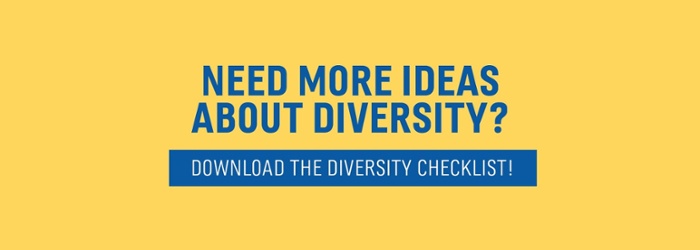
Related Resources:
• Fitting in and Standing Out: The Paradox at the Heart of Admissions , a free guide • Different Dimensions of Diversity , a podcast episode • Approaching The Diversity Essay Question
About Us Press Room Contact Us Podcast Accepted Blog Privacy Policy Website Terms of Use Disclaimer Client Terms of Service
Accepted 1171 S. Robertson Blvd. #140 Los Angeles CA 90035 +1 (310) 815-9553 © 2022 Accepted

15 Best Diversity Statement Examples for 2024!
by Deniz Imer February 23, 2024, 11:02 pm 450 Views

Our world thrives on varied perspectives, and diversity statements are not just a formality but a necessity. Diversity statements are a commitment, a testament to an organization’s loyalty to inclusiveness and equity. As our workplaces increasingly evolve, the need to foster a diverse culture has been highlighted brighter than ever.
Let’s dive in together to the significance of diversity statements, explore why they are so vital, and how they can contribute to your organization’s success. Whether you are personally looking to craft diversity statements or organizationally, let us help you out on how you can navigate the transformative experience of celebrating all voices!
Table of Contents
What Is A Diversity Statement?
Diversity statements are concise documents that declare either an individual’s or an organization’s commitment to cultivating a diverse and equal culture. It outlines certain values and policies that are designed to describe how they support diversity, inclusion, and equity, and the initiatives that will support this environment.
These statements typically address issues that relate to recruitment, retention, and employee development . They can highlight initiatives, programs, or policies about creating a space that respects and appreciates individual differences regarding race, ethnicity, gender, sexual orientation, disability, and other aspects of identity. They are a crucial part of creating a people-centric culture in your organization and provide a good employee experience overall.
How To Write A Diversity Statement?
Here’s a five-step guide to how you can write your own diversity statement and what to consider.
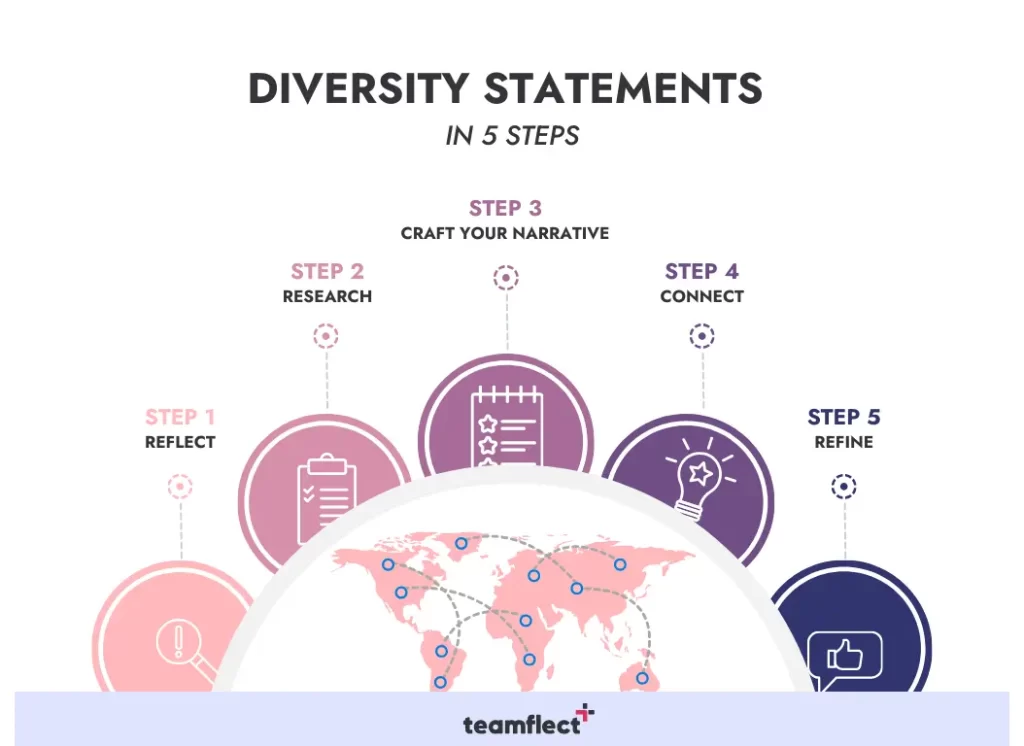
- Reflect: Consider how you personally relate to the realm of diversity and inclusion. Take into account your personal experiences and how diversity overall affected your perspectives and growth.
- Research: Get familiar with the values of your organization and understand what you want them to represent and support. Delve deeper into what type of challenges and opportunities there are in your given context, in terms of diversity.
- Craft Your Narrative: Start with an engaging introduction and share specific examples from your personal experiences that you were reflecting on earlier, to demonstrate your commitment to inclusion.
- Connect With Your Audience: Tailor your statement to your current context, and your audience’s needs. Make sure to align the values in your diversity statement with the mission and vision of your organization.
- Refine: Review your diversity statement to make sure it is clear and concise and is in alignment with organizational principles. Seek feedback and keep refining as you go to make sure your message is communicated effectively.
Real-World Diversity Statement Examples
Now that all of those details are out of the way, let’s take a look at some diversity statement examples to give you a better idea of how they look in real life.
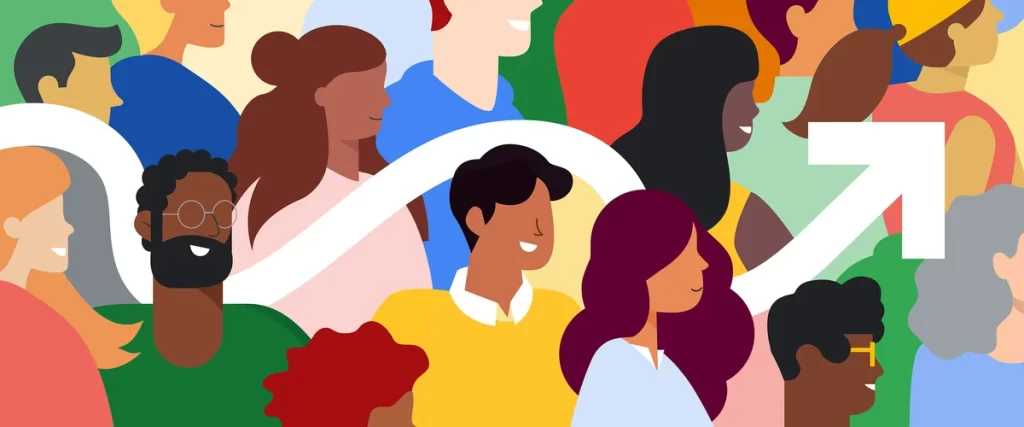
“At Google, we don’t just accept difference – we celebrate it, we support it, and we thrive on it for the benefit of our employees, our products, and our community. Google is an equal opportunity employer. Employment at Google is based solely on a person’s merit and qualifications directly related to professional competence.
Google does not discriminate against any employee or applicant because of race, creed, color, religion, gender, sexual orientation, gender identity/expression, national origin, disability, age, genetic information, veteran status, marital status, pregnancy or related condition (including breastfeeding), or any other basis protected by law.”
2. Microsoft
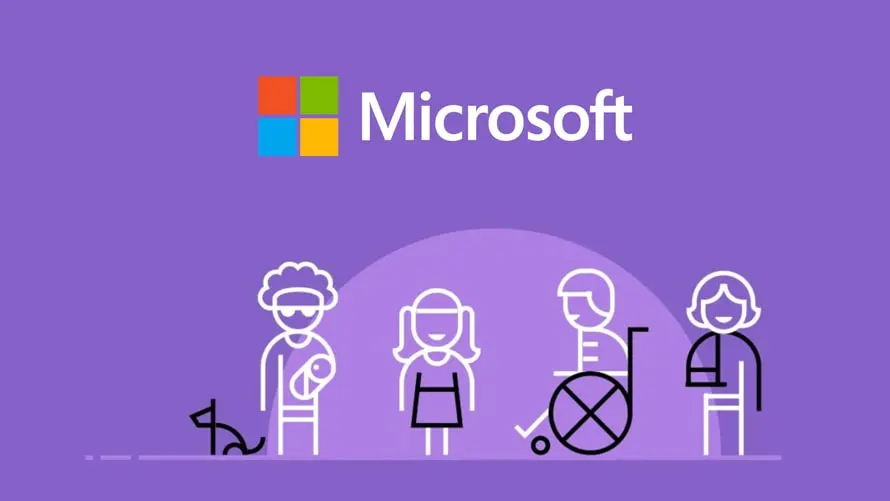
“ At Microsoft, we are committed to fostering an inclusive culture that values and embraces diversity. We believe that diversity fuels innovation, leading to better products and services. Our commitment extends beyond hiring practices to creating an environment where every employee feels empowered to contribute their unique perspectives. “
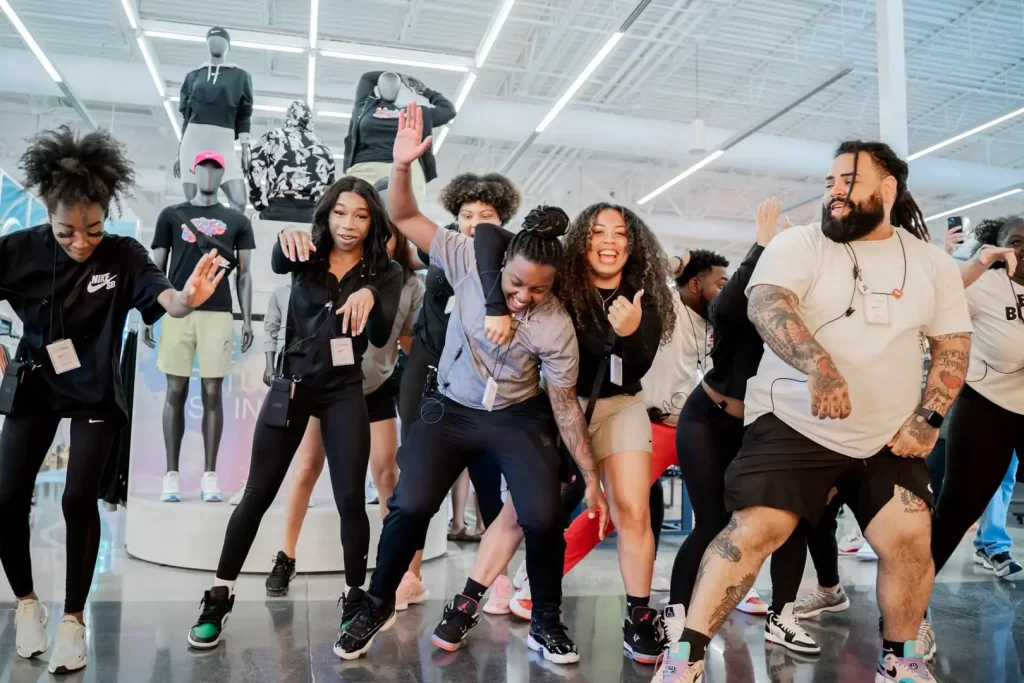
“We strive to ensure each person, now and in the future, is included and celebrated for who they are. We are creating the pathways, culture, and practices that build a Nike team representative of the people we serve.
From our partnerships with Historically Black Colleges and Universities (HBCUs) to product lines co-created with diverse athletes to industry-leading programs accelerating the careers of women from all walks of life, we’ll continue to push forward.”

“At Spotify, we welcome you with an inclusion mindset, one that prioritizes growth through listening and learning. No matter where you come from, or what’s playing in your headphones, we want to create a place where you belong.”
5. The Lego Group

“We believe the LEGO Group – and LEGO® play – is for everyone, no matter where you come from, what you look like, or how you identify.
It’s our mission to inspire and develop the builders of tomorrow. To succeed in this mission, and help all children develop the skills that will help them fulfill their potential, we must continue to play our part in building a more inclusive and equitable world, starting with our own organization.”
More Sample Diversity Statements To Use
If you need more examples still to take a sample for your own diversity statements, take a look at the following list we curated for you.
Sample Diversity Statements
- Innovative Corporate Culture: In our dynamic corporate environment, diversity is not just a policy but the catalyst for innovation. We recognize that a diverse workforce fuels creativity, enabling us to adapt and thrive in an ever-changing business landscape.
- Global Talent Empowerment: As a business leader, I am committed to cultivating a global team that mirrors the diverse markets we serve. Our company’s success is built on the unique skills and perspectives of individuals from various backgrounds, fostering a workplace where everyone can excel.
- Inclusive Leadership Development: Within our organization, diversity is not just a checkbox; it’s a cornerstone of our leadership development strategy. We actively seek and nurture talent from diverse backgrounds, ensuring that our leadership reflects the rich tapestry of our workforce.
- Tech Industry Diversity Advocate: In the tech industry, our commitment to diversity is embedded in our DNA. We understand that diverse teams lead to more robust solutions and innovative products. By fostering an inclusive environment, we create a competitive edge that propels our business forward.
- Corporate Social Responsibility: As a responsible corporate entity, our commitment to diversity extends beyond the boardroom. We actively engage in initiatives that support underrepresented communities, recognizing that our success is intertwined with the well-being of the diverse societies we serve.
- Strategic Recruitment Focus: Our business strategy includes a deliberate focus on diversity in recruitment. We believe that a diverse workforce brings varied perspectives to the table, enhancing our problem-solving capabilities and ensuring our products and services resonate with a broad customer base.
- Inclusive Supplier Relationships: Diversity is not limited to our internal operations; it extends to our supply chain. We actively seek partnerships with diverse suppliers, recognizing that fostering inclusivity throughout our business ecosystem is essential for sustainable growth.
- Corporate Equality Advocate: Within our corporate framework, equality is a core value. We champion diversity through policies that ensure equal opportunities for all employees, fostering a workplace where everyone feels valued, and respected, and has the chance to contribute to our shared success.
- Media Company Diversity Champion: In the competitive landscape of the media industry, our commitment to diversity is a strategic advantage. We actively seek projects that celebrate underrepresented voices, recognizing that diverse narratives resonate with a broader audience and contribute to our company’s success.
- Entrepreneurial Diversity Leadership: As an entrepreneur, I am dedicated to building a company where diversity is not just acknowledged but celebrated. We understand that a diverse team brings unique perspectives that drive our entrepreneurial spirit and contribute to the sustained success of our business.
What better way to start creating a more inclusive and connected team in your organization than implementing a performance management software into your day-to-day? Teamflect is an all-in-one solution that is seamlessly integrated into Microsoft Teams , where you can conduct all of your performance management needs in one place.
Give Teamflect a try today and start creating an environment of diverse, inclusive culture at your company that all good talent would want to get to and stay with!

Related Posts:
Written by deniz imer.
Deniz is a content writer at Teamflect. She is obsessed with organizational behavior studies and loves writing/thinking about how a carefully designed people strategy can transform a company.

Statutory Employees: Definition, Examples, Taxation Criteria, More! 2024

Employee Incentive Programs: 14 Examples & Best Practices
How to Write an Effective Diversity Statement for Graduate School

By ProFellow Founder, Dr. Vicki Johnson
I mentor many graduate school applicants in my Fully Funded Course and Mentorship Program who are seeking to enter fully funded PhD and master’s programs. A trend I have seen in recent years is the request for a required or optional “diversity statement” as part of the graduate school application. This essay is distinct from the personal statement, which is a document that describes your personal and academic background, your goals and your motivations for graduate study. The diversity statement typically prompts you to respond to questions about how you will contribute to the diversity of the student population. When graduate schools say “diversity”, they mean characteristics such as race, ethnicity, gender, age, religion, language, abilities/disabilities, sexual orientation, gender identity, socioeconomic status, academic and professional backgrounds, political beliefs, and geographic region, to name a few.
Why graduate schools ask for a Diversity Statement
The purpose of a diversity statement is to help universities form a student body that includes people of different demographic backgrounds and experiences – particularly one that is more inclusive of people from groups that have faced institutionalized discrimination and oppression. It is also a measure used to uphold the institution’s mission to achieve greater diversity, equity, and inclusion, which may be a relatively new value set that was established in response to social injustice in academia and wider society.
Before preparing your diversity statement, it can be helpful to understand the history and meaning of the university’s mission statement and values. Often, universities don’t want only to achieve a more diverse student body; they also want to select students who themselves are committed to addressing inequity and forms of historical and institutional discrimination, no matter what background they come from.
Because of this, it’s important to take the diversity statement just as seriously as the other components of your application. The diversity statement gives admissions committees a window into what you will uniquely bring to the university beyond your academic work and how you will engage in the university’s mission to achieve greater diversity, equity, and inclusion in society as a student and alumnus.
How to address Diversity Statement questions
Questions about diversity can be overwhelming. However, they all boil down to two objectives: 1) demonstrate the diversity you would bring to the student body and 2) explain how you address diversity, equity, and inclusion in your own life.
For the first part, you’ll want to discuss the diversity that you would add in the traditional sense, such as race, gender, socio-economic background, and identity. Diversity can also be expressed through your personal experiences, such as being a first-generation college student or an international student, having a military or service background, being a part of a religious minority, losing a parent at a young age, having a disability, being a single parent, having a medical diagnosis, or having a unique upbringing. Don’t assume that you have nothing to bring in terms of diversity – think about what unique experiences you have had, and you will almost certainly find something to highlight.
However, it’s important to keep in mind that your diversity statement is not a place to detail traumatizing experiences of discrimination and injustice. Instead, it is a place to discuss what you learned from these experiences and how those experiences have influenced and inspired your own social impact work. Application committees are seeking to understand the worldview you hold and identify if that worldview is aligned with their values and mission. Frame your personal experiences of diversity, equity, and inclusion with this in mind so that the application committee feels inspired by your story , rather than wondering if you’ll be committed to helping them further their mission of greater diversity, equity, and inclusion on campus.
The second part of the diversity statement is showing how you are actively creating a more diverse, equitable, and inclusive society through professional and personal pursuits. Here are a few questions you can speak to:
- Where do you volunteer?
- Who do you mentor, professionally or casually?
- What are you doing to promote policies that create greater equity and access to opportunities at school and work and in your community?
- What issues have you fundraised or advocated for?
The best diversity statements use specific examples to show a personal commitment to diversity, equity, and inclusion. Demonstrate your compassion for those suffering injustice – and then show how that compassion informs your research, teaching, professional work, activism, and community involvement.
Final tip: Educate yourself
As you write your diversity statement, be sure to acknowledge your privilege if you have benefited from advantages beyond your control – whether that is white privilege , socio-economic privilege, educational privilege or other types of privilege. Privilege can be described as “benefits that belong to people because they fit into a specific social group or have certain dimensions to their identity.” If you feel ignorant to concepts of privilege, now is a good time to educate yourself ! This piece of your application is an exercise to test if you understand the true costs and impacts of social inequity in the world.
Applying to graduate school and seeking funding opportunities? Get our FREE Directory of Fully Funded Graduate Programs and Full Funding Awards here!
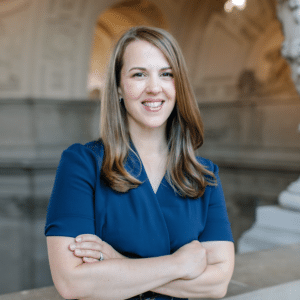
Dr. Vicki Johnson is Founder and CEO of ProFellow, the world’s leading online resource for professional and academic fellowships. She is a four-time fellow, top Ph.D. scholar, Fulbright recipient and an award-winning social entrepreneur. She is the Creator and Director of Fully Funded , an award-winning online course and mentorship program for graduate school applicants seeking to find and win full funding.
© ProFellow, LLC / Vicki Johnson 2021, all rights reserved.
Related Posts:
- Register Now: Personal Statement Bootcamp with Dr. Vicki Johnson
- 5 Myths About Grad School Personal Statements
- What Makes a Great Personal Statement?
- How to a Write Personal Statement for Graduate School
- #6: Prepare a Compelling Personal Statement
Dr. Vicki Johnson , Fully Funded , Graduate School Application Tips , Personal Statement Tips
17 Fellowships for Fighting Poverty for All Career Levels
9 fellowships for designers of any career level, find and win paid, competitive fellowships.
Be alerted about new fellowship calls for applications, get insider application tips, and learn about fully funded PhD and graduate programs
Fellowship Resources
- Calls for Applications
- Upcoming Fellowship Deadlines
- Fellowships Database
- Interviews with Fellows
- International Fellows Network
- Graduate Funding Directory
Fellowship Tips
- What is a Fellowship?
- Fully Funded Course
- Graduate School Funding
- Fellowship Application Tips
- Fulbright Application Tips
- Fellowship Application Guide
- Our Mission, History & Values
- ProFellow Winner Testimonials
- Fully Funded Course Testimonials
- Fellowship Industry Report
- Advertise With Us
- Terms & Privacy
ProFellow is the go-to source for information on professional and academic fellowships, created by fellows for aspiring fellows.
©2011-2024 ProFellow, LLC. All rights reserved.
- Search Search Please fill out this field.
- Building Your Business
- Operations & Success
How To Write a Statement of Commitment to Diversity and Inclusion (D&I)
Speak your company's truth, then work the plan
:max_bytes(150000):strip_icc():format(webp)/Sabrinaheadshot-877382636b804db6a71758884cef40ab-6270614d16e440d8a4a1d08e6660a231.jpeg)
What Is Diversity and Inclusion?
- The Purpose of a D&I Statement
- Getting Started on a D&I Statement
- D&I Statement Format and Evaluation
- Examples of D&I Statements
The Statement Is Just the Start
10'000 Hours / Getty Images
As studies have shown, companies that embrace and emphasize diversity and inclusion (D&I) in the workplace can benefit in many ways—from improved financial performance to a boost in innovation to higher employee engagement and retention rates.
However, while D&I can play a key role in improving a business’s bottom line and culture, it can also be pivotal when attracting valuable talent. In fact, according to two ZipRecruiter surveys, 86% of Millennial and Gen Z job seekers say workplace diversity is an important factor when looking for a job. What’s more, 48% were more likely to apply for jobs with employers that have issued a statement of their commitment to D&I.
Because job candidates are prioritizing and evaluating D&I when researching companies, you want yours to be an employer of choice—one that fosters a work environment in which the well-being, safety, and happiness of its employees are of utmost concern. By creating a clear statement of commitment to D&I, you can help reinforce your organization’s values.
Before creating a statement, though, it’s important to get some context and understand what D&I is.
The term “diversity” not only refers only to a person’s race, but a wide range of elements that make us unique. These include gender, age, religion, ethnicity, disability, sexual orientation, personality, skill sets, education, national origin, and marital and socioeconomic status. An organization’s “inclusion” is based on its ability to champion these differences so that employees are treated equally and feel they are accepted and belong. “Equity,” meanwhile, refers to providing fair treatment, opportunity, and advancement for all employees and working to eliminate barriers that may keep them from full participation.
The Department of Labor provides several resources for guidance on disability, diversity, and inclusion.
The Purpose of a D&I Statement
In the wake of civil unrest and Black Lives Matter protests after the deaths of George Floyd, Breonna Taylor, and others, institutions began to speak out. They posted messages in support of the social justice movements on their websites and social media platforms. In the months that followed, many companies all over the world allocated resources to fight systemic racism.
Though writing a D&I statement is just a start, it can be an effective way to set the tone for your company. It lets your customers, stakeholders, current employees, and job candidates know what your company’s intentions and goals are for D&I and how you plan to reach them.
Getting Started on a D&I Statement
Before you begin crafting a D&I statement, it’s best to gain input from employees at all levels so that you’ve absorbed a wide range of cultural perspectives. In addition, consider length; some D&I statements are brief (a few sentences), while others are considerably longer and include bullet points with actions that are being taken.
Once you’ve collected the key talking points and determined your statement’s length, it’s important to consider the tone and focus of the statement. The U.S. Chamber of Commerce offers some tips:
- Be authentic: Start by determining what D&I barriers currently exist in your organization and what can realistically be done to address them. What do you value when it comes to your workforce and customers, and how can this statement support that goal?
- Make it customized : Make sure the statement is clear on what your unique contributions are or will be to address the issues of D&I. Tie it to your company’s mission, vision, and values.
- Tell customers that your company represents its values : The statement should not be focused solely on current or potential employees, but rather on your customers and other stakeholders, as well.
- Include action steps : Provide a clear outline on how your business goals will be reached and how they relate to the organization’s overall strategic plans.
D&I Statement Format and Evaluation
The formats of these statements vary widely—some fill a brochure, others are fewer than 100 words long. Many begin with a headline or tagline that sets expectations, while others accompany images that reinforce the message. All are acceptable formats, so don’t be overly concerned that you must have it one way or the other. Generally, and importantly, the tone of these statements is positive and progressive.
A D&I statement is not an apology for past actions, but rather a declaration recognizing societal issues and the company’s strong intention and commitment to actively address them.
Most statements are written simply and are easily understandable—this is a key attribute you should keep in mind. You may also choose to write three separate statements for diversity, equity, and inclusion.
Once a draft is created, share it with employees and other trusted stakeholders to offer them an opportunity to give valuable feedback. It may take several drafts before you reach the final version. A D&I statement should:
- Align with your mission and vision statements
- Be displayed prominently on your website and in job listings
- Be shared on social media platforms
Printed materials and signs should also be considered. These physical and online placements can help make clear that D&I initiatives are a priority for your business, and perhaps inspire others to take responsibility—and action—in the process.
Examples of D&I Statements
To get a glimpse of the varying tones and formats that D&I statements can take, here are two examples from familiar brands:
Technology giant Apple provides an enticing, simple tagline, “We’re all in,” which tops its Inclusion & Diversity page. What follows is a scrolling data- and visual aid-filled experience that kicks off with this statement: “Across Apple, we’ve strengthened our long-standing commitment to making our company more inclusive and the world more just. Where every great idea can be heard. And everybody belongs.”
Dick’s Sporting Goods
Retailer Dick’s Sporting Goods, on the other hand, takes its sports focus to heart, using a team metaphor that aligns with its model and mission. The company states: “You believe in doing the right thing. So do we. Our commitment: From our stores to our distribution centers and our corporate office, we are a team. We believe the best teams not only share common goals and values, but they also need a diverse set of skills, perspectives and experiences to truly succeed. It’s important that our teammates reflect the athletes and communities we serve, and we’re working hard to make sure they do. We actively seek to hire a diverse workforce to promote and celebrate inclusion and diversity. Doing so strengthens our ability to serve all our athletes, drives innovation and growth, and enables us to attract and retain the best talent.”
While writing a statement can help signify your intentions to focus on D&I, it takes more internal effort to make real progress. According to a report released by HR analyst and educator Josh Bersin and employee analytics firm Perceptyx, the most successful companies embed diversity, equity, and inclusion as a business imperative into the mission, vision, and strategy itself.
Taking a long-term approach and prioritizing D&I initiatives, setting benchmarks, evaluating progress along the way, and making adjustments can ultimately bring about measurable success. While making a public announcement of your company’s values is a good start, backing those words up with actions will make your statement resonate even more.
Deloitte. " Unleashing the power of inclusion: Attracting and engaging the evolving workforce ." Page 3. Accessed May 3, 2021.
Mckinsey & Co. " Diversity wins: How inclusion matters ." Accessed May 3, 2021.
ZipRecruiter. " Job Seekers Value Diversity When Looking for a Job, Cite Discrimination as Reason to Quit ." Accessed May 3, 2021.
ZipRecruiter. " What Job Seekers Want When It Comes to Diversity & Inclusion Right Now ." Accessed May 3, 2021.
World Economic Forum. " What Companies are doing to fight systemic racism ." Accessed May 3, 2021.
U.S. Chamber of Commerce/CO. " Writing a Diversity and Inclusion Statement: How to Get It Right ." Accessed May 3, 2021.
Apple. " Inclusion & Diversity: We're all in ." Accessed May 3, 2021.
Dick's Sporting Goods. " You believe in doing the right thing. So Do We ." Accessed May 3, 2021.
Perceptyx, Josh Bersin. " Elevating Equity: The Real Story of Diversity and Inclusion ." Pages 22-23. Accessed May 3, 2021.
Center for Teaching
Developing and writing a diversity statement.
| Beck, S. L. (2018). Developing and writing a diversity statement. Vanderbilt University Center for Teaching. Retrieved [todaysdate] from https://cft.vanderbilt.edu/developing-and-writing-a-diversity-statement. |

What is a diversity statement, and what purpose does it serve?
What topics might be included in a diversity statement.
- Getting Started
Writing Prompts
Adapting your statement for a job application, additional resources.
Increasingly, institutions of higher education are becoming more intentional and programmatic about their efforts to embrace principles of inclusion, equity, justice, and diversity throughout campus life. As they do so, they are more focused on finding faculty who have experiences and competencies that can contribute to these efforts. Consequently, universities and colleges frequently are requesting that job applicants address how they can contribute to a culture of inclusion and equity within the campus community in the form of a “diversity statement.”

Sometimes, a job ad will request that applicants address diversity in the cover letter or the teaching statement, but a request for a separate diversity statement is becoming more common. From the perspective of some universities, the purpose of such documents is to demonstrate that the applicant has commitments and capacities to contribute to the institution’s projects of inclusion and equity via their work, including scholarship, teaching, service, mentoring, and advising. Asking faculty applicants to speak to inclusive excellence in their application materials or during the interview process shows a university’s commitment to inclusion and ensures that new faculty share that commitment (2018). The document is also an opportunity for applicants to highlight their understanding of the barriers faced by under-represented or marginalized groups, as well as their own experiences meeting the needs of a diverse population of students, staff, and peers. For example, The University of California at San Diego requests a separate “Contributions to Diversity” statement from all faculty applicants, and its published guidelines suggest describing “your past efforts, as well as future plans to advance diversity, equity, and inclusion.” (2.1.18, https://facultydiversity.ucsd.edu/_files/c2d-guidelines.pdf ).
The wording that universities and colleges use in framing the request for a diversity statement varies widely. Below are a few examples from job ads posted in the 2017-2018 academic year.
St. Mary’s College of Maryland (public liberal arts college, faculty posting in Psychology):
Applicants should submit a statement explaining how their teaching at the College will contribute to a culture of inclusion and campus diversity .
Denison University (private liberal arts university in Ohio, faculty posting in Anthropology):
A description of how the applicant would contribute to the development of a diverse and inclusive learning community at Denison through her/his teaching, research, and/or service .
Angelo State (public university in Texas, faculty posting in Engineering):
The required Other Document should be no longer than 2 pages and should discuss how the candidate would help achieve Angelo State University’s goal to attract and graduate more women, Hispanic, and students from other underrepresented groups .
Georgia College and State University (public liberal arts college, faculty posting in Psychology)
Qualified candidates should submit a research statement, and a diversity statement (describing how you incorporate diversity into your teaching, research, and/or service). Teaching, research, and diversity statements should be limited to two single-spaced pages.
Franklin & Marshall College (private liberal arts college in Pennsylvania, Visiting Assistant Professor Position in Psychology)
Pursuant to the college’s vision for cultivating a diverse and inclusive community, the search committee will ask all applicants to address how their past and/or potential contributions might serve to advance F&M’s commitment to teaching and mentoring young people from a variety of personal experiences, values, and worldviews th at arise from differences of culture and circumstance.
Since the diversity statement is an emerging genre in the context of faculty job applications, there are few set guidelines on what must be included. Keeping in mind that the purpose of the statement is to demonstrate a commitment to fostering diversity, the following elements may be appropriate:
- Statement of values as they relate to your understanding and commitment to diversity, inclusion, equity, and/or justice in higher education.
- Examples of experiences that demonstrate your commitment to fostering the success of underrepresented students, staff, and peers, and supporting a diversity of perspectives in the classroom, lab, campus, or community.
- Future plans for continuing to advance inclusive excellence, diversity, or equity in your research, teaching, and service.
Getting started

- What are your values regarding diversity, inclusion, and equity in your professional life? Why do you think diversity is valuable in higher education settings? How about in your discipline specifically?
- What kinds of student, staff, or faculty diversity are you thinking of as you answer this question, and are there other ways in which diversity manifests in campus communities that might be valuable to consider?
- What elements of your own identity inform your teaching, research, or scholarship in a tangible way?
It is worth noting that diversity statements are fundamentally about your values, commitments, and capabilities, and not necessarily your identity and the ways it shapes your work. If you choose to disclose your identity in a diversity statement, you should be aware of some issues.
Should You Self-Disclose Elements of Your Personal Identity?
Note that some people wish to share elements of their personal background in their actual statement, and many do not. Reflecting on your own frame of reference can be useful regardless. Some degree of transparency may help readers contextualize the experiences and approaches you detail in your statement. For example, you may wish to share that you grew up in a bilingual household or that you attended graduate school as an international student, if either has influenced your approach to mentorship or teaching. A 2014 study investigated the content of 191 cover letters for faculty positions in which applicants were specifically asked to address diversity and inclusion; less than a quarter of applicants self-disclosed some aspect of their personal identity (Schmaling, Trevino, Lind, Blume, & Baker, 2014). Despite the low percentage of applicants who chose to self-disclose and despite the authors’ note that they could not determine which applications advanced as a function of the applicants’ choice to self-disclose, they write that “self-disclosing one’s diversity may reconceptualize membership in a previously stigmatized group as an advantage, particularly if the self-identification reinforces a coherent academic and professional identity (Schmaling et al., 2014, p. 10)..”
However, be advised that there is risk in disclosing details that may carry stigma or induce subtle biases on the part of readers. For example, some research confirms that biases toward African Americans and women influence evaluation of written application materials (Dovidio & Gaertner, 2000; Moss-Racusin, Dovidio, Brescoll, Graham, & Handelsman, 2012), specifically when the application is not exceptionally weak or exceptionally strong (Dovidio & Gaertner, 2000). The potential benefit of self-disclosing one’s mental health history or sexual orientation, for example, should be carefully weighed against the risk. To be sure, an excellent statement can be written without sharing elements of personal identity, and some universities that request statements are beginning to highlight this. The University of San Diego’s published guidelines to writing a diversity statement, for example, emphasize their desire to identify candidates who share the institution’s commitment to inclusive excellence, “regardless of personal demographic characteristics.”
The following prompts are meant to help you identify areas of strength to highlight in your diversity statement. For each of the following areas, think about your past experience and what you plan to do in the future. You don’t need to answer every question, as all may not apply.

Research and Scholarship
- Does your research/scholarship directly address issues of diversity, inclusion, or equity? If so, how?
- Does your research/scholarship address issues specific to marginalized groups? If so, describe the connection.
- Has your research/scholarship been shared with the community or public in a way that promotes access to scholarship?
- Has your scholarship involved collaboration with diverse groups of colleagues or commentators?
Mentorship and Advising
- Have you worked with any students in a mentorship or advisory capacity who are from marginalized groups? If so, how did you help them identify and overcome barriers to success? Think about your experience with research mentorship, teaching or tutoring, academic advising, and community mentorship.
- If you plan to train undergraduates and/or graduate students in your future role, what efforts will you make to recruit and retain students from marginalized and underrepresented groups?
- How do you plan to serve a student body that is diverse in a multitude of ways? Think not just race, ethnicity, and SES, but about age, religion, academic preparedness, disability, gender expression, or other differences.
- How does your approach to course design take into account considerations of diversity? You may wish to reflect on using a range of assessments, preventing bias in grading, diversifying course content, using inclusive language in the syllabus and classroom, or utilizing student feedback to improve classroom culture or tone. Try to generate at least one specific example of how your decision affects student’s learning in your course. (Note: One prominent example of inclusive syllabus language is diversity statements within syllabi; see examples from Brown University , Yale Center for Teaching and Learning , and The Eberly Center at Carnegie Mellon University )
- What do you do as a teacher that creates a welcoming and inclusive atmosphere? How do you ensure that students in your class feel a sense of belonging?
- How does your approach to facilitating discussion (and/or structuring active learning activities) take into account considerations of positionality, power, and/or diversity? You may wish to reflect on using semi-structured discussion techniques, online access points for student participation, classroom seating arrangements, or other ways in which you create opportunities for student engagement. Try to generate at least one specific example of how your pedagogical choice facilitates student engagement in a particular course.
- Does your discipline lend itself to dialogue about diversity? If so, how do you incorporate this dialogue into your courses? Describe the impact of doing so on student learning and engagement.
- How do you ensure that your course readings and sources reflect diverse perspectives? Have you had any experience diversifying/decolonizing content for your courses, and if so, what has been the impact on student learning?
- Have you participated in any service activities (e.g. university committees, symposiums, workshops, volunteer work in the community) whose goals relate to diversity, inclusion, and equity? If so, describe your experience. What did you accomplish? What did you learn? What skills did you build in the process?
- If you have engaged in diversity-related service, how will you incorporate your experience into the job for which you are applying? (Note: here is where – having done your research on the school to which you are applying – you might consider referencing an existing diversity-related initiative to which you could contribute or which you could expand)
After you have developed a statement that reflects your strengths and experiences related to diversity, inclusion, and equity, you may wish to tailor it for individual job applications. Be sure to do your homework about diversity-related programs and resources at the schools to which you are applying, and consider including how you plan to contribute to or expand existing programs at that institution. For example, if you have been particularly active in social justice initiatives and are applying to a school with no existing programs addressing race, power and privilege in higher education, it may be appropriate to propose a program modelled on something you’ve already done. However, you do not need to propose a new diversity-related program to write an effective diversity statement. Perhaps you envision your contribution as serving on faculty committees related to diversifying curriculum in your department or advising LGBT-student groups or research initiatives. Be honest about where you are and how you can contribute.
- Golash-Boza, T. (2016). “ The Effective Diversity Statement .” Inside Higher Ed.
- University of California: Contributions to Diversity
- Dovidio, J. F., & Gaertner, S. L. (2000). Aversive racism and selection decisions: 1989 and 1999. Psychological Science, 11 (4), 315-319. http://dx.doi.org/10.1111/1467-9280.00262
- Schmaling, K. B., Trevino, A. Y., Lind, J. R., Blume, A. W., & Baker, D. L. (2015). Diversity statements: How faculty applicants address diversity. Journal of Diversity in Higher Education, 8 (4), 213-224. http://dx.doi.org/10.1037/a0038549
- Moss-Racusin, C., Dovidio, J. F., Brescoll, V. L., Graham, M. J., & Handelsman, J. (2012). Science faculty’s subtle gender biases favor male students. PNAS Proceedings of the National Academy of Sciences of the United States of America, 109 (41), 16474-16479. http://dx.doi.org/10.1073/pnas.1211286109

Teaching Guides
- Online Course Development Resources
- Principles & Frameworks
- Pedagogies & Strategies
- Reflecting & Assessing
- Challenges & Opportunities
- Populations & Contexts
Quick Links
- Services for Departments and Schools
- Examples of Online Instructional Modules

Diversity Statements
What this handout is about.
This handout will help you write a diversity statement in preparation for an academic job. Although it is geared toward academic jobs, much of the advice throughout this handout can be used to construct diversity statements for other fields. Overall, this handout offers insights into the form and construction of an effective diversity statement.
What is a diversity statement?
The diversity statement is a relatively new addition to the job application portfolio. It tends to be a one- to two-page document that explains your experiences with and commitments to diverse populations of students. A university that seeks this statement from applicants is typically concerned with ensuring that faculty hires are familiar with its diverse student populations and willing to support students in line with the university’s mission statement. A successful diversity statement talks about your background and how you will create a diverse and inclusive learning environment for all students.
What is diversity?
There is no universal definition that all institutions use for diversity. This lack of definition can be frustrating. You may find yourself at a loss for how to talk about a concept that is not defined. However, there are still clues, usually provided by the institution. You can ask:
- Does the university have a diversity statement on its website?
- Does the university have a diversity and inclusion office? If so, what is its mission statement?
- How has the university’s alumni magazine discussed the current student population?
- Does the office of institutional research publish public reports about diverse populations?
However, not having a definition can be freeing. It allows you to really consider your commitments to students and examine what diversity could mean. For example, if you are considering a college or university set in the mountains, it may mean a student population that identifies as Appalachian. Conversely, schools in North Carolina might be concerned with the enrollment and matriculation of Indigenous students. In other words, how diversity is interpreted depends largely on the institution, its location, and its current student population. Ask yourself:
- Have you worked with first-generation students? International students? Students from underrepresented minority groups?
- Have you worked with students from rural or urban environments?
- Are you familiar with students from the South, Northeast, Midwest, Northwest, Southwest?
- Have you worked with students who identify as neuroatypical?
- Have you worked with students who identify as LGBTQIA+?
- Are you familiar with students from a range of socio-economic backgrounds?
- Have you worked with non-traditional students?
This list of questions is not meant to be comprehensive but to help you think about how you consider diversity as a future instructor at a university. If you happen to have little to no experience working with diverse populations of students, do not fear. There are strategies, which will be addressed below.
Before you start writing
Bear in mind that writing this statement will require you to be flexible in both how you define diversity, as we discussed above, and how you have encountered diversity throughout your career. Below are some strategies for demystifying the expectations for diversity statements.
Consult models
Because the diversity statement is a new addition to the application portfolio, you may find that your usual mentors are unable to give you more direct guidance in its composition. However, it does not mean that you do not have options. You might:
- Reach out to colleagues and friends in the early stages of their career and ask them about their experiences writing diversity statements.
- Ask your university’s career services if they have any examples.
- Try to find examples from successful job candidates.
- Ask people who have recently served on hiring committees.
All of these suggestions can help demystify the process of writing a diversity statement. You also might want to reflect on how diversity is discussed on your current or most recent campus, and compare it to how diversity is discussed at the potential new campus.
In order to tailor a diversity statement to a specific institution, you need to think about the concerns of your audience and how your approach to diversity fits into the broader mission of the university and the department. In essence, this essay allows you to communicate how you will potentially serve the students at your new university in a way that is slightly different than your teaching statement and job application letter. Below are some questions you might consider:
- How has the university approached diversity recently?
- Does the university have a diversity and inclusion office?
- How has the university defined diversity in the past? How are they defining it now?
- What populations does the university serve?
- Are there any populations on the rise or in decline in the university or university system?
- Is the university in the midst of any diversity initiatives? If so, what are they?
- Whom does the department serve?
- Do certain student populations take more courses in the department than others?
- Is the department involved with any diversity initiatives?
These questions can help you consider the institution’s commitments and make clear the populations of students with whom you will be interacting. Moreover, they can help you understand your audience and anticipate what information might be most pertinent or interesting to them. After all, part of the goal in writing this statement is presenting yourself as capable and competent in teaching and interacting with the students whom the university serves.
Writing a draft
Because diversity statements continue to evolve, there is no set form. The lack of a standard form allows for creative freedom—hopefully a positive. As such, this section will provide a variety of considerations and strategies to compose a diversity statement.
Organization
You have many options for crafting your statement to emphasize the aspects of diversity most important to you. Below are a few examples of different organizational strategies:
Think of your statement as a narrative (past, present, future). This strategy allows you to build upon past experiences to point towards future development. You might consider these questions:
- How have your previous experiences informed your understanding of diversity?
- How do you currently approach diversity and inclusion in and outside the classroom?
- How do you think your current practices will translate to a new environment?
- If you have had little interaction with students from diverse backgrounds, how have you learned about diverse student populations? How might you make your classroom inclusive?
- How might you apply the knowledge you have learned in the future?
This approach can help you think about how your approach to diversity has changed over time and demonstrate your ability to adapt to new environments.
Structure your statement around your commitments to diversity. This strategy asks you to prioritize your commitments and expand upon them based on your past and current experiences, as well as your future goals. You might consider these questions:
- How have you made your classroom accessible and inclusive?
- How have you invested in diversity or inclusion in the past?
- Have you worked with specific groups of students or student organizations?
- Have you integrated your commitments into your research? If so, how?
- Have you integrated your commitments into your teaching? If so, how?
- How does your research inform your teaching?
- How have you or will you make the classroom inviting to a variety of students?
This approach ultimately helps you think about how diversity is an integral part of who you are as a researcher and instructor. It can help demonstrate how you connect your work inside and outside the classroom.
Narrow your focus to teaching. This strategy focuses on practical application of diversity in the classroom. It asks you to think about how you may have shifted your teaching to serve different groups of students. You might consider these questions:
- How do you foster diverse student perspectives?
- How have you integrated diverse perspectives in your teaching?
- How have you approached controversial topics, such as religion or politics, in the classroom? How did you include all students in these types of discussions?
- How does your course material reflect contributions from diverse perspectives?
- How have you modified class discussions and course materials to include all your students?
- How have you in the past and how will you in the future continue to encourage students to think about the effects of racial, cultural, gender, socioeconomic, and other differences?
This approach can characterize what is distinctive about your teaching and how it serves students, as well as how it expands their view of diversity.
Make it autobiographical. This strategy focuses on you as an individual, and it should explain how diversity has impacted your career. In this essay, some applicants might choose to self-identify. Others may instead choose to focus on their pedagogical experience with diverse populations over their career.
Talk about your own experiences as a member of an underrepresented group.
- Discuss how you have grown to understand diversity over your education and instructional experiences.
- Discuss how you have been impacted by diversity throughout your academic career, directly or indirectly.
Possible pitfalls
Not being specific. Make sure that when you talk about a certain strategy or a certain group of students that you provide a concrete example. The diversity statement is not simply a list of all the work you have done working with diverse student populations or a restatement of your CV, but it should highlight the most important aspects of how you have approached diversity in the past and include a reflection on those actions. To avoid falling into this trap of listing, you need to think about your specific experiences as evidence. This list is not exhaustive, but it will help you consider the type of examples that a reader might expect in a diversity statement:
- Specific topics you covered in class and student reactions.
- Specific assignments and students’ reactions.
- Specific strategies you have used to include all students in the classroom.
- Specific anecdotes and comments from students.
- Examples from course evaluations.
- Specific events or initiatives you participated in and their success.
Not telling the truth. Above all, be honest! If you have not had experiences with diverse groups of students or you are not a member of an underrepresented group, then you can talk about how you would approach working with students from diverse groups and backgrounds. You can mention that you have researched or studied pedagogy working with diverse groups of students. You can offer examples of techniques or classroom strategies that you would use or think would be helpful for the institution that you are applying for.
Forgetting to revise. Remember your first draft is not your last draft. For some, the revision process is the most difficult part of writing. However, sometimes the best way to tackle indecision about a draft is to receive feedback from a variety of different readers. Outside readers can help you see any shortcomings, point out places where you might need more information, and affirm that you have done a complete job. You can ask: your advisor, your mentor/s, colleagues, and other early-career scholars. For more information about the revision process, see our Editing and Proofreading handout or Proofreading video for some strategies.
Ignoring your audience. Make sure that you address the needs of the department and university. Neglecting to consider the short term and long term goals of the university or the needs of the student population at the institution makes you appear at best unprepared or ill-informed and at worst obtuse.
Not doing yourself justice. The statement should not be an exhaustive list of all the times you worked with diverse populations, a treatise on the ideal classroom, or the appropriation of a student’s or a student group’s experiences as your own. Nor should your statement fail to offer some personal reflections on your experiences in teaching or possibly outside of the classroom. The statement should share your thoughts and recognize the rewards, challenges, and difficulties of making course material and research relevant to diverse student and faculty populations.
Works consulted
We consulted these works while writing this handout. This is not a comprehensive list of resources on the handout’s topic, and we encourage you to do your own research to find additional publications. Please do not use this list as a model for the format of your own reference list, as it may not match the citation style you are using. For guidance on formatting citations, please see the UNC Libraries citation tutorial . We revise these tips periodically and welcome feedback.
Bryce, Leah. n.d. “Making Sense of the Diversity Statement.” Chronicle Vitae . Accessed April 4, 2014. https://chroniclevitae.com/groups/diversity-in-hiring/making-sense-of-the-diversity-statement .
Flaherty, Colleen. 2018. “Breaking Down Diversity Statement.” Inside Higher Ed , November 19, 2018. https://www.insidehighered.com/news/2018/11/19/new-paper-explores-what-faculty-candidates-include-their-diversity-equity-and .
Golash-Boza, Tanya. 2016. “The Effective Diversity Statement.” Inside Higher Ed , June 10, 2016. https://www.insidehighered.com/advice/2016/06/10/how-write-effective-diversity-statement-essay .
Kelsky, Karen. 2015. “What Is a Diversity Statement, Anyway?” In The Professor Is In: The Essential Guide To Turning Your Ph.D. Into a Job , 185–90. New York: Three Rivers Press.
You may reproduce it for non-commercial use if you use the entire handout and attribute the source: The Writing Center, University of North Carolina at Chapel Hill
Make a Gift
Center for Career Development

Diversity Statements
The purpose of this guide is to provide a foundation for thinking about your own diversity statement(s). This guide is general and does not provide discipline- or position-specific guidance. The Center for Career Development offers one-on-one appointments to review and discuss your diversity statement. We also encourage you to reach out to recent faculty hires in your department or discipline to discuss their diversity statements as they are most likely to have good examples of what committees may find compelling.
What is a diversity statement and what is its purpose?
In recent years, many colleges and universities started prioritizing diversifying their faculty, staff and student bodies. Institutions are interested in hiring faculty with lived experiences, competencies, or insights that can foster an inclusive environment. Your diversity statement is the first way a committee will assess your ability to navigate these topics. A diversity statement outlines how a candidate will contribute to an institution's approach to diversity, equity and inclusion (DEI). It's an opportunity for you to highlight the ways you would advance an institution's DEI work. It's also a chance for you to discuss your understanding of the varied experiences of people from minoritized and/or underrepresented groups. You can also outline your lived experiences or your experiences meeting the needs of a diverse group during your graduate training and beyond. It is also appropriate to outline a vision of how you, as a faculty member, would make contributions to DEI in the future. Your statement will likely have at least some of these elements:
- A statement of your perspective or values: Articulate your understanding of DEI within higher education
- Personal examples or experience: Provide evidence of your commitment to DEI by describing what you've done in the past
- Future plans: Explain what you will do as a faculty member to advance DEI
What topics might I cover?
Diversity statements vary widely in terms of what people choose to highlight depending on their own identities, experiences and backgrounds. You should include content that you think addresses how you have approached diversity in the past or may approach it in your new position. The following list is intended to serve as a starting point and is not exhaustive.
As with any piece of writing, it's helpful for a reader if you provide a framework. To orient your reader, you may want to discuss difficulties people from certain backgrounds face in your field.
You may also want to discuss your lived experiences navigating some of those very difficulties. However, for legal, personal or political reasons, you may choose not to include information about your identity. Either approach is fine.
If you are conducting research that focuses on people of diverse backgrounds or that offers theoretical or practical insights into underserved groups, be sure to highlight that in your diversity statement. It should also appear in your research statement.
You could also discuss ways you are going to support students of diverse backgrounds who may work with you as research assistants or thesis students.
If you have teaching experience, you may consider discussing how you incorporate DEI in your courses. For example, you could discuss inclusive teaching practices or how you have approached teaching diverse groups.
Mentorship is another form of teaching, so if you have experience working with students from minoritized or under-represented backgrounds, you can also highlight that.
It is also acceptable to generate ideas about how you would approach teaching as a new faculty member through the lens of DEI. Topics you include in your diversity statement related to teaching should complement what you talk about in your teaching statement.
If you hold positions within your department, on campus, or your professional associations related to DEI, you can discuss how those will shape your approach as a faculty member.
You can also discuss any outreach you may do in the community, especially related to marginalized groups.
Getting started
Writing a diversity statement is like writing other academic job materials (e.g., teaching or research statements). Because of that, many of the steps for a successful diversity statement are similar to other documents.
It may seem obvious, but ask yourself, “What do I mean by DEI? What does the institution mean?” These questions are critical to writing a coherent statement.
Using the topics listed above , you can also ask yourself more specific questions related to your ideas about diversity. Beck (2018) provides a useful list of questions you may want to consider as writing prompts.
Consider your audience
As with most writing, you are creating your diversity statement for someone to read. Keep this audience in mind as you craft your document.
Your statement will be read by a committee of faculty members, but the exact composition will vary depending on the type of institution you're applying to. Consider what faculty will want to or expect to see in your statement ( see topics above ).
Select your examples
Diversity statements are typically only about a page long. You may have a range of experiences you would like to discuss or cover. Be thoughtful about which examples you choose.
Each example you choose should highlight a competency, perspective, or experience you have that demonstrates your commitment to DEI.
The Writing Center , Center for Career Development, Gender and Sexuality Resource Center and your faculty mentor(s) are good resources to discuss your examples.
Revise and refine
As with all writing, your first draft of your diversity statement won't be your last or your best.
Have trusted advisers, mentors, and/or friends read over your statement to help make sure you're articulating your points as clearly as possible.
Should I tailor my diversity statement?
Once you have a general draft you feel comfortable with, you should make sure to research a specific institution or department's programs, efforts and policies related to DEI. When possible, align your statement with what is already happening to demonstrate that you've done your research. This will also allow you to provide more specific evidence about why you are the best candidate for their open position.
Example diversity statement
This statement was used by a candidate during a faculty job search as a fifth-year Ph.D. student. He received a faculty offer at a small liberal arts college in a psychology department.
My commitment to equity, diversity, and inclusion stems from my own experiences as an undergraduate at Princeton University. As a lower-income queer student from a single-parent household, I felt out of place at Princeton to begin with. Coming from a public high school in Kentucky, I was terrified of falling behind academically.
Because of this fear, I was reluctant to try new fields, and I actively avoided asking for help from staff and faculty. During my first two years of college, I rarely felt that my professors were creating environments where my experiences were understood or valued. At my lowest, I considered transferring.
Eventually, though, I found my footing on campus through my work as a Residential College Adviser. In this role, I had the opportunity to advise a diverse group of first-year undergraduates. I was able to see the struggles that all of my advisees faced on campus, some of which overlapped with my own.
I became acutely aware of the need for universities to acknowledge the unique adversity facing each of its students. In addition, as an advisor I learned how critical it is to make it clear to students that you value the unique perspectives they each bring. These lessons are foundational to how I mentor and teach, and I will continue to emphasize equitable and inclusive treatment of students as a faculty member.
As a PhD student, I have taken on several roles related to equity, diversity, and inclusion. I was elected by my peers to serve as the liaison between graduate students and faculty in my department. This role involved collecting anecdotes and experiences from PhD students about a range of issues including microaggressions, advisor conflict, and financial strain.
In one extreme case, several PhD students in my department did not receive a paycheck one month. In response, I drafted a letter based on students' accounts of this financial hardship and sent it to the dean of my academic college. Eventually, the issue was resolved. I enjoyed using my position to support students. I think it is especially important that those with institutional influence or privilege use that status to enact change and advocate for those without the same level of access to power.
I also served on my department's Equity, Diversity, and Inclusion (EDI) committee. On the EDI committee, I contributed to discussions about how to promote equity and diversity in our department. I suggested that the department host a training from a member of the university's LGBTQIA center focusing on supporting queer students.
This training was well-attended and well-received by members of my department. In all of my past roles, my goal has always been to improve the experiences of people of all backgrounds. I am very interested in pursuing similar opportunities when possible at X university or college.
My goal as an instructor and mentor is to increase accessibility and promote inclusivity. In my teaching, I strive to highlight the importance of students' unique experiences and of diversity more broadly. In my Psychology of Language course, for example, I often talked openly with students about homogeneity in psycholinguistic research both in terms of who conducts studies and which samples are recruited.
I also dedicated an entire class session to talking about DEI. I assigned a recent paper about how the field could become more equitable. My students seemed to appreciate my approach. In my course evaluations, students rated whether I created an “inclusive classroom” at a 4.78 out of 5, higher than both my department and college's averages.
In my work as a writing tutor in the university's Writing Studio, I often encounter issues of equity and inclusion. In one case, for example, a student wrote a moving essay that focused on their gender identity and disability. This student was hesitant to divulge such personal information in an academic application. To belay their fears, I talked with the student about the fact that their unique experiences informed who they were and what they were hoping to do.
The student was passionate about promoting queer and marginalized voices, and they eventually chose to include information about their own identity. I am eager to continue working with students from diverse backgrounds at X college/university. I am passionate about ensuring that people from all backgrounds are able to thrive, especially in their academic endeavors.
Related links
- Advancing Equity in Faculty Hiring with Diversity Statements
- Breaking Down Diversity Statements
- Developing and Writing a Diversity Statement
- Writing an Effective Diversity Statement
- Write Your Diversity Statement in Four Steps
- What We Believe
- Our Reporting Offices
- Our Social Justice Definitions
- A History of Diversity, Equity and Inclusion at Brandeis
- DEI Program Request Form
- Staff-Faculty Accessibility Group
- Anti-Racism Education
- Campus Partners
- Undocumented, DACA and TPS Students
- All Gender Restrooms
- Brandeis Faculty and Staff Pride Alliance
- Alumni of Color Network
- Integrating DEI Processes and Practices
- Outreach Institutions
- Considerations for Mitigating Implicit Bias in Search and Selection
- Writing an Effective Diversity Statement
- Rubric for Evaluating Diversity Statements
- Interviewing
- Upcoming Events
- University Anti-Racism Plans
- Brandeis' Status on Commitments to DEI Issues
- Highlights from Past Years
- Degree Programs
- Graduate Programs
- Brandeis Online
- Summer Programs
- Undergraduate Admissions
- Graduate Admissions
- Financial Aid
- Summer School
- Centers and Institutes
- Funding Resources
- Housing/Community Living
- Clubs and Organizations
- Community Service
- Brandeis Arts Engagement
- Rose Art Museum
- Our Jewish Roots
- Mission and Diversity Statements
- Administration
- Faculty & Staff
- Alumni & Friends
- Parents & Families
- Campus Calendar
- Directories
- New Students
- Shuttle Schedules
- Support at Brandeis
Diversity, Equity, and Inclusion
The resources below were designed by the University of California system to support efforts to write and analyze diversity statements in a faculty search process. Diversity statements typically do one or more of the following:
- Give examples of a candidate’s past contributions to diversity
- Demonstrate an understanding of the particular diversity and equity related issues and needs in a candidate’s field, or in higher education more generally
- Discuss the candidate’s vision for how they might make contributions to diversity in the future
If a candidate has not yet made substantial past contributions, we recommend focusing on demonstrating an understanding of issues and/or future vision. In terms of the latter, a good first step is to gather information on activities—on campus or beyond—they would like to pursue while at Brandeis, and then to describe how and in what ways they might participate in these.
Please reference our Rubric for Evaluating Diversity Statements and Example DEI Interview Questions webpages for additional insights.
Examples of what might be included
The University of California system has created the following examples of what contributions to diversity might mean for applicants preparing diversity statements. This is by no means an exhaustive list, but rather is intended to illustrate how wide-ranging these contributions might be.
Prior to discussing one’s particular contribution to diversity, or future vision, it can be helpful for candidates to provide some context, and ‘state the problem’ these contributions aim to address. Thus we encourage candidates to use the opening of their statement to demonstrate an understanding of the broader issues of diversity, equity, and inclusion in their own field, and/or in higher education more broadly. This could include, for instance, discussing the particular barriers facing women, under-represented groups, and first generation college students in their field.
Such context can be particularly helpful if the candidate will be describing work with numbers of people from particular demographic groups. Such numbers are most meaningful after establishing the degree to which these groups are underrepresented in a given field, and/or their degree of underrepresentation at particular levels or ranks (graduate student, assistant professor, etc.).
Candidates might engage in multiple types of service to increase participation in higher education by historically under-represented groups and/or first generation college students. For instance:
K-12 outreach to demographic groups that are underrepresented in a candidate’s field or higher education more broadly
Serving as an advisor to programs such as Women in Science and Engineering, SACNAS or other equivalent programs in all disciplines
Exceptional record mentoring students and junior faculty from groups underrepresented in a candidate’s field or in higher education
Efforts to increase diversity, equity, and inclusion within departments, divisions, or professional societies
Candidates might engage in a range of teaching activities that enhance diversity, equity, and inclusion in the classroom and on campus. This may include:
- Teaching at a minority serving institution
- Record of success advising women and minority graduate students
- Experience teaching students with disabilities
- Designing courses or curricula to address diverse learning styles
- Developing effective teaching strategies for groups underrepresented in higher education or that meet the needs of educationally disadvantaged students
- Bringing diverse voices into your curriculum and the “cannon” in your field
Candidates might conduct theoretical or applied research that addresses questions of equity, diversity, and/or inclusion. This may include:
- Studying patterns of participation and advancement of women and minorities in fields where they are underrepresented
- Studying socio-cultural issues confronting underrepresented students in college preparation curricula
- Evaluating programs, curricula and teaching strategies designed to enhance participation of underrepresented students in higher education
- Research that engages or challenges categories of race, class, and gender
- Research that addresses health disparities, educational access and achievement, political engagement, economic justice, social mobility, civil and human rights
- Artistic expression and cultural production that reflects culturally diverse communities or voices not well represented in the arts and humanities
- Collaboration with researchers who are underrepresented in one’s field as a means of bringing in new perspectives and epistemologies
Candidates may have life and educational experience, outside work experience, and/or cultural competencies and communication skills that can contribute to broader diversity, equity, and inclusion efforts. For example, a candidate may have or display:
- Understanding of the barriers facing women, under-represented groups, and first generation college students in higher education, as evidenced by life experiences and educational background
- Drive and motivation to persist and succeed in their careers in spite of barriers in higher education that were directly experienced
- Creative and critical skills that come from a non-traditional educational background
- Communication skills and cross-cultural abilities to maximize effective collaboration with a diverse community of campus and external colleagues
Candidates may have participated as students, postdocs or faculty in academic preparation, trainings, or other programs designed to remove barriers facing women, veterans, people with disabilities, first generation students, etc., and thus have first-hand knowledge of the challenges for groups who are particularly underrepresented in a candidate’s field on in higher education.
- Updates and Statements
- Deis Impact
Diversity, Equity, and Inclusion [email protected] 781-736-4800
How to Write a Diversity, Equity, and Inclusion Statement
What is a diversity, equity, and inclusion statement, why does your company need a dei statement, what goes into your diversity and inclusion statement, what should you exclude from your dei statement, how to write the best diversity, equity, and inclusion statement for your organization, 3 dei statement examples, change your mindset to change your actions .
Words are a powerful catalyst for progress: Simply including a diversity, equity, and inclusion statement in your recruiting content can materially affect how candidates perceive your culture: as more inclusive, welcoming, and fair, a study from Datapeople reports .
Candidates aren’t the only stakeholders whose trust you can earn through a public commitment to diversity, equity, and inclusion (DEI) . Your DEI statement sends a powerful message about company priorities and gives clarity to clients, customers, and employees, too.
Your DEI statement needs to candidly demonstrate where your company stands, where you’d like to go, and how you’ll get there.
Learn more about writing an effective DEI statement that attracts candidates and customers while driving positive change within your company.
A corporate DEI statement is a public statement of your organization’s commitment to creating a culture that reflects your workforce’s diverse backgrounds and characteristics. DEI statements are often accompanied by specific initiatives, programs, and policies designed to foster a culture of inclusion, respect, and understanding.
And while these statements are essential to employer branding , that’s not their primary purpose. When written and implemented well, your DEI statement can be a strategic driver of change.
DEI statements serve two critical purposes at your company. One is to broadcast your commitment to workplace diversity and inclusion to current and potential clients, customers, and employees.
The second use is less common but no less important: To align your commitment to DEI with your overall business strategy. Your DEI statement can (and should) serve as a North Star as you build a better, fairer company culture.
As you consider how to write a diversity statement, look at what must be included to demonstrate your commitment. Positive sentiments are helpful but insufficient, for example, so prepare to back up your words with actions.
Your statement should provide DEI definitions for your culture. It should connect DEI to your specific mission, vision, and values, and demonstrate what living your DEI statement looks like in real life.
A good DEI statement acknowledges the current state of your organization, even if the truth is difficult to admit. Transparency matters. It’s OK to acknowledge that DEI is a work in progress and that you’re making changes. Link to any public-facing diversity reporting so interested readers can see the steps you’ve already taken.
Your DEI statement should also include where you want to go. Consider what an ideal internal culture looks like, and set metrics that measure that change. For example, many companies have specific, time-bound targets for diversifying their boards and leadership.
One of the worst things you can do is write a DEI statement your organization doesn’t intend to uphold. If you’re writing this as an act of self-promotion, then it’s better not to write one at all.
Leave pandering and performative commitments out of your DEI statement. For example, donating to an external cause or a charity and getting just a “thank you for your donation” letter is a great thing to do. But if you aren’t striving to create a diverse leadership pipeline internally, donating to an organization providing diverse populations with leadership training opportunities can come across as performative. If you donate to organizations that help diverse groups learn leadership skills, that’s great! Just make sure it’s not just for show, especially during this giving season .
Instead, outline the specific goals you hope to achieve, along with clear metrics for holding your organization accountable . It’s OK if you don’t meet every goal immediately, but you need to demonstrate that you did your best.
You can’t simply copy and paste another company’s DEI statement and expect it to work. Another company’s statement might inspire that workforce but be incompatible with your company and culture.
Follow these steps to write an effective diversity statement that drives sustainable change in your workforce.
Look to your mission, vision, and values
If you want your statement to create change, embed DEI into your business strategy. To do that, align your statement with your mission, vision, and values.
Start by reviewing foundational documents. Consider these questions as you draft your statement:
- What does diversity, equity, and inclusion in the workplace mean to you?
- How does your company’s mission align with DEI goals?
- How can contributions to DEI help in achieving your vision?
- Do the actions you need to take to improve DEI align with your company values?
Treat your DEI commitment as you would any other strategic business move. With your foundational documents providing direction, you can develop an action plan to reach your goals.
Link your statement to an action plan
Your DEI statement provides a direction. Use it to inform the specific actions your organization will take to enact a DEI strategy.
For example, if managers are recommending a disproportionate number of male employees for promotion, investigate why and propose solutions. It could be because the workforce is predominantly male or because your workplace culture rewards stereotypically masculine traits. To solve the problem, identify the required actions. In this example, you might focus on attracting and retaining more women and nonbinary employees, or you might switch to a performance enablement model to focus on potential and mitigate unconscious bias.
Your DEI statement should include concrete objectives that will create sustainable change. To do that, translate your action plan into public-facing goals. For example, many companies commit to increasing leadership diversity or providing specific resources to employees from underrepresented groups.
Set a specific goal that you can realistically achieve, and develop metrics for measuring your progress. Once you’ve shared those goals in your DEI statement, you’ve publicly committed to making that change happen. Your transparency will drive positive reactions and produce a sense of urgency to achieve your DEI goals.
DEI processes will overlap with HR, but examine other areas in your organization where DEI affects your processes and behaviors. Many companies are scrutinizing vendors and suppliers for their DEI commitments, for example.
Commit to being the change you want to see
DEI statements demonstrate a public commitment to change. But you must back that commitment up with proof of the work you’re doing to make a difference. This work starts with the leadership team, who set the tone — internally and externally — for what’s to come.
The strongest way for company leaders to signal their commitment to DEI is by embedding it in decision-making, strategic planning, and budgeting. Examples of this behavior include creating and funding dedicated DEI teams, updating policies and processes to support DEI outcomes, and supporting employee resource groups.
Work your statement into daily processes
Living your statement is a cultural phenomenon. Your statement will come to life in individual actions and behaviors — or won’t — based on the guidance you give employees and whether leaders set the example .
Start by moving beyond traditional diversity training programs. One-off, one-size-fits-all training rarely impacts behaviors in a tangible way. Instead, work with your learning and development team to design DEI training that functions within your specific culture. If you have international employees, for example, your workforce might benefit from cultural competency training so they can better interact with colleagues, clients, or other stakeholders from different cultural backgrounds.
To discover barriers to DEI, audit your current processes and practices. If you currently require college degrees by default from job applicants, for example, you could be excluding promising talent from talented candidates who didn’t get the opportunity to pursue higher education. In some cases, these excluded candidates will disproportionately come from historically underrepresented communities.
As your audit uncovers areas of improvement, consider how you can modify or replace ineffective processes. For example, HR leaders might work more closely with local communities to build a pipeline of entry-level talent, regardless of education, instead of sourcing college graduates exclusively.
One of the most challenging parts of writing an effective DEI statement is distilling all of the elements into a roughly one-page statement. Here are three companies that have written tight, effective statements.
Salesforce
The Salesforce equality webpage includes the company’s DEI statement and so much more. It links the DEI initiatives to its core values, explains why they’re so essential, and acknowledges the work that still needs to happen.
It also includes Salesforce’s current state and future goals, providing data on representation by level and role. The statement helps prospective employees and clients understand the company’s commitments and progress toward its goals.
Veterans United Home Loans
Values are front and center on the Veterans United Home Loans diversity webpage . The core value of “respect for everyone” is the backbone of the United Initiative, the company’s diversity and inclusion program.
The DEI statement focuses on valuing people and communities and gives examples of how the company lives that value daily. Testimonials from employees offer additional substance for the statement.
Booz Allen Hamilton
Booz Allen Hamilton’s DEI webpage opens with a commitment to empowering employee voices. It lays out four specific goals for advancing DEI and introduces the global business resource groups helping to make them happen.
The statement also includes an overview of relevant metrics and a link to Booz Allen Hamilton’s latest environment, social and governance report.
Your diversity, equity, and inclusion statement is an opportunity to change your organization’s mindset, behaviors, and outcomes. An effective DEI statement offers a clear path to embracing diverse voices and talent.
An effective DEI statement is the first step toward creating an inclusive culture that celebrates all dimensions of diversity and gives everyone a sense of belonging. Want to learn more? We’ve compiled nine effective diversity and inclusion strategies .
High-Performance Teams in a Forever Changed World
Related Blog Posts
Embracing the spectrum: unlocking the full potential of neurodiversity at work.
Discover how embracing neurodiversity in the workplace can enhance innovation, employee engagement, and business performance.
Rhodes Perry on Belonging as Your North Star
Rhodes Perry shares tips for measuring belonging, learning from acts of exclusion, and harnessing the…
Unconscious Bias Examples and How to Overcome Them
Unconscious bias quietly influences our perceptions and decisions. Use these unconscious bias examples to move…
Upcoming Events
Navigating ai in hr: transforming your tech stack with confidence, hr tech: las vegas, unleash world: paris, subscribe to the betterworks magazine, you might find interesting, what does deib look like in the workplace.
Automated page speed optimizations for fast site performance
DEI Statements Faculty Guide: How to Write a Great Diversity Statement
An in-depth look at the purpose of the Diversity, Equity, and Inclusion Statement. Look for tips on how to write a great diversity statement with examples.
Key Takeaways
- DEI statements are commonly required for candidates seeking jobs, promotions, and tenure in higher education.
- DEI stands for Diversity, Equity, and Inclusion.
- We provide tips for how to develop an effective DEI statement.
DEI statements are increasingly required for hiring, promotion, and granting tenure in higher education. Here’s what junior, mid-level, and senior faculty need to know about the best practices, underlying assumptions, and compositional process for those who are required to submit diversity statements.
A Note About DEI
At Academic Influence, we recognize that there are many unique perspectives on the issue of diversity in education.
Some readers may agree with the societal and educational impulses behind the inclusion statement and are simply wondering how to craft one. We’ll give you actionable steps to that end in this article.
Others may have questions about the actual positive impact of such a statement, or even the impact of broader inclusion practices or other programs relating to diversity. As such, you may wonder where to begin in writing this document. Our purpose in this guide isn’t to advocate any particular viewpoint but to provide practical insight on this very real issue in education.
This guide explains one of the keys to thriving in academia today—the ability of faculty to meet the DEI expectations they are likely to encounter at some point in their academic careers.

What Is a DEI Statement?
The acronym DEI stands for diversity, equity, and inclusion. The statement is a formal declaration or assertion of your commitment to embracing diverse voices and fostering a culture of inclusion and equity.
Types of Diversity Statements
Today, these diversity statements are used by many people and organizations for many purposes. Corporations often formulate diversity statements that express company values and their commitment to diversity in hiring and in their brand messaging. Nonprofit organizations and government agencies do the same.
At the college level, institutions as well as individual faculty members often publish their principles, policies, and strategic action plans as diversity statements.
The kinds of statements we will be focusing on in this guide are those written by individual junior, mid-level, and senior faculty members to be submitted to university committees for hiring, promotions, and tenure decisions.
DEI Statements by Other Names
Diversity, equity, and inclusion (DEI) is currently the most widely used terminology for statements and documents that express policies and action plans related to these core concepts.
However, you may also run into different terms and acronyms that pertain to the same or similar topics, including the following:
- Diversity, Equity, and Inclusion statements, also called DEI statements or DE&I statements
- Diversity & Inclusion statements, or D&I statements
- Diversity, Equity, Inclusion, and Accessibility statements, or DEIA statements
- Diversity, Inclusion, and Belonging statements, or DIB statements
- Justice, Equity, Diversity, and Inclusion statements, or JEDI statements
Does the precise terminology matter?
On one hand, a college or university that asks for statements that specifically address matters of accessibility, belonging, or justice may want you to cover slightly different content than a standard DEI statement or to approach the crafting of this statement from a perspective concerned with these specific aspects of inclusion.
However, the broader focus is the same as that of a DEI statement: making the learning, research, and work environment more welcoming and fair for all.
What Does DEI Include?
Diversity, equity, and inclusion aren’t as narrow areas as they may seem at first glance. Briefly, some of the areas that fall under DEI include:
The Many Different Dimensions of Diversity Initiatives
The ways in which people are diverse are themselves full of variation, nuance, and, well, diversity.
Dimensions of diversity, according to Utah State University , include but are not limited to the following:
- National origin
- Native language
- Gender identity
- Sexual orientation
- Socioeconomic status
- Religious beliefs
- Marital status
- Parental status
- Physical and mental ability
Interestingly, when you step back to take this broad perspective on the dimensions of diversity, you notice that diversity isn’t some status conferred on certain individuals but instead the range of variations among humans.
There are some dimensions of diversity over which individuals have at least some degree of control, like occupation and marital status. Other dimensions of diversity, like race, gender, and physical or mental disability, are largely out of an individual’s control.
Of course, there are valid arguments to be made about how biases, social norms, and institutions affect individuals’ opportunities to take action or make choices.
Does a person born with a serious physical disability really have the option to pursue an occupation as a professional athlete? To what degree are religious, or anti-religious, beliefs really a choice if those beliefs have been inculcated since childhood?
Regardless, it doesn’t matter whether a dimension of diversity is within or beyond the individual’s control (or somewhere in between). Within the context of this discussion, all dimensions of diversity deserve to be respected, valued, and included.
Understanding Equity and How It Differs From Equality
What exactly is equity, and how does it differ from equality?
The National Association of Colleges and Employers (NACE) Center for Career Development and Talent Acquisition defines equity as a sense of “fairness.” Practically speaking, this means that schools and faculty need to redress existing imbalances. On the flip side, this means not treating everyone as though those imbalances don’t exist.
Treating everyone the same is equality, not equity. In a perfect world, equality alone might suffice to foster a fair, just environment that offers the best opportunities to everyone for learning, working, and innovating.
To emphasize equity over equality is to recognize that in the real world, life isn’t always fair, and that people from different walks of life may face additional challenges. These challenges may arise from a variety of causes, including societal biases and systemic exclusion.
Running a classroom or laboratory with a focus on equity rather than equality means finding ways to address imbalances in people’s starting points.
Examples of equity in action in the classroom or academic environment include:
- Recognizing that incoming freshman students from less privileged backgrounds may not start their college studies with as strong a foundation as those from more privileged backgrounds-and adjusting lesson plans, teaching strategies, and requirements according to the needs of underrepresented groups.
- Making hiring decisions for research assistants in a lab based on substantive requirements and candidates’ aptitude for the job, rather than conventional, yet not directly pertinent, factors such as an overstuffed resume, shiny appearance, and smooth interview style.
Equity doesn’t mean “giving a pass” to those who aren’t putting forward their best effort. Equity is not a backhanded attempt to win token points for diversity. Rather, it mean thoughtfully adapting to diverse students the opportunity and tools they need to succeed.
The Pillars of Inclusion
What exactly does it mean to include a diverse array of people in an equitable environment? Like diversity and equity, inclusion is more complex and nuanced than it might at first seem.
It’s not as simple as teaching a course with students from all walks of life in your classroom (as faculty are contractually obligated in any case). Nor is it as simple as considering applications for positions in your research lab from students with diverse backgrounds.
True inclusion means taking intentional actions across multiple facets of the academic environment you oversee. The point is to address the variety of ways in which individuals may feel hindered in contributing fruitfully to that environment.
The Inclusion Club , a nonprofit health promotion charity based in Australia, has published a framework for inclusion that consists of seven pillars. Understanding each of these pillars will help faculty members who are putting together a DEI statement for hiring or promotion purposes.
The seven pillars of inclusion identified by The Inclusion Club are:
- Access: This pillar encompasses not only physical access to a space but also the cultivation of a welcoming environment for people across all dimensions of diversity, as well as the habits and actions that support inclusive access for all.
- Attitudes: Attitudes about inclusion go beyond actual behavior. For instance, grudgingly making accommodations because it is required doesn’t meet the goal of true inclusivity. The ideal is to enthusiastically explore avenues for addressing the challenges individuals from diverse groups face. Meeting this ideal means assessing your attitudes and the attitudes of others that you influence in your environment (such as your classroom or your laboratory). Such a self-assessment can provide important insight into how inclusive your environment really is. Attitudes about the environment, about others, and about yourself can reveal how well you make accommodations for the sake of inclusivity.
- Choice: In truly inclusive situations and environments, people across all dimensions of diversity need to be in the same position to exercise choices as any others in the group enjoy. This power to choose isn’t limited to to the obvious, such as using the only accessible workspace made for a wheelchair to fit, reading the part of a character in a play that matches or differs from one’srace or gender, or writing an essay on a topic that is consistent with or at odds with one’s lived experiences. The power to choose must cover the gamut.
- Partnerships: Effective formal and informal partnerships go a long way toward improving the inclusivity of any environment. Avoiding isolation in the classroom or laboratory is critical for making everyone feel included-and every student can benefit from strengthening connections within the classroom.
- Communication: Without clear and effective communication, no amount of good intentions will allow your efforts to embrace any other pillar of inclusion to achieve their full potential. Effectively communicating positive attitudes toward inclusion, the existence of unfettered access to all educational benefits, the opportunities for choice and for partnerships, and the policies that direct your actions is essential. Otherwise, all the thought and energy you are putting into improving inclusion will remain nothing but good intentions.
- Policy: Your DEI statement is in large part a written communication of your policy regarding inclusion. Keep in mind that policy isn’t always formal rules and requirements but also the principles that guide your action (and the actions of others that are tolerated in your environment).
- Opportunity: Do all individuals in your environment, across every dimension of diversity, have real opportunities to make progress? When they are offered choices, are the necessary mechanisms in place to support each choice they may make, or are the options supposedly available to them only empty offers? Inclusion requires genuine opportunity.
The best DEI statements take into account each of these pillars of inclusion, even if they don’t explicitly list these pillars.
Can you put together a DEI statement without touching on each of these aspects of inclusion? A DEI statement needs to reflect that you are earnestly striving to create the best learning environment for all of your students, research assistants, and collaborators.
Thinking through and articulating these aspects of inclusion will only help to improve your classroom environment and academic impact. And it will also make for a stronger DEI statement.
Why Have a DEI Statement?
Now that we’ve talked about what the areas of diversity, equity, and inclusion cover, let’s address why you may need to formulate a DEI statement.
Reason #1: Because You’re Required To
More and more job listings from education institutions explicitly mention diversity. More and more institutions and departments are focusing on DEI events, training, and continuing education opportunities.
According to at 2022 report by media company InvestisDigital , a growing number of colleges and universities are requiring faculty members to submit their formal diversity statement when applying for promotion, tenure, or a new appointment.
Likewise, the requirements to submit a statement “seem increasingly common” for job applicants seeking university faculty posts, according to the American Enterprise Institute . Of nearly 1,000 academic job postings that researchers at the American Enterprise Institute surveyed, 19% explicitly required diversity statements, and 68% of listings mention the word “diverse” or “diversity” in some way.
Four-year schools had the highest percentage—83%—of job postings that required a diversity statement. The requirement was most common in job listings for full-time faculty positions, 73% of which made a diversity statement mandatory.
With nearly one-fifth of all faculty positions already requiring statements, including the vast majority of full-time appointments at four-year colleges, these features now play a pivotal role in modern academic life.
Reason #2: Because Your Students Want You To
The majority of college students seem favorably disposed toward DEI. A 2022 study conducted by BestColleges produced some interesting statistics that highlight how today’s undergraduate students view diversity and inclusive culture, including the following:
- Among students who were given an opportunity to provide input about on-campus efforts before actual institutional decisions about DEI were handed down, of those that responded, 76% opted to participate. Nearly as large a percentage of students (72%) who were able to give feedback to their colleges after such DEI efforts had been announced intended to do so.
- Nearly three-quarters of students reported believing that diversity among staff will facilitate positive change on campus.
- More than half of the students surveyed expressed the desire to participate in DEI efforts on their college campuses.
The data suggests that it isn’t only students of certain minority populations that are interested in DEI efforts. Students across all dimensions of diversity and from all backgrounds are increasingly interested in advancing equity, creating more inclusive learning, promoting teaching practices that recognize the importance of diversity.
Given the longstanding history of college students’ involvement in social justice efforts, it may not be surprising that students of all populations are taking up the cause to make classrooms more inclusive and fair for everyone.
Your students may never see your actual DEI statement. But all the evidence suggests that they do care about how you perceive diversity, equity, and inclusion and how you implement those principles both in and outside the classroom.
Reason #3: Because You Already Hold Views on DEI—So You Might as Well Articulate Them
Even if you have not codified your views on diversity, equity, and inclusion into a written document, you do have a perspective on these topic. Every faculty person does.
Perhaps your perspective on DEI is along the lines of “I don’t think DEI is really an issue” or “Isn’t it enough that we all just follow the golden rule?” But what if your course content, classroom materials, and teaching style are called into question for failing to be sufficient inclusive, diverse, or equitable?
Students, fellow faculty, and administrators are increasingly likely to pose such questions, and it’s best to have well thought out answers that show how you are working through the underlying concerns for the benefit of all affected parties.
A DEI statement, by formally articulating your commitment to diversity, equity, and inclusion, will shape and challenge your perspective on diversity, equity, and inclusion.
This in turn will enable you to adapt and implement your approach to DEI within your academic environment. As an academic who is both a teacher and researcher, you already know the significance of challenging and revising assumptions and norms.

What Makes a Good DEI Statement?
A DEI statement is a written expression of your perspectives, policies, and actions in managing and improving diversity, equity, and inclusion within your sphere of academic influence.
As in other such written documents, a good DEI statement includes clear and meaningful language that uses concrete examples and lays out specific plans and actionable efforts you plan to make—in this case, for creating a more inclusive, diverse, and fair academic environment.
What Are Colleges and Universities Looking for in DEI Statements from Faculty?
A DEI statement needs to address the following topics:
- Your knowledge about matters of diversity, equity, and inclusion
- Your past experience with activities emphasizing diversity, equity, and inclusion
- Your future plans for promoting diversity, equity, and inclusion, particularly in your classroom and lab
The institution to which you are applying, or from which you are seeking tenure or promotion, may provide additional guidelines.
For example, the University of Pennsylvania Career Services urges applicants for faculty jobs to consider not only the university’s goals and policies but also questions about:
- Why diversity is important
- How thinking about diversity can or has affected your teaching and research
- How you might effectively interact with diverse groups not just in the classroom but also in advising, mentoring, and other university service roles
Applicants for university-level jobs do well to think about ways that they can advance diversity. For instance, faculty need to help diverse groups of students to prepare for their careers. This is especially important given the global society in which both industry work and academic research flourish today.
The content of your DEI statement doesn’t have to be split evenly among the three bullet points just listed. Unless you’re a researcher in the areas of diversity, equity, and inclusion specifically, it may not make much sense to devote a third of your DEI statement content to your knowledge of these subjects. If you have little past experience working with diverse populations, you may not have much to say on that front.
What’s more important than striking an even balance among such topics is that your DEI statement addresses matters of diversity, equity, and inclusion authentically. You want to exhibit a willingness to listen and learn, and a commitment to taking action.
What’s Not Required to Write a DEI Statement
A good DEI statement needs to be honest and thoughtful. It must not be mechanical and cynical. You therefore want to avoid:
- Blindly and completely following a specific philosophical or political viewpoint
- Giving passing scores, job opportunities, or preferential or “unfair” treatment to individual students or research assistant candidates purely because they belong to different populations across the dimensions of diversity
- Expressing guilt or blame if you don’t fit into historically oppressed groups or if you come from a background or group that is considered to be “privileged” in some way
What Assumptions Do Faculty Need to Make to Write a DEI Statement?
Your first assumption must be that colleges and universities are grappling with real issues. Without that assumption, it’s difficult to develop any sort of policy or plan to address those issues.
Beyond this, it helps in crafting a statement on diversity, equity, and inclusion if you embrace certain other working assumptions. To promote equity rather than simply equality, it makes sense that you would need to assume that students from different backgrounds or in different diverse populations do, in fact, face some unique challenges.
This may mean adopting or at least considering with an open mind the viewpoints that systemic inequality exists (at least in some situations) and that belonging to certain groups confers privileges that other groups are not given (which, again, can be situational).
You can, however, write a solid DEI statement even if you approach these assumptions with a more skeptical eye. As a scholar and researcher, as well as an educator, you know the value of revising and correcting existing beliefs in light of new data. And you have also by now developed a certain intellectual nimbleness for being able to get into another’s shoes and being able to see the world from different perspectives.
Try to understand why this statement may be important to others.
And what’s important to your colleagues in the academy is, by definition, important to you, as a fellow colleague. If your natural inclination is to be skeptical of DEI statements, encourage yourself to be skeptical of your skepticism.
How to Write a Diversity Statement
Don’t just sit down in front of the computer and start hitting the keyboard. You need to do some research first.
Understand the Length and Complexity Expected of Your Statement.
Some institutional statements, like OHSU School of Medicine’s Diversity, Equity, Inclusion and Anti-Racism Strategic Action Plan (2021 - 2025), are dozens of pages long. The required diversity statement for candidates applying for a graduate coordinator role at the University of Illinois Urbana-Champaign is only one page long.
Before you start writing, understand how long your statement should be. This step can help you plan and outline what you want to say and how deep you need to go into the ideas and research behind diversity, equity, and inclusion. A one-page statement should likely to be more action-oriented, while a lengthier document may more thoroughly address not only the how but also the why of DEI efforts.
Some academic institutions provide specific information on what a statement should cover. Make sure your statement therefore answers what is actually being asked.
If you are applying to multiple institutions, you may need to adjust your approach for the separate requests of each school. Indeed, you want to fine-tune your statement to align with the topics and questions you are being asked to cover.
If the academic institution to which you are applying, or at which you are seeking tenure or promotion, doesn’t specify a required or recommended length for statements, two pages or less of single-spaced text is a good rule of thumb, according to The University of Texas at Austin Center for Teaching and Learning .
Unless otherwise specified, your statement should be written in the first person and include both introductory and conclusion paragraphs, as well as separate paragraphs for each main idea presented, each of which includes a topic sentence that encapsulates the point of the paragraph.
Read Some Relevant Statements (Including Your School’s).
Just as you would be wise to look at some templates or example resumes and cover letters before writing your own, you should also familiarize yourself with the typical form and content of other diversity statements before you start composing your own.
Obviously, you can’t just copy others’ work, but you can draw upon what’s already out there to plan how you will develop your own unique statement.
Most importantly, if your institution has a DEI statement, you should review that document. As part of that institution’s community, you will ideally have perspectives and policies on DEI that reflect the position of the school. Looking at other examples (we’ve compiled several below) can also help you explore what successful statements can look like and what topics they can cover.
Keep in mind that the different types of diversity statements aren’t all equally relevant to jobs in higher ed. Private-sector companies now often adopt their own statement requirements.
While you certainly can read and learn from these statements, they often focus more on the company’s role and responsibilities as an employer of a diverse workforce than on the actions one would take to create inclusive classroom or laboratory environments.
They may also focus more on brand messaging and bold, attention-seeking headlines than would be expected or appropriate for a candidate’s or faculty member’s diversity statement.
As you’re reading others’ diversity statements, take notes. What content speaks to you? What do you disagree with? What do you wish the author had elaborated on? What about it would help or hinder a candidate’s new appointment or a faculty member’s promotion?
When you do start writing, these notes will be valuable reminders of what content you wish to cover in your own statement.
Brainstorm About What DEI Means to You.
Now that you’ve done some exploration of the current ecosystem, it’s time to get to work. People undertake the pre-writing process in various ways. Perhaps you prefer free-writing, diagraming your thoughts, or putting together a simple outline.
Whatever your preference, brainstorm about each of the three main areas of focus: your knowledge; your prior track record of activities; and your future promotional plans for as they relate to equity, inclusion, and diversity.
Use Your Notes and Research to Write a First Draft.
It’s time to start putting words on the page. If you find yourself feeling stuck, remind yourself that this first draft doesn’t have to be perfect. It’s an opportunity to start putting your ideas down on paper.
You can and undoubtedly will make revisions, some of them substantial, by the time you get to the final draft—even if the statement you’re putting together is a short one.
Many writers find it easier to start with an outline that covers what they want to convey. Then you can either work straight through the outline or jump around as inspiration strikes.
If you’re struggling with an introductory sentence or paragraph, or with headings that break up the text, consider putting in placeholder text for the time being and revisiting these sections after you put together the rest of the draft.
Often in writing, the best introductions are written last, after writers have fully fleshed out, on paper as well as in their minds, what they want to say.
Accept That You Don’t Have All the Answers.
One of the biggest obstacles that can hold you back when writing your is feeling like you need to have all the answers. In fact, no one has all the answers. In fact, this particular field of research is still in its infancy.
Most colleges and universities aren’t expecting every faculty member to be an expert on DEI. Making it sound as if you already know it all—and aren’t open to continuing to learn and grow in this area—is “supremely problematic,” according to The Chronicle of Higher Education . Above all, make clear in your diversity statement that you are willing to learn with an open mind and to listen to a variety of viewpoints.
Review, Revise, and Polish.
Once you finish a draft of your statement, give yourself some time so that you can read it over again with fresh eyes. Don’t be afraid to go through as many revisions as necessary until you can say with confidence that the finished draft effectively communicates your best thoughts, perspectives, and plans on diversity, equity, and inclusion.
Different writers may find different methods of editing helpful. Perhaps you want to read the draft on the computer screen and make comments. You may prefer to print the document out and edit it with a pen. It’s always a good idea to read aloud your writing to help you catch mistakes or missing content. Of course, you should run the document through a spell-checker and grammar-checker tool.
Finally, nothing beats a second set of eyes. Ask someone you trust to read over your work and talk you through it. Demand an honest reaction, and urge your reader to challenge you on any blind spots and weaknesses that may have eluded you in writing it.
Allow Your Statement to Evolve.
Your perceptions of diversity, equity, and inclusion can and should change over time. You don’t have to constantly revise your written statement with every new insight or experience you have that is relevant to diversity, equity, and inclusion.
But you should recognize that your thoughts, guiding principles, and policies may evolve throughout your career. It may make sense to update your statement at times to reflect these shifts, especially as DEI concerns are touched on into your course syllabi or research lab policies.

What Not to Do
We’ve offered writing tips for what you should do. What about suggestions for what you shouldn’t do? Here are the three most important things to avoid when putting together your statement, whether for a new faculty appointment, or for promotion or tenure.
DON’T Be Dishonest in Representing Your Own Experiences or Sexual Orientation.
The point of requiring the diversity or inclusion statement isn’t to hurt the employment or education prospects of individuals who are not part of specific minority groups. Rather, it’s to build a faculty that is committed to making equitable adjustments to improve the inclusion of people across all dimensions of diversity.
Don’t pretend to be someone you’re not (that is, a member of a group you aren’t truly part of) to suggest that you have firsthand experience with inequity, inequality, or discrimination if you don’t. Similarly, don’t try to equate other instances of mistreatment with the challenges people from historically oppressed backgrounds experience.
These experiences may certainly be valid and can even help you develop empathy, or at least sympathy, for individuals who face challenges due to inequity and non-inclusivity. However, beware of comparing different forms of mistreatment or oppression.
What should you say if you can’t truthfully speak to having firsthand experiences with prejudice, discrimination, or systemic inequality based on race, ethnicity, gender, sexual orientation, age, physical or mental ability, or other dimensions of diversity? The answer will be different depending on your lived experiences.
You might discuss your own history of working with diverse populations in the field or classroom. You might cite some empirical research findings related to diversity, equity, and inclusion, and explain how your knowledge of this research has affected your worldview and interaction with students and colleagues.
You might opt to focus less on your past activities with diversity, equity, and inclusion (especially if your firsthand experiences here are sparse) and instead focus on your future plans for prioritizing DEI in your classroom or lab.
Does having a documented history of taking effective action to counter racism, sexism, and other biases and bigotry look good?
Of course. However, if the honest answer is that you have only recently begun to dig into the different dimensions of diversity and how they affect access to education and occupational opportunities, that’s the answer you should choose.
DON’T Pander or Placate—Plan and Act.
Do not attempt to write simply what you believe your reviewer wants to hear. You can try that, but you won’t get away with it.
Avoid including language that panders or placates. This type of language comes across as inauthentic. It undermines your credibility as well as your integrity.
If you really want a new academic job or really want to be promoted at your existing academic job, ask yourself why you want to be at that host institution in the first place. And then write your statement as a good-faith effort.
Your DEI statement is a perfect example of an occasion where “show, don’t tell” is good advice. Focus on planning for the kind of inclusive environment the school and department want you to create in your classroom and research laboratory. What actions can you take? What policies will foster the environment you are being charged with producing as a professor?
Focusing less on the philosophy and more on what’s actionable can help make the prospect of writing a DEI statement more agreeable to an instructor who might otherwise be reluctant to undertake this task.
Approaching your DEI statement more as an action plan than a treatise on what diversity means to you allows you to treat it more objectively, as just one more part of the application package or employment requirements.
DON’T Use Vague Language.
The best, clearest, most effective communication occurs when you use specific rather than vague language. In fact, some rubrics, like the University of California, Berkeley’s “Rubric for Assessing Candidate Contributions to Diversity, Equity, Inclusion, and Belonging ,” urges hiring committees to give candidates who use vague language the lowest possible scores. If you discover that your statement uses vague language, consider adding concrete examples or telling a concise yet compelling story as part of your DEI statement.
Often, writers include vague language when they don’t have positive feelings or firsthand experience with diversity, equity, and inclusion. People in an overrepresented group may feel that they have little more to say on the topic besides “having more people from [insert underrepresented group] would benefit the field.”
Vague sentiments like this are not enough. If there’s an imbalance between over- and underrepresented groups, what can you do specifically to help rectify that imbalance. You won’t be able to resolve the problem, to be sure, but what can you do to make a positive contribution?
On the occasions when you have encountered more diversity in your field, what perspectives or insights have individuals with different backgrounds and experiences been able to add? Posing and answering such questions requires you to think critically about the specific ways that increasing diversity and inclusion in your field and promoting equity in your classroom could be valuable.
Vague language that appears in a statement often consists of platitudes about the importance of diversity, equity, and inclusion in the academic world. But it’s also possible to use vague language in describing the actions you plan to take.
Vagueness about your plans to improve diversity, equity, and inclusion can suggest that you lack concrete ideas about what to do here and that your statement is essentially lip service—that you aren’t committed to actually doing anything.
To avoid this perception, think through in more detail what you actually intend to do to advance these causes. Look for concrete steps and examples that you can reasonably include in your plans, such as establishing internship and mentorship opportunities, holding dialogues and panels, presenting leadership training opportunities, and laying the groundwork to establish communities of support. Don’t just use words like celebrate, empower, grow, welcome, and authentic. Make them mean something.
Example Statements
If you want to read real examples of faculty statements, you’re in luck. To guide and help applicants and current faculty members, numerous colleges and universities have published examples of statements that have actually been submitted to them.
- The University of California-San Diego
- The University of North Carolina School of Medicine
- The University of Georgia
If you’re curious about what sort of diversity statements exist outside of academia, check out Included Software Inc. ’s roundup of statements from leaders in the software industry, many of which are household names.
Sample Answers to DEI Questions
We’ve emphasized the need to use concrete examples and avoid vague language. It’s only fair if we follow our own advice in this guide to writing them. Read on for a diversity statement samples (and explanations) of bad, good, and middling answers such as might be a part of your statement.
Bad Answers
Here are some responses that aren’t likely to score well on a diversity and inclusion statement, based on rubrics like the University of California, Berkeley’s Rubric for Assessing Candidate Contributions to Diversity, Equity, Inclusion, and Belonging :
- “I don’t think DEI is really a problem anymore.”
- “Isn’t it enough that we all just follow the golden rule?”
When people say things like “I don’t think DEI is really a problem anymore,” they tend to mistake progress that has been made for progress has yet to be made.
For example, it’s true that physical access to learning environments is not barred by race, ethnicity, and gender as it once was. Nor are students in the United States (specifically, those accepted to a school or degree program) turned away from a classroom because of their race, gender identity, orientation, or disability status.
However, inclusion has other important facets where progress remains to be made, For instance, students arrive at college with varying degrees of preparation. Some can hit the ground running with more difficult courses. Others may need more help to get up to speed. Will you help such students get up to speed or will you write them off as the products of a poor high school educational experience? And what specifically will you do to help bring them up to speed?
In any case, if you find yourself writing things like “DEI is not a problem” or “just follow the golden rule”, you need to dig deeper. Familiarize yourself with the literature on DEI. Think about obstacles people because they come from different groups. Take some more time to research the experiences of diverse populations in education, scholarship, research, and the workforce.
- “Diversity is important for the field.”
- “The field needs more people of [insert minority group].”
Vague language is the problem with these statements. You may think that by acknowledging DEI as a real issue in your field that you’re helping your cause. However, this sort of vague language reflects such superficial thinking that the University of California, Berkeley’s rubric awards a maximum of one or two out of five points to writers who use such language.
Although you’re impulses may be in the right direction, you would do well to explore more deeply why such diversity matters, what it can bring to your field, and how it might be achieved.
Good Answers
Every diversity statement is unique, but those with the best answers invariably come across as authentic, articulating specific plans and concrete details.
- “I will actively seek opportunities in research, teaching, and service to enhance diversity and opportunity for individuals from historically under-represented backgrounds, specifically by...” And then include specifics such as mentoring students, helping them find and procure scholarships and fellowships, becoming affiliated with DEI-focused centers and extracurricular activities, launching targeted outreach programs, etc.
- “My commitment to diversity, equity, and inclusion, as demonstrated by my past experiences and strategic plans, align with the institution’s commitment to diversity, equity, and inclusion as a fundamental part of its mission.” And then include specific examples of past activities and future plans.
Middling Answers
As the name suggests, middling answers fall somewhere between the best and the worst responses. Often, middling answers arise when the writer has some appreciation and even enthusiasm for DEI. But this same writer hasn’t thought through the underlying issues deeply, and thus is not yet in a position for formulate a cogent plan of action to advance DEI.
- “I will develop an outreach program.” Without specifics as to who will be targeted by the program, what the faculty member’s role will be, how the outreach will be implemented, or what outcomes the writer hopes to produce, this is at best a middling answer.
- “I actively participated in ...” Without specifics about the area of activity and how one’s efforts have made a palpable difference to advancing diversity, equity, and inclusion, this is at best a middling answer.
Middling answers show that you’re on the right path, but you have some more work to do. This may mean getting more actively getting involved efforts to promote inclusion and equity.
DEI Beyond the Statement
Your statement lays out your views on this important subject. But schools and departments don’t just want to see good intentions. They want to see that what you write in that statement is also implemented in your academic life and work.
What Activities Should Faculty Be Taking Part in (and Avoiding)
Schools and departments like to see their faculty advance DEI through activities like the following:
- Participate in formal continuing education and professional development opportunities offered by your school, including workshops, panels, and expert lectures.
- Make time for reading up on pertinent issues. Many colleges and universities offer a list of recommended reading (as well as other media, like podcasts) on the subjects. If your school doesn’t have its own recommended reading list, consider the books and articles on the recommended reading list of the nonprofit organization EDUCAUSE .
- You can also view publicly available recommended DEI reading lists compiled by institutions such as The Heller School for Social Policy and Management at Brandeis University , the University of Missouri-Kansas City Libraries , and the Faculty of Arts and Sciences at Yale University .
- Take part in on-campus efforts, clubs, centers, and mentorship opportunities.
At the same time, schools and departments discourage their faculty from undermining DEI through activities and attitudes like the following:
- Outright cynicism about the institution’s perspectives and policies on DEI-for example, saying things like “Isn’t it enough that we all just do top quality work?”
- Letting biases get in the way of intentional efforts to promote diversity.
- Casting yourself in either a “savior” or “victim” role. Certainly, your personal experiences are valid, but the purpose of your efforts isn’t to draw attention to yourself. Rather, the focus should be on providing an academic environment in which all are welcome, given opportunities, and can thrive.
- Being unwilling to listen to other perspectives or learn from new research. Our understanding of DEI is itself evolving, just as research in every area of the academy. Schools and departments want to see an openness to DEI. They want to see a willingness to accept diverse individuals and learn from their lived experiences. They want their faculty to integrate such knowledge and experience into their academic lives.
Ultimately, your statement isn’t about checking boxes. It’s about shifting your mindset so that you make intentional efforts to improve outcomes in your teaching, mentoring, research, scholarship, service, advising, and professional collaborations, and communications.
Conclusion
The prospect of writing a diversity statement can seem formidable. If you’re up for a promotion or for tenure, it can be disconcerting to find that your school now suddenly wants a diversity statement in addition to all the other materials you need to pull together. Likewise, if you’re a freshly minted PhD whose energies have been focused overwhelmingly on research, you are stressed enough as it is in looking for a new faculty appointment. To write this statement may therefore seem like a big additional challenge. The reality is, however, that if you’re planning for a future in academia, you will likely have to confront this challenge.
The good news is, now that you understand the best practices, the actual process of writing a solid statement is quite doable. As an academic who has experienced personal and professional success, you’ve met other challenges, and you can meet this one too.
For all kinds of interesting articles and helpful tips, check out our Blog for students at every stage of the educational journey.
Or find study tips, learning tools, tips for campus life and much more with a look at our Student Resources Headquarters .
Examples of Successful Diversity Statements
We've been asked for examples of diversity statements many times; below are several great ones. It is important to note that diversity statements are truly optional, and not everyone should write one. Contrary to what you may have heard, it is not a missed opportunity to write more about yourself. In fact, we wrote a blog a few years ago on when you should write a diversity statement . We hope these examples are helpful!
Living in the bubble of suburban [City], my family was treated like a blemish on its pristine surface. A house with a black father and white mother, along with a handful of mixed kids, easily stood out in our predominantly white neighborhood. Though some families talked about us, and never to us, my father always reinforced the importance of our lineage and helped immerse me in our culture.
Our family comes from a small village in upper Egypt; its proximity to Sudan and prevalence of Nubian lifestyles created a melting pot of cultures that encapsulates my identity as a first-generation Muslim African American. Although kids made fun of my skin tone and practices, my father taught me to be proud to emphasize the African in being African American. My peers’ derogatory comments and terrorist jokes were so common I became desensitized to the insults. And though I spoke out against their hateful rhetoric, my words seemed only to bounce off the Kevlar vest that is ignorance. It wasn’t until years later, while working on an election campaign, that I found the solution.
A state representative had asked me to stand a few feet farther from the door than the typical distance of my white coworkers while canvassing door-to-door because my dark skin could scare off potential voters. In that moment, she treated me not like the seasoned campaign veteran I was, or even as a person, but as a liability. I pulled the campaign manager aside and talked to him about the representative’s crass comments; from that day forward I helped to advise the campaign on diversity and inclusion issues. Learning about these topics allowed our staff to understand the issues facing underrepresented members of the community, and thus allowed us to better represent the entire district.
That experience taught me the power of education in changing people’s perceptions and led me to use my positions as a platform for diversity issues. As a debater, I promoted racial and ethnic understanding in round by reading from Afro-pessimism or Afrocentricity to broaden my opponent’s perspective. While chief justice of the Student Government Supreme Court, I worked with the student president to create a proposal for a mandatory diversity and equity class that would later be presented to the Faculty Senate.
I am proud of my African background and black ancestry as it has given me the opportunity to shape the outlook of people I meet. Skin tone and religion do not justify malicious behavior, which is why I strive to educate as many people as possible to create a world more accepting of all identities.
I was raised by a single mother, but my home was filled with family. My mother, sister, and I shared a room with two twin-size beds. My aunts, uncles, five cousins, and grandparents shared the two remaining bedrooms. In total, there were thirteen people sharing a three-bedroom, one-bathroom home. For the children, the nonstop playtime and carefree memories mitigated the obstacles that came with our socioeconomic insufficiency. For me, our tight-knit family and living situation made it much easier to overcome the absence of my father.
My father represented many of the negative stereotypes that Mexican Americans and Mexican immigrants have to combat. He immigrated to the United States as a young adult and fell into a life of criminal activity during our city’s booming methamphetamine trade. His choices had an adverse impact on not only my family, but also our community at large. I was somewhat sheltered from learning too much about my father, but I knew enough to feel burdened with shame. In fact, that feeling was so strong that I became fixated on the goal of creating a life opposite to that which my father had built.
Pursuing a brighter future did not come without obstacles in my neighborhood and family. Rejecting the criminal element in our community required a deliberate choice to exclude myself from the majority and often made me feel left out. Many of my peers criticized me and called me stuck up or “white washed” because of the choices I made. My family fully supported my goals, but their own education levels and unfamiliarity with the college admission process restricted the amount of guidance they were able to provide. Counselors at my high school were overloaded by high dropout rates and unable to focus on college bound students. It was the small acts of support and encouragement that ultimately got me to overcome my inhibitions and fears of the unknown and pursue a bachelor’s degree: a friend who told me what the SAT was, a teacher who explained the FAFSA and college deadlines. These processes seem basic to some, but can be overwhelming to a first-generation student to the point where it becomes easier to put it off or quit altogether.
I did not spend my entire youth in that overcrowded yet comforting home. Eventually, my mother remarried and we were able to move out of my grandparents’ house. But I still know what its like to feel insecure about where you come from and what you lack—it is something I will carry with me throughout my life and career. My education and career goals have been shaped by my background, and I will continue to aim high despite the challenges that may come my way.
For as long as I can remember, I outwardly portrayed myself as a calm and controlled individual. It is a true reflection of my demeanor, but it is the complete opposite of what I have lived throughout my childhood and adolescence. When I was in fourth grade, my father admitted to me that he was addicted to crack. At the time I did not understand what crack addiction meant, but I was educated by his actions soon enough. Shortly after this confession, the family structure I knew and loved began to collapse. In addition to my family’s dissolution, the neighborhood we lived in is not a place where success stories are born or a location people would visit without important cause. My neighborhood could be described as a breeding ground for gangs, drugs, violence, and anarchy. One of the few bright spots of growing up in my neighborhood is the chemistry children had with one another by having similar troubles at home. It was not uncommon for my neighborhood friends to have a drug abusing parent, a single parent household, alcoholic parents, or experience domestic violence. Even though my father’s addiction clouded his judgment, both he and my mother always warned me about the dangers of our neighborhood. I was not allowed to cross the street without their supervision due to gang members on the corner selling drugs, and playing outside at night was dangerous due to occasional shootings. Growing up in a neighborhood like mine was a double edged sword; it was dangerous, but our common struggles made it easy to relate to one another.
Living with a drug addicted parent was full of uncertainty and confusion. There were many break-ins, but I always had a strange feeling about these break-ins because although valuables were stolen, certain sentimental items of value would remain untouched. I did not learn until much later in life that my father was the one stealing from us. Eventually my mother left my father and moved out in the beginning of my seventh grade year. My sister and I stayed with our father.
In winter the heating bills went unpaid and the temperature in the house would drop to the low forties. My sister and I would walk to the local laundromat at night and warm our blankets and pillows in the dryer in order to have heat through the night. Money for food was scarce, and my sister and I became accustomed to eating breakfast, lunch, and dinner out of vending machines on a budget of six dollars a day. Although this experience was mentally and physically damaging, it served as motivation for me to strive for a better life and made me never want to regress to that standard of living.
After about a year of living with my father, I began my eighth grade year at my mom’s new home in a different neighborhood. I was separated from my childhood friends for that year, but we reunited the next year as freshmen in high school. Things had changed in that year: the friends that I grew up with became the gang members that my parents warned me about as a child. Out of all of my childhood friends, I was the only one to go on to college, let alone finish high school. The toughest part of my transition to my mother’s new home was this shift away from my childhood friends. Living with the feeling of turning my back on them by cutting off communication with them during high school was an isolating experience. If teachers saw me with them, I would be categorized as a gang member, or worse, if other gang members noticed then they would try to attack me because they thought I was a rival. I tried to explain this to my friends but they could not understand and eventually the friendships grew cold.
During the end of my ninth grade year, I was still adjusting to my new life. Although I no longer physically lived in that neighborhood, I still felt like I was alone and was stuck in the same position. My closest friends, the ones I could relate to, were all on a downward spiral in life; at the same time, I could not relate to the students in my honors courses. Many were discussing vacation trips, showing off new clothes or getting a new car for their birthday when getting their driving permit. While some of my classmates were planning on taking family vacations to Disneyland, I was planning to visit my father who had been recently arrested and was serving jail time for robbery. Instead of having memories of helping my parents wash their car in the front yard or riding a bicycle on the sidewalk as a child, I remember seeing people get shot and killed in my neighborhood or seeing a pregnant woman smoking crack.
Sophomore year of high school proved to be the lowest and most humbling part of my life. I remember vividly the moment I found out that I lost my first two friends to gang violence. “V is dead and J is arrested.” Those words made my heart race as I learned J killed V over a drug deal. At the funeral I approached V’s mother and offered my condolences. In a traumatized voice, she whispered to me, “I wished you could have taken V away with you and saved my son.” I can still hear her voice today speaking those words, and the chills still make my bones shiver.
There was a lot of guilt in the weeks that followed; I felt like there was more I could have done to steer them in the right direction. I began to replay my childhood and explore my life direction and I decided a change was needed. All of my experiences up until that point started to serve as an inspiration to become better than where I started and continue to build myself into a stronger person. My natural disposition allows me to see the positive things in every situation, and I realize that no matter how dire the situation seems, it could be worse. Many people say that phrase not knowing what that worse actually is. But I know. Opportunities that have come my way are very much appreciated, and I intend to make the most of them. Knowing where I once was, I am confident in my accomplishments and hopeful for future generations as I start a new trend in my family and build a strong foundation. My childhood is not a weight that drags me down; instead it has become the strength to push through adversity when challenges arise.
My life was supposed to be simple. I wanted to make my parents happy, to give us the future they desired. Winning Quran memorization competitions, fasting, and praying daily: my religious beliefs guided me throughout my childhood. After the September 11th attacks festered resentment for Muslims across the nation, I faced religiously charged backlash in my public school; as a result, I transferred to an Islamic school where I hoped to blend in better. It was clear, though, that another difference would soon set me apart.
My new classmates were quick to point out my effeminate mannerisms that unintentionally flowed from the flicks of my wrist. I, following my natural inclinations, also didn’t consider the implications of knitting in lieu of building toy airplanes. As my sexuality blossomed and the homophobic rhetoric harshened, I wrestled with conflicting feelings of living authentically and living without fear. I questioned whether my religious beliefs could sustain what I knew to be true about myself. I couldn’t see a way through to safe ground.
As a result, comforted by its familiarity, I resigned to the security of the proverbial closet. Clothing myself with a wardrobe of feeble masculinity, I prayed my actions would become my sexuality. By denying my identity, I rejected a part of myself for the sake of my parents. In my head, I was a martyr, bravely sacrificing for the greater good of my family. In my heart, I was a heretic, terrified to openly challenge my religious dogma and familial values.
Over time, though, the need to live genuinely became too great to deny. Sitting in a mosque attending a traditional Pakistani wedding, my own future telescoped before me. As I observed the beaming couple, I realized I would one day face a similar choice. How could I look into the eyes of a woman and speak of love as if I felt it between us? Dejected, I finally understood that what some call the closet felt more like a coffin. What once felt familiar was now incompatible.
Professing my queer identity to my parents swelled our home with such a rage that our relationship fragmented in an instant. They believed homosexuality was incompatible with Islam, and reparative therapy was the only cure for my dis-orientation. They kicked me out of the house and, with no place to stay, I happened to find a Buddhist abbey with a room to rent.
My struggle to reconcile religion and sexuality had left me ambivalent towards religious practice. So, initially, the abbey was only a place to sleep: a momentary reprieve from school and three jobs. Yet, the ringing bells and chanting monks, which now replaced my alarm clock, slowly tugged on my inquisitive nature.
Using my experience as a guide, I studied Buddhism from a neutral lens. As I began to explore the subtle boundaries of cultural practice and religious dogma, I recognized how unadulterated doctrine is assimilated into deeper cultural undertones. Just as some pervert scriptures of the Quran to promote acts of terrorism, others craft its teachings to legitimize homosexual prejudice. My spiritual introspection has galvanized my Islamic understanding: I am a Queer Muslim. I reclaim my faith with a broader interpretation of the Quran – one that advocates inclusion. Through self-reflection, analysis, and contemplation, the fabric of my identity evolves.
In America, the Queer community continues to face prejudice. Yet, in Pakistani society we struggle with blatant persecution. In coming out to my mother, I remember the disgust emanating from her curled lips and grimace. At the time, I took it as a clear sign: believing in Islam had failed me. Today, I am able to use this foreboding memory to fuel new purpose in my advocacy work. My parents still struggle with my coming out, but by shifting the paradigm from myself to empowering my Queer Muslim community, I hope to serve others who endure a similar experience.
As a child, I never found it odd that my parents were immigrants, spoke English with heavy accents, and were only minimally educated. My mother arrived in the United States from the Dominican Republic at a young age, and although she was unfamiliar with the language, she made a fervent effort to forge a new and better life for herself. My father arrived to the U.S., from Ghana, under similar pretenses and worked hard to take advantage of the plethora of opportunities he found here. With their heavily accented English and menial jobs, my parents fostered an environment of love and support that allowed me to construct an identity that truly reflects the social, economic, and ethnic histories that have formed me. Because they were new to the area and struggling financially, my parents decided to settle in the most affordable area they could find, the South Bronx. The South Bronx is everything the media portrays it to be; dangerous, destitute and adverse. Nevertheless, it is still home, and as much as I have resisted it, growing up in the South Bronx has also had an undeniable impact on me.
As a college freshman, the many layers of my diversity unfolded in an inharmonious manner. It took me some time to integrate my experiences as a first-generation Latino and African American and a South Bronx native. I did not find many other students who shared my background when I began my undergraduate studies at the College of the Holy Cross. Along with standing out as one of the few persons of color, I also was an outlier socioeconomically. I soon began to feel inferior about my life and background. I avoided conversations that involved my home life and began wishing for another. I longed for affluent, American parents with professional careers. I desired the lavish home in the serene neighborhood or the summerhouse in Martha's Vineyard; I wanted to live the lives of the other Holy Cross students. Soon these longings festered into embarrassment towards my parents. I silently accused them of being lazy, choosing to be uneducated and thus forcing us to live in the South Bronx. I essentially blamed them for making me different in every possible sense.
Over time, I began to grasp that although I had a different racial and socioeconomic background than the majority of my classmates, these differences were not negative or adverse. My distinct experiences allowed me to stand out from many other students at my college; these experiences became sources of pride and strength. My background brought a fresh voice to the classroom setting, something that my professors greatly valued. As I fostered my perspective, I learned to develop and utilize this voice by speaking up and adding my diverse experiences to class discussions. I identified with the experiences of authors like Junot Diaz and Esmeralda Santiago, who both lived in impoverished ghettos and faced the difficulties of having immigrant parents unaccustomed to the American way of life. I frequently contributed to discussions examining the social and academic difficulties Black students face on predominantly White college campuses. I began to understand that I needed to embrace my diversity rather than suppress it. Consequently, I began to value my multifaceted identity and came to trust in the significance of my diversity.
As I embark on a legal education, my experiences, not just as a person of color, but as a biracial and bicultural son of low income African and Latino immigrants, can help me contribute to the law school environment as well as the legal field. Diversity of thought and perspective are paramount in the study of law, and my unique voice can serve as an asset, allowing me to represent and bring forth the experiences of those who may not have a platform from which to do so.

- Automated HR Analytics
- Diversity Recruiting
- Get Started
Insights for HR Leaders – Sign up for the monthly People-First Culture Newsletter by Included – LEARN MORE
7 DEI Statement Examples and a Guide To Writing Your Own
6 May, 2021

Successful diversity, equity, and inclusion (DEI) initiatives boost employee engagement , spur innovation, and increase the likelihood of meeting financial goals. But before launching any initiative, writing a DEI statement aids in aligning stakeholders and serves as a declaration of your company’s commitment to DEI initiatives.
Here we’ll define what a statement is, provide DEI statement examples, and help guide you through the process of writing your own.
What is a DEI Statement?
A DEI statement outlines a company’s commitment to furthering diversity, equity, and inclusion in the workplace. While no two DEI statements will look identical, they’ll usually touch on the role of DEI in shaping company values and the overarching ways that DEI manifests itself through company actions.
What Should a DEI Statement Include?
In most cases, a DEI statement will include the following:
- A statement of the company’s mission
- An explanation of how DEI connects to said mission
- A call-out to specific underrepresented groups
- High-level examples of DEI efforts
DEI Statement Examples
To better contextualize the nature of DEI initiatives, let’s look to the statements put out by industry leaders. The following DEI statements can be found on each of these companies’ websites.
You Belong at Indeed
At Indeed, our mission is to help all people get jobs. While our backgrounds are broad and our talents are many, our best work happens when our voices are heard. Channeling our unique perspectives to make a positive impact on each other, our communities, and our world helps every Indeedian feel they #BelongAtIndeed.
Leadership’s commitment to diversity
Creating greater equity is one of the 6 company-wide priorities established by our CEO, Dara Khosrowshahi, for 2021. This means increasing demographic diversity at Uber and becoming a more actively anti-racist company and ally to the communities we serve. Every member of the Executive Leadership Team is doing their part to make this a reality, especially making sure their entire organization is behind this. Increasing diversity, equity, and inclusion is at the core of the company’s strategy, and commitment to it starts at the top.
Inclusion & Diversity
Netflix’s greatest impact is in storytelling. Stories like The Harder They Fall , Never Have I Ever , Love on the Spectrum , Yasuke , and Squid Game broaden representation, empathy and understanding. We create and connect these stories to people all around the globe – removing the barriers of language, device, ability or connectivity. Better representation on-screen starts with representation in the office. Our work has to be internal first, so it can impact what we do externally. We believe we’ll do that better if our employees come from different backgrounds, and if we create an environment of inclusion and belonging for them.
Creating an inclusive environment
We’re dedicated to hiring diverse talent and ensuring that we treat you with respect and support throughout the interview process and once you join Slack. We embrace diversity and strive to create conditions that provide everyone with an equal opportunity to thrive. We offer several programs and initiatives to foster these values.
5. United Way
Diversity, equity, & inclusion statement of principle.
We take the broadest possible view of diversity.
We value the visible and invisible qualities that make you who you are.
We welcome that every person brings a unique perspective and experience to advance our mission and progress our fight for the health, education, and financial stability of every person in every community.
We believe that each United Way community member, donor, volunteer, advocate, and employee must have equal access to solving community problems.
We strive to include diversity, equity, and inclusion practices at the center of our daily work.
We commit to using these practices for our business and our communities.
Join us in embracing diversity, equity and inclusion for every person in every community.
Our Commitment to DE&I
We know that a diverse, equitable, and inclusive company is a more innovative and successful one. Across our workforce, products, and content, we embrace diversity of background, perspective, culture, and experience, and together with our partners, we have been working to fight injustice and inequity for decades. From bringing broadband and digital skills training to underserved families; to creating opportunities for underrepresented entrepreneurs; to amplifying diverse voices; we’re committed to leveraging our unique platforms to help create positive change.
Build For Everyone
Google is committed to continuing to make diversity, equity, and inclusion part of everything we do—from how we build our products to how we build our workforce.
Google is growing to fulfill that vision. In the past few years, we’ve doubled in size—today, we have more than 100,000 employees in 170 cities spanning nearly 60 countries. Operating at this scale brings an elevated level of responsibility to everything we do—including a workforce that’s more representative of our users, and a workplace that creates a sense of belonging for everyone.
Thank you for joining us on this journey.
How to Write a DEI Statement
To begin writing your DEI statement, you’ll first want to take stock of both your company’s mission and its approach to DEI. Your DEI statement shouldn’t reiterate your values verbatim or provide a laundry list of current and past efforts, but they will help to serve as a foundation.
From there, here are the steps you should take.
Step 1: Create a headline.
While your headline could be a blunt label like [Company Name] Statement on DEI , the best headlines provide a bit more specificity.
For example, Indeed’s headline reads, You belong at Indeed . This direct address immediately welcomes the reader, regardless of background, into the Indeed workplace. It also emphasizes the notion of belonging, which alludes to the company embracing different voices.
Step 2: Write the statement.
Based on our examples, you can see that DEI statements generally range in length from 50-100 words. While the content of each statement varies, there are some common threads running through several of them.
- Commitment – Each company expresses a commitment to diversity. Google, for example, states a desire to “make diversity, equity, and inclusion part of everything we do—from how we build our products to how we build our workforce.” Notice how this addresses DEI in both internal and external senses.
- Examples – Many companies choose to touch upon how their commitments to DEI are evident through their work and policies. Netflix, for example, mentions several of its popular films and series, each representing the voices of underrepresented groups along lines of race, nationality, and disability. The key to this component is brevity. Later in the statement, you can elaborate on more specific examples of DEI efforts; however, your DEI statement should create broad strokes.
- Summary – While there are a variety of ways to conclude your DEI statement, an effective approach could be to tie DEI to your company’s values. After noting some of its DEI-related efforts, Comcast notes: we’re committed to leveraging our unique platforms to help create positive change. By stating this, Comcast, a global telecommunications company, notes that its commitment to DEI works in tandem with its overall goals of creating positive change.
Step 3: Give your DEI statement a home.
Some companies house their DEI statement under their About Us page, while others devote an entire page to diversity efforts. In most cases, the latter option will be the most effective.
On Uber’s diversity and inclusion page , you’ll find not only their DEI statement but also their annual People and Culture report, quotes from their Chief DEI officer, and links to pages that describe the ways in which Uber embraces workers from specific backgrounds.
Make Your Efforts Count
When all is said and done, creating a DEI statement can seem like a relatively simple task; however, acting on its values can prove a bit more difficult. For many companies, hiring and retaining truly diverse pools of talent can be challenging, and even the most well-crafted DEI statement will do little to help. That’s why you should consider a data-driven solution developed by experts in the field.
Included is an AI-powered DEI data analytics platform that drives diversity in recruitment and hiring outcomes. By gathering and analyzing candidate data, Included delivers full visibility to the recruitment pipeline. Want to see DEI hiring trends? Or which recruiting sources yield the most diverse candidate slates? Included will show you all that and much more.
DEI statements are a great way to outline your org’s commitment to diversity and inclusion. Included is the data-driven DEI solution that will help you act on that commitment.

Laura Close

Laura Close is co-founder and Chief Business Development Officer at Included.ai. She brings twenty years of experience in the DEI space, originating as a political campaigns & policy expert in racial, gender, and economic justice in the late 90s. Laura has spent her career locking in new structural opportunities and institutional access for historically excluded or underrepresented communities. Previously she built an award-winning global executive coaching firm with a client base spanning FAANG and unicorn startups. Her insights have been featured in MarketWatch, the Society of Human Resource Managers (SHRM), and she was named an HR tech influencer to follow in 2022.
Learn more about Included, book your demo here .

People First Culture Newsletter
Our bi-weekly newsletter full of inspiration, podcasts, trends and news.


- News and Events
- Directories
- University Life
- Career Development Center
- Student and Alumni Career Resources
- Jobs and Internships
- Creating Application Materials
Writing a Diversity Statement
Diversity statements have become integral in the job application process. They are being asked for alongside a resume, cover letter, and writing sample.
A diversity statement is a personal writing sample that is an illustration of your past experiences and explains how these experiences have contributed to your personal and professional growth.
Tips to write an effective Diversity Statement
- Tell your story. If you have overcome obstacles to get to where you are, point those out.
- Focus on commonly accepted understandings of diversity and equity. Concentrate on issues such as race, gender, social class, and sexual orientation.
- Avoid false parallels. If you feel comfortable getting personal, you can write about your own experiences of privilege or oppression. But you don’t have to get personal; you can cite statistics or studies to make your points.
- Write about specific things you have done to help students from underrepresented backgrounds succeed. If you have never done anything to help anyone, then go out and do something. In addition to having a rewarding experience, you can write about it in your diversity statement.
- Highlight any programs for underrepresented students you’ve participated in. If you have had any involvement with any programs, describe that involvement in your statement. This involvement can either be as a former participant or as a mentor or adviser to someone who has participated. These kinds of specific examples show that you understand what effective programs look like and how they work.
- Write about your commitment to working toward achieving equity and enhancing diversity. Describe specific ways you are willing to contribute. You can mention your willingness to contribute to pre-existing programs on the campus or you can express interest in creating new programs based on models at other campuses.
- Modify your statement based on where you are sending it. Look up the demographics of the institution to which you are applying and mention those demographics in your statement.
To read more on these tips, go to The Effective Diversity Statement.
Resources to use when writing a Diversity Statement
- Developing and Writing a Diversity Statement
- Demystifying the Diversity Statement
- Contributions to Diversity Statements
- Write your Diversity Statement in Four Steps
- Future Students
- Current Students
- Alumni, Donors and Friends
- Faculty and Staff

Mankato, MN 56001 1-800-722-0544
- Federal Compliance
Visits and Tours
Request Information
Apply Today
7+ Examples of a Great Commitment to Diversity Statement
What does it mean to have a commitment to diversity? A commitment to diversity statement on your career page or company website is a way to share your position on diversity, equity, inclusion, and belonging.
7+ Examples of a Commitment to Diversity Statement
I found the below 7 examples of a great commitment to diversity statement. These companies stand out because they:
- Show action — (e.g. Accenture is taking action against racism)
- Elevate underrepresented groups — Chemonics spotlights personal pronouns and gender inclusion
- Share impact — Walt Disney Company highlights its impact of sharing stories about diversity & inclusion
- Show global reach — Hewlett Packard Enterprise (HPE) goes global with inclusion and diversity
- Share leadership messaging — Kellogg’s includes their CEO’s vision for diversity
- Keep it simple — Nike shares a simple, yet powerful message about empowerment and equality
- Show impact across diverse circles — PwC uses a scrollable menu to share messages for specific underrepresented groups.
Each of these companies use the word “Commitment” as a heading on their diversity & inclusion pages, except Nike. Nike uses it in the actual text of their diversity commitment statement.
Here’s my list of 7 companies using a statement of commitment to diversity:
Hewlett Packard Enterprise
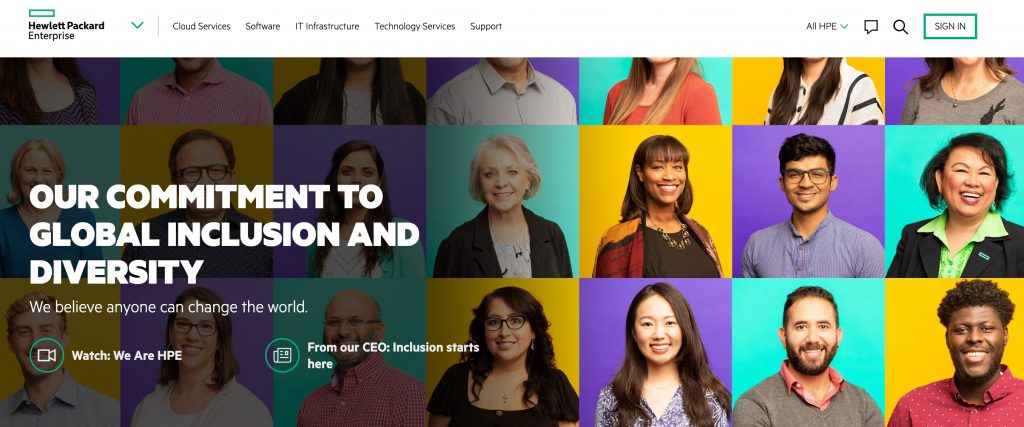
Commitment to diversity headline:
“Our Commitment to Global Inclusion and Diversity. We believe anyone can change the world.”
Commitment to diversity statement:
” Who we are. At HPE, we know that our greatest strengths come from the people who make up our team. So for us, inclusion and diversity is ingrained in who we are today because we know it’s what will get us to tomorrow. But our work is far from over. In fact, we continuously push for better.
What we do. We empower our team members to make an impact on our business and in the world. We foster a culture that is unconditionally inclusive, and in return ask that our people contribute all their differing perspectives, ideas and experiences for one common purpose: to advance the way people live and work.”
Why it’s a great commitment to diversity statement example:
HPE’s commitment to diversity is based on global reach. HPE uses brightly colored employee photos to show its “commitment to global inclusion and diversity.”
Along with the commitment to diversity statement, you can find a link to the company’s diversity video, “ We are HP “, and a letter from CEO Antonio Neri, “ Inclusion Starts Here. “
Kellogg’s
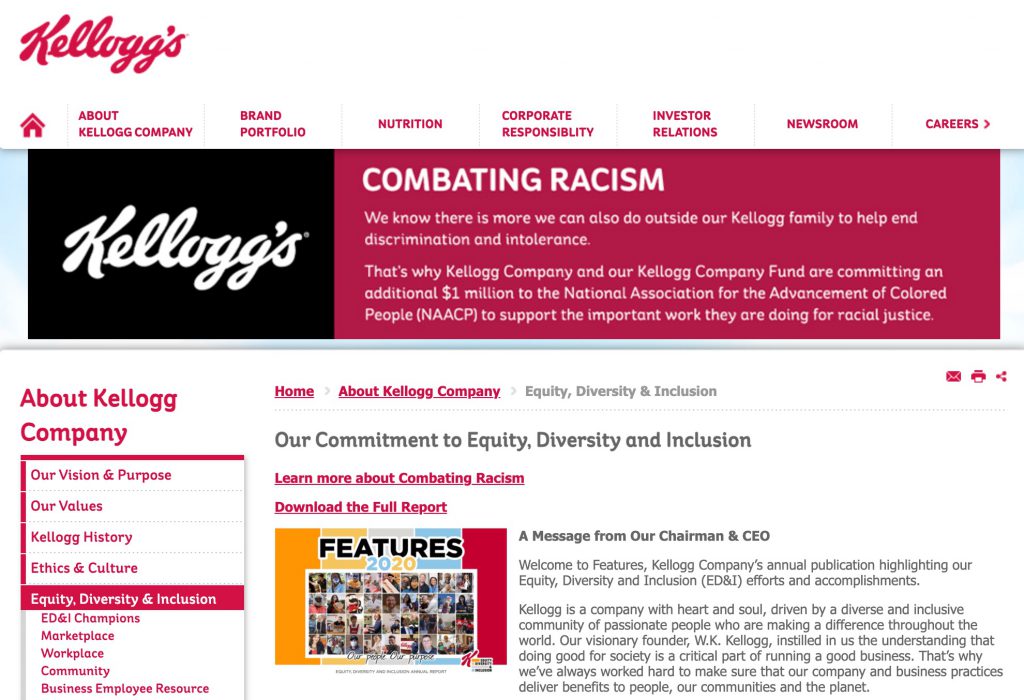
“Our Commitment to Equity, Diversity and Inclusion”
“Kellogg is a company with heart and soul, driven by a diverse and inclusive community of passionate people who are making a difference throughout the world. Our visionary founder, W.K. Kellogg, instilled in us the understanding that doing good for society is a critical part of running a good business. That’s why we’ve always worked hard to make sure that our company and business practices deliver benefits to people, our communities and the planet.
Our company vision is a good and just world where people are not just fed but fulfilled. Our purpose is creating better days and a place at the table for everyone through our trusted food brands. Our strong focus on ED&I is paramount to achieving our success.”
Kellogg’s commitment to diversity, equity, and inclusion starts at the top. Kellogg’s links to a letter from their CEO and shows their commitment to combating racism right at the top of the page.
The red, white, and black box shows Kellogg’s financial commitment of $1 million to the NAACP to support their work for racial justice.
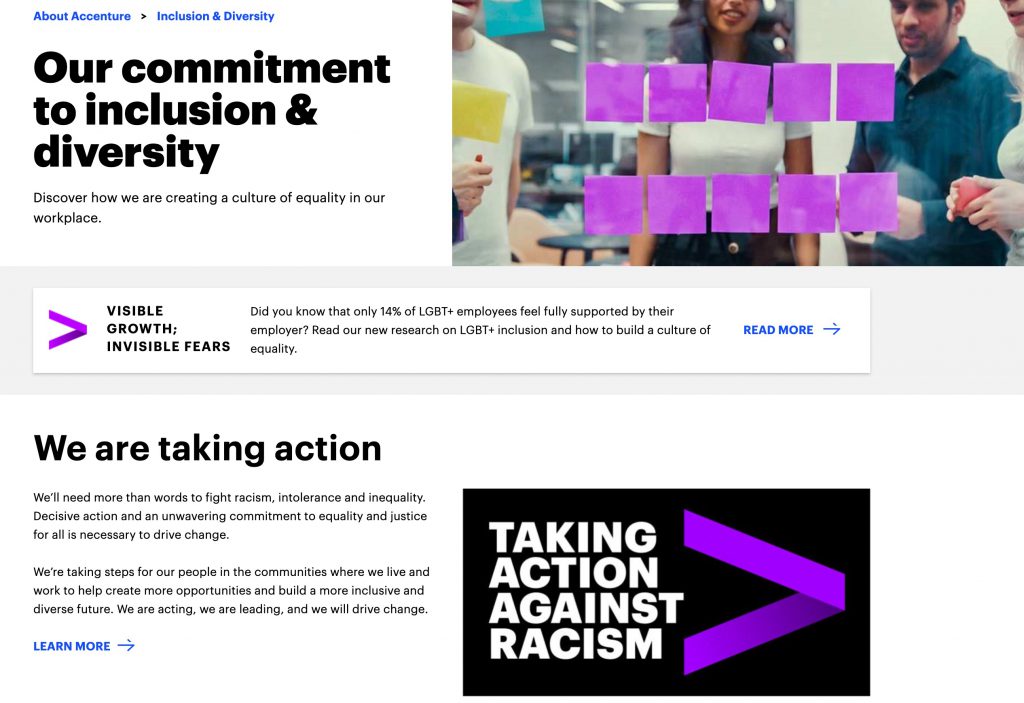
“Our commitment to inclusion & diversity. Discover how we are creating a culture of equality in our workplace.”
“We are taking action. We’ll need more than words to fight racism, intolerance and inequality. Decisive action and an unwavering commitment to equality and justice for all is necessary to drive change.
We’re taking steps for our people in the communities where we live and work to help create more opportunities and build a more inclusive and diverse future. We are acting, we are leading, and we will drive change.”
Accenture’s commitment to diversity & inclusion is great because there is a clear statement of action. Accenture uses bold color blocks and fonts to share its message of taking action against racism , by leading and driving change.
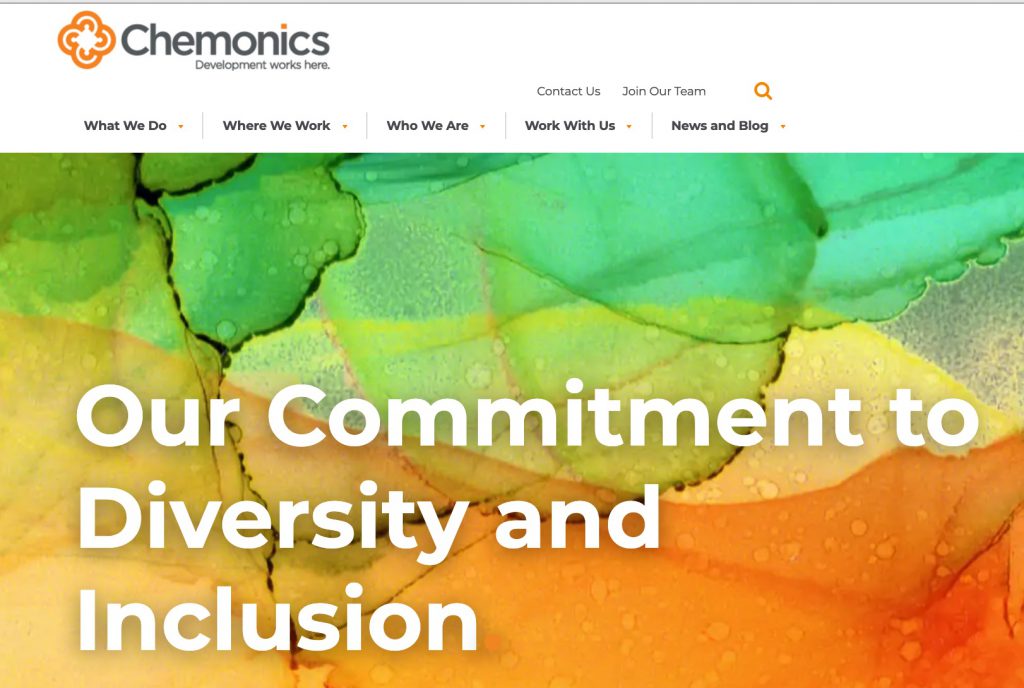
“Our commitment to Diversity and Inclusion”
“We are dedicated to creating an inclusive space for all our employees and extending this culture of inclusion into our work. At Chemonics, diversity and inclusion (D&I) are integral to our mission.
We believe that our workforce should reflect the vast diversity of the communities we serve, and that diverse voices should be elevated and intentionally integrated into our work. We embrace difference and diversity of identity, experience, and thought, and actively strive for inclusive behaviors across our company and our work. By promoting these values, we aim to create a positive work experience that encourages a sense of belonging.”
Chemonics has an excellent statement of commitment to diversity, inclusion, and belonging. They highlight employee resource groups (ERGs) for people with disabilities (ChemABLE), people from the LGBTQ+ community (ChemPRIDE), and military veterans (ChemVALOR).
Chemonics also uses video to share its message about the importance of gender identities and using personal pronouns.
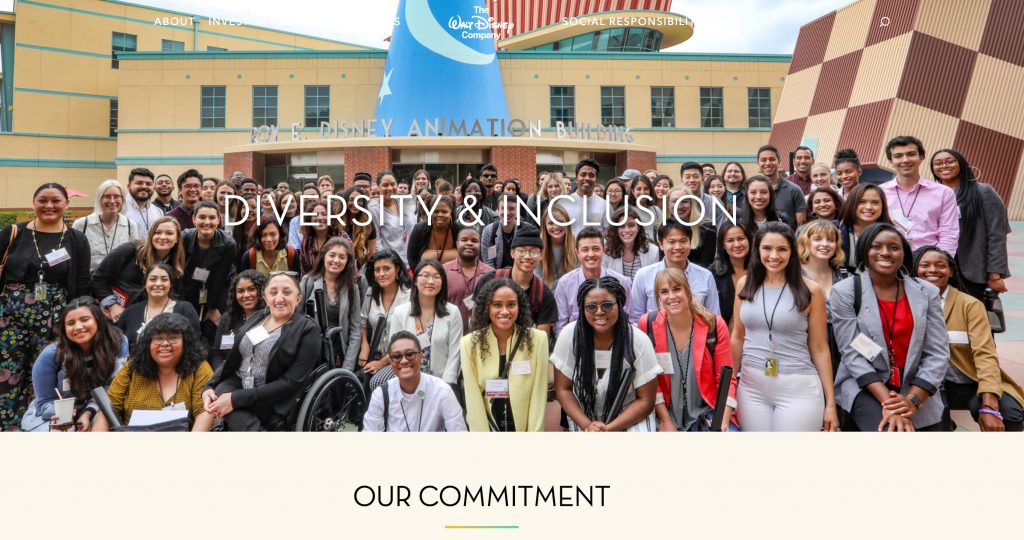
“Our commitment”
“Stories are better when the storytellers represent the vast experiences of the people who will hear them. At Disney we have the opportunity and the responsibility to create authentic, unforgettable stories, experiences and products that capture the imagination of generations of people around the world. We are committed to doing that in a way that counts everybody in.”
The Walt Disney Company’s commitment to diversity and inclusion is all about creating stories and sharing the experiences of generations of people. Disney highlights “impact stories” about its pledge to advance social justice, finding resolve in times of unrest, and earning top marks for LGBTQ equality.
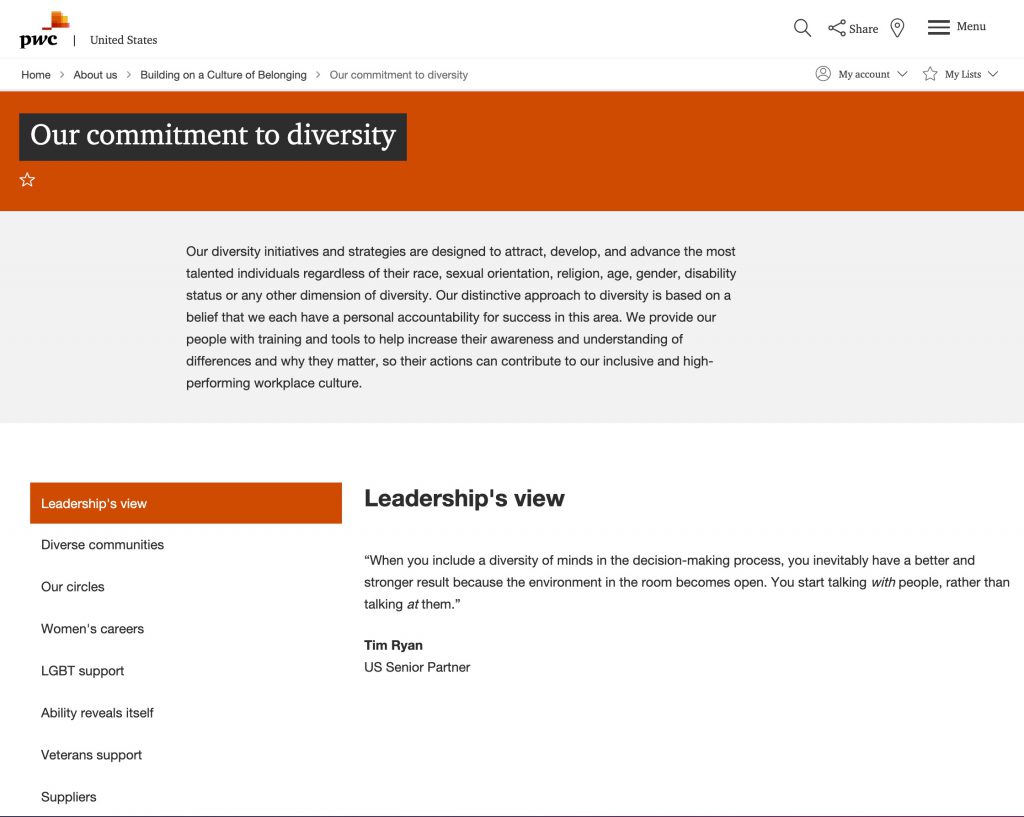
“Our commitment to diversity”
“Our diversity initiatives and strategies are designed to attract, develop, and advance the most talented individuals regardless of their race, sexual orientation, religion, age, gender, disability status or any other dimension of diversity. Our distinctive approach to diversity is based on a belief that we each have a personal accountability for success in this area.
We provide our people with training and tools to help increase their awareness and understanding of differences and why they matter, so their actions can contribute to our inclusive and high-performing workplace culture.”
PwC’s statement of commitment to diversity is not limited to one page. Their diversity commitment page uses an easy-to-scroll menu that shares statements of support for many different groups. For example:
- Leadership’s view
- Diverse communities
- Our circles
- Women’s careers
- LGBT support
- Ability reveals itself
- Veterans support
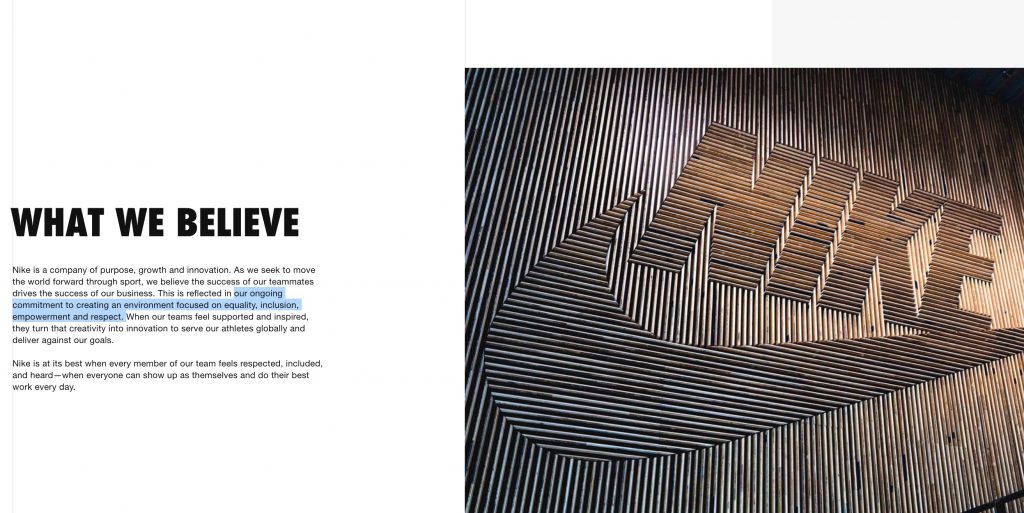
“What We Believe”
“Nike is a company of purpose, growth and innovation. As we seek to move the world forward through sport, we believe the success of our teammates drives the success of our business. This is reflected in our ongoing commitment to creating an environment focused on equality, inclusion, empowerment and respect. When our teams feel supported and inspired, they turn that creativity into innovation to serve our athletes globally and deliver against our goals.
Nike is at its best when every member of our team feels respected, included, and heard—when everyone can show up as themselves and do their best work every day.”
Nike’s commitment to diversity statement is great because it is simple, yet meaningful. It starts with “What We Believe” and as you scroll through the page, you find a list of colorful images showing Nike’s employee-led communities supporting underrepresented groups (e.g., Black Employee Network & Friends, Ability Network, Nike Military Veterans & Friends, Pride Network, and more.)
Harvard Berkman Klein Center for Internet & Society
“Diversity & Inclusion”
The work and well-being of the Berkman Klein Center for Internet & Society are profoundly strengthened by the diversity of our network and our differences in background, culture, experience, national origin, religion, gender, gender identity, sexual orientation, race, ethnicity, age, ability, and more. Working closely with the specialized offices at Harvard University and the Law School, and in collaboration with supporting Foundations, the Berkman Klein Center has taken a multidimensional approach to addressing diversity and inclusion across all areas of work.
Through these and other activities, we actively seek and welcome people of diverse backgrounds, including Black, Indigenous, Asian, Hispanic, and Latino/Latina/Latinx people; LGBTQIA+ people; non-binary people; women; people with disabilities; people at intersections of these identities; and people from and working across the spectrum of disciplines, to serve the mission of the Center and, ultimately, build a better world together.
The center’s commitment to diversity is great because it is specific. There is a long list of underrepresented communities they welcome and focus on being inclusive of.
More examples of a “commitment to diversity” might be found here…
A “commitment to diversity” is just one way companies show their support for diversity, equity, inclusion, and belonging. Here are some other common names for a commitment to diversity statement:
- inclusion statement (see 10 Examples of Awesome Inclusion Statements .)
- diversity statements (see 10 Examples of the Best Diversity Statements )
- diversity mission statement (see Top 10 Diversity Mission Statements )
- corporate culture statement
Why I Wrote This
Ongig’s mission is to transform your job descriptions to attract top-tier and diverse talent. Our Text Analyzer software analyzes every word of your job descriptions to support your commitment to diversity.
March 10, 2021 by Heather Barbour in Diversity and Inclusion
- AI Recruitment (1)
- Applicant Tracking System (16)
- Candidate Engagement (10)
- Candidate Experience (5)
- Company Career Site (42)
- Conferences (18)
- Diversity and Inclusion (247)
- Employee Branding (3)
- Employer Branding (42)
- Employer of Choice (4)
- Entrepreneurship (4)
- Hiring (27)
- HR Content (80)
- Job Boards (2)
- Job Description Management (7)
- Job Descriptions (165)
- Job Pages (3)
- Job Postings (9)
- Job Titles (44)
- Leadership (4)
- Microsites (6)
- Networking (5)
- Recruit Veterans (1)
- Recruiters (18)
- Recruiting Metrics (2)
- Recruiting Process (7)
- Recruiting Software (13)
- Recruiting Strategies (32)
- Recruiting Videos (12)
- Recruitment Marketing (10)
- Recruitment SEO (9)
- Social Recruiting (21)
- Talent Acquisition (9)
- Talent Airport (2)
- Technology (8)
- Trends (11)
- University Recruiting (3)
- Video Job Descriptions (9)
- Writing Job Descriptions (40)
template: single.php


Changing the Story
Your personal diversity and inclusion statement.
As one of the assignments in STOCKSCH 382 – Professional Development in Sustainable Food and Farming, students are asked to write a Personal Diversity and Inclusion paragraph. This is becoming more common among employers as part of a routine job application package. This blog will help you to create your own D & I statement.
Why write a Diversity and Inclusion Statement
Writing a Diversity and Inclusion Statement of your own allows you to clarify your own thinking with respect to these issues in your life and in the work place or school. Many employers are now requiring such a statement as part of a routine job application process. In addition, you may find yourself on a team some day where your workplace is trying to create such a statement. This is good practice!
What is a Diversity and Inclusion Statement or Paragraph
A Diversity and Inclusion Statement may be a long document outlining an individual’s or a group’s commitment to inclusion, equity, justice, and diversity. Writing a long document may, in fact, be easier than constructing a brief (25-75 word) paragraph explaining your experiences and commitment to diversity.
Writing a paragraph forces you to select your words carefully. It is also more useful in a job application. If a potential employer requests a Diversity and Inclusion Statement, you should assume they are committed to the principles of diversity and are looking for someone who would be supportive of that mission. Take this seriously!
Getting Started
Three areas that might be included in a statement are: 1) your values related to diversity, 2) your experiences working with diverse populations if any, 3) your personal experiences of inclusion and exclusion, and 4) your commitment to inclusivity. Before you begin writing, you might want to review your own understanding of diversity and inclusion.
Diversity is about what makes each of us unique and includes our backgrounds, personality, life experiences and beliefs, all of the things that make us who we are . You might consider some factors in the puzzle below….

Inclusion is the practice or policy of providing equal access to opportunities and resources for people who might otherwise be excluded or marginalized, such as those who have physical or mental disabilities and members of other minority groups.

Writing Prompts to Consider
To help you get started, consider a few (not all) of the following:
- What are your most important core values? .
- How important is diversity and inclusion to you personally? .
- Why do you think diversity and inclusion are important in group activities?
- What do you do to make sure others feel included in group activities where you are engaged?
- What elements of your own identity inform your understanding of diversity and inclusion?
- Try to tell your own story
- Write from the heart
- Put “pen to paper” and begin….
And…. yes, its easy to become cynical about this practice when there are so many resources available to tell you how to write a successful statement. Please don’t let this deter you from choosing to be sincere yourself and to…
- Speak from the heart…..
Help Writing Diversity and Inclusion Statements
- 10 “Best” Examples from Business
- How to write a diversity statement
- How to write a D & I statement in higher education
- Sustainable Ag Education Association Statement
- Guidance for writing a Diversity Statement
There are lots of resources online to help you think creatively. Here is a short video to get you started….
If the video does not stream, click: Diversity, Equity and Inclusion video
Share this:
Leave a comment cancel reply, systems thinking for a more sustaianble world.
News and Perspective for the Amherst Community
Creating The Beloved Community - Together
A Fascinating Fungal Fabric and a Humungous Human History
What can we learn today from "Prof Stock"?
Trusted stem cell blog & resources
- Already have a WordPress.com account? Log in now.
- Subscribe Subscribed
- Copy shortlink
- Report this content
- View post in Reader
- Manage subscriptions
- Collapse this bar
- Book a Speaker
Inclusion & Diversity
Stay up-to-date on how inclusion and diversity are shaping workplaces.

IE&D in 2023: Affirmative Action, ‘Woke’ Backlash and Employment Gains for People with Disabilities
In 2023, IE&D withstood several blows that threatened its existence, including the reversal of affirmative action and the rise of an anti-IE&D movement.
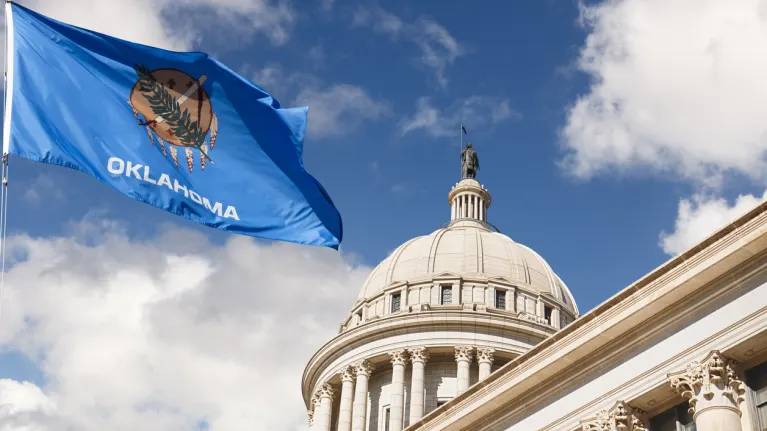
Oklahoma Governor Signs Anti-IE&D Law, Compromising IE&D Efforts Statewide
Gov. Kevin Stitt signed an executive order on Dec. 13 that requires all state agencies and public colleges to report how much they spend on inclusion, equity and diversity (IE&D) programs. The order aims to provide protections for Oklahomans and their tax dollars against such programs.
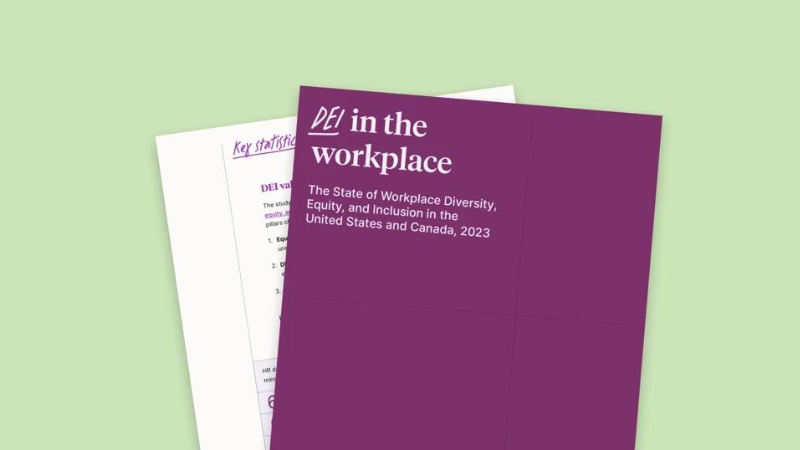
DEI Report: The State of DEI in the Workplace

Whole Foods Ban on Black Lives Matter Logo Is Lawful, NLRB Judge Rules
Whole Foods can continue its practice of disciplining workers for wearing Black Lives Matter (BLM) logos at work. An administrative law judge for the National Labor Relations Board ruled that wearing BLM apparel wasn’t legally protected activity.

Disability Inclusion Makes Financial Sense, Report Finds
Companies that implement disability-inclusive policies and practices tend to outperform their peers financially, according to a new study of 346 companies. The reported noted that employers can create a more disability-inclusive environment in five simple ways.

10 Tips for Improving Workplace Inclusion
While many businesses focus on boosting workplace diversity, their inclusion efforts fall behind. With 2024 on the horizon, workplace and inclusion experts have offered recommendations for strengthening inclusion in the workplace.

How to Create a More Inclusive Workplace for Employees with Deafness and Hearing Loss

Report: Long Work Hours Lead to Burnout, Not Productivity
Your employees may be putting in time beyond the normal workday, but that doesn’t mean they’re more productive, a new global survey found. Meeting fatigue and the relentless tide of email cut into the time workers have for focusing on their tasks.
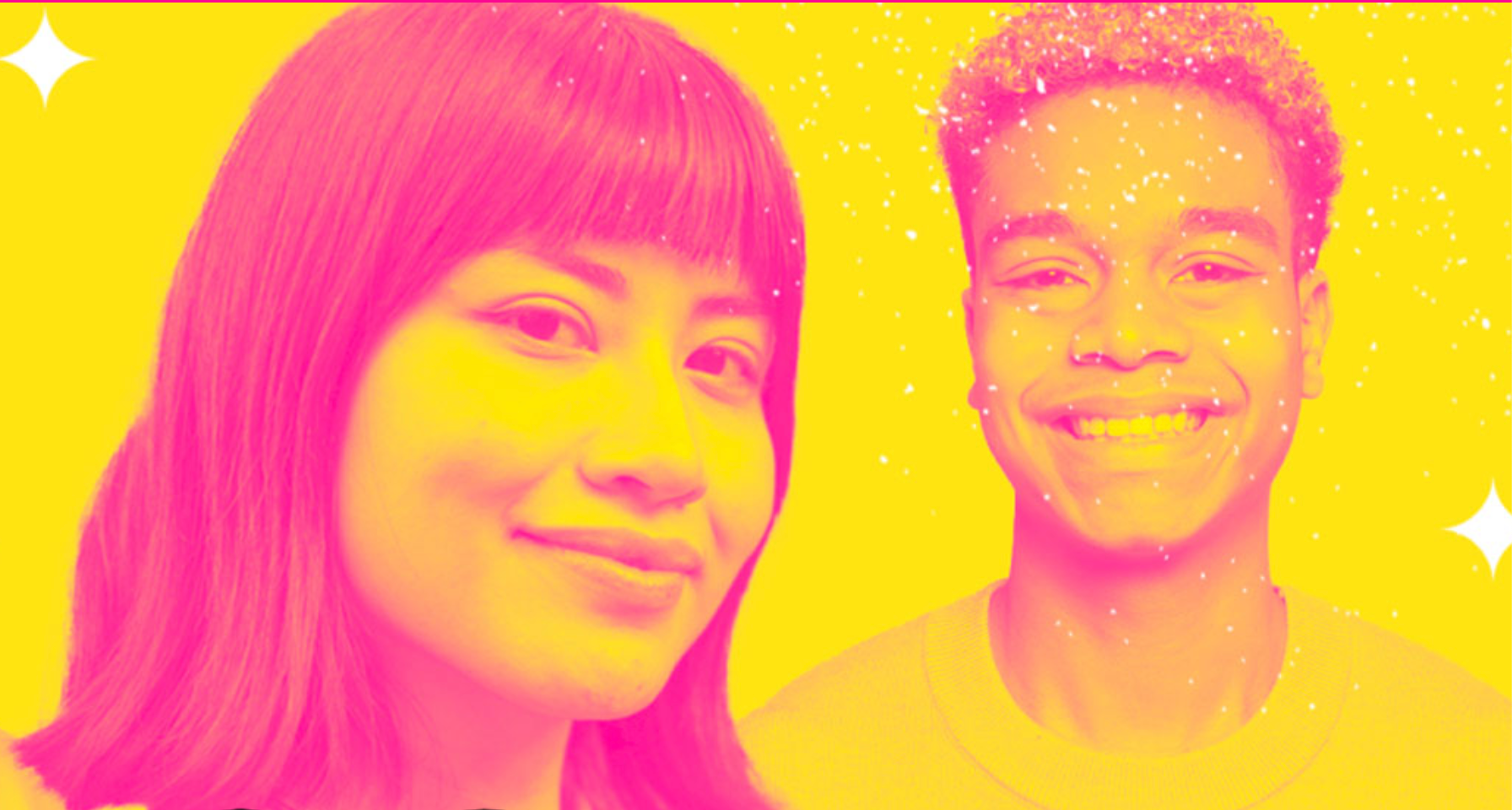
Learn How to Encourage, Energize and Elevate I&D Initiatives in Your Workplace.
There’s a reason why the SHRM INCLUSION conference has sold out the last two years. The HR industry has recognized it as a catalyst that brings together an incredibly diverse group of attendees, speakers, thought leaders and solutions providers who all have the same goal: to protect, prioritize and (em)power the workforce to create better workplaces where all employees act with civility, are made to feel as if they belong and have opportunities to thrive.
Member Resources
Ensuring workplace inclusion for lgbtq+ employees.
This toolkit provides information and resources to help employers create a workplace that values the differences among individuals and where people can feel comfortable bringing their full selves to work.

Inclusion Code of Conduct
A sample policy for employers committed to fostering employee inclusion in the workplace.
How to Talk About Race with Your Employees
Employers can bolster their diversity, equity and inclusion efforts by providing a safe space for workers to have respectful and honest conversations.
What is meant by 'belonging' in the workplace, and how can it be measured?
Inclusion, equity and diversity all relate to the actions an employer takes to help bring about a feeling of belonging for its employees.

Navigating Religious Beliefs in the Workplace
This toolkit provides an overview of the legal framework in which employers must navigate religion in the workplace and also discusses the opportunity to provide a welcoming and inclusive workplace as a major factor in attracting and retaining top talent.

Recognizing Hidden Bias
This sample presentation is intended for delivery to supervisors and other individuals who manage employees. It is designed to be presented by an individual who has knowledge of the concepts and best practices regarding unconscious bias in the workplace.
Recommended by SHRM
IE&D Newsletter
The latest news about inclusion, equity and diversity, delivered the 1st Monday of each month.
Success title
Success caption

IMAGES
VIDEO
COMMENTS
Diversity statements have become an integral part of the materials submitted as part of an application for employment. They are just as important as the resume, cover letter and writing sample. A diversity statement is a personal essay that is a depiction of your past experiences and explains how these experiences have contributed to your ...
Company Diversity Statement Headline: Diversity & Inclusion at Hilton. Sub-Headline: We are diverse by nature and inclusive by choice. Diversity is at the core of our Vision, Mission, and Values. We are committed to an inclusive workforce that fully represents many different cultures, backgrounds and viewpoints.
9 Inspiring diversity and inclusion statement examples. Let's take a deeper look at the examples selected of companies' diversity and inclusion statements. 1. Workday. Workday's D&I statement: Value inclusion, belonging, and equity.™. "Our approach to diversity is simple: it's about embracing everyone.
A diversity personal statement allows you to share your personal experiences and perspectives on the subject. Your statement must be clear and exciting enough to move the reader to action. Here are some tips for writing a solid and effective diversity and inclusion personal statement: 1. Start by Reflecting on Your Experiences With Diversity ...
It may be your first time writing a diversity statement and you may have no idea where to start. Luckily, we have compiled a list of 5 tips to help you get started! 1. Do some background research! Terminology - Here are some words to consider learning about before you start writing: diversity, equality, equity, inclusion, social justice.
A diversity statement is a powerful personal essay that ...
A diversity statement is a polished, narrative statement, typically 1-2 pages in length, that describes one's accomplishments, goals, and process to advance excellence in diversity, inclusion, equity, and belonging as a teacher and a researcher in higher education. ... "regardless of personal demographic characteristics." Beware of false ...
But we've developed a 3-part framework that will help you broaden your thinking about diversity so that you can write a persuasive diversity personal statement, even if you are from an overrepresented group. 3 IDs of Diversity. • ID entity. • I D ids or deeds. • ID eas. Identity who you are: This is the most commonly thought-of form of ...
Real-World Diversity Statement Examples. Now that all of those details are out of the way, let's take a look at some diversity statement examples to give you a better idea of how they look in real life. 1. Google. "At Google, we don't just accept difference - we celebrate it, we support it, and we thrive on it for the benefit of our ...
How to address Diversity Statement questions. Questions about diversity can be overwhelming. However, they all boil down to two objectives: 1) demonstrate the diversity you would bring to the student body and 2) explain how you address diversity, equity, and inclusion in your own life. For the first part, you'll want to discuss the diversity ...
How To Write a Statement of Commitment to Diversity and Inclusion (D&I) Speak your company's truth, then work the plan. 10'000 Hours / Getty Images. Businesses that embrace diversity and inclusion (D&I) can improve financially and attract valuable talent. Learn how to set the tone with a D&I statement of commitment.
Adapting your Statement for a Job Application. After you have developed a statement that reflects your strengths and experiences related to diversity, inclusion, and equity, you may wish to tailor it for individual job applications. Be sure to do your homework about diversity-related programs and resources at the schools to which you are ...
The diversity statement is a relatively new addition to the job application portfolio. It tends to be a one- to two-page document that explains your experiences with and commitments to diverse populations of students. A university that seeks this statement from applicants is typically concerned with ensuring that faculty hires are familiar with ...
A diversity statement outlines how a candidate will contribute to an institution's approach to diversity, equity and inclusion (DEI). It's an opportunity for you to highlight the ways you would advance an institution's DEI work. ... Personal examples or experience: Provide evidence of your commitment to DEI by describing what you've done in the ...
Writing an Effective Diversity Statement. The resources below were designed by the University of California system to support efforts to write and analyze diversity statements in a faculty search process. Diversity statements typically do one or more of the following: Give examples of a candidate's past contributions to diversity
Your diversity, equity, and inclusion statement is an opportunity to change your organization's mindset, behaviors, and outcomes. An effective DEI statement offers a clear path to embracing diverse voices and talent. An effective DEI statement is the first step toward creating an inclusive culture that celebrates all dimensions of diversity ...
A DEI statement needs to address the following topics: Your knowledge about matters of diversity, equity, and inclusion. Your past experience with activities emphasizing diversity, equity, and inclusion. Your future plans for promoting diversity, equity, and inclusion, particularly in your classroom and lab.
In fact, we wrote a blog a few years ago on when you should write a diversity statement. We hope these examples are helpful! Example 1. Living in the bubble of suburban [City], my family was treated like a blemish on its pristine surface. A house with a black father and white mother, along with a handful of mixed kids, easily stood out in our ...
Step 2: Write the statement. Based on our examples, you can see that DEI statements generally range in length from 50-100 words. While the content of each statement varies, there are some common threads running through several of them. Commitment - Each company expresses a commitment to diversity.
Writing a Diversity Statement. Diversity statements have become integral in the job application process. They are being asked for alongside a resume, cover letter, and writing sample. A diversity statement is a personal writing sample that is an illustration of your past experiences and explains how these experiences have contributed to your ...
I found the below 7 examples of a great commitment to diversity statement. These companies stand out because they: Show action — (e.g. Accenture is taking action against racism) Elevate underrepresented groups — Chemonics spotlights personal pronouns and gender inclusion. Share impact — Walt Disney Company highlights its impact of sharing ...
A personal diversity statement helps you keep track of the work you have done, are doing, and plan to do in the future. So often this work is done "in the background." It isn't documented the way we do research, curriculum or work histories. Yet, it is just as important. Your personal statement gives your diversity work the prominence it ...
Getting Started. Three areas that might be included in a statement are: 1) your values related to diversity, 2) your experiences working with diverse populations if any, 3) your personal experiences of inclusion and exclusion, and 4) your commitment to inclusivity. Before you begin writing, you might want to review your own understanding of ...
Inclusion, equity and diversity all relate to the actions an employer takes to help bring about a feeling of belonging for its employees. (opens in a new tab) Toolkit